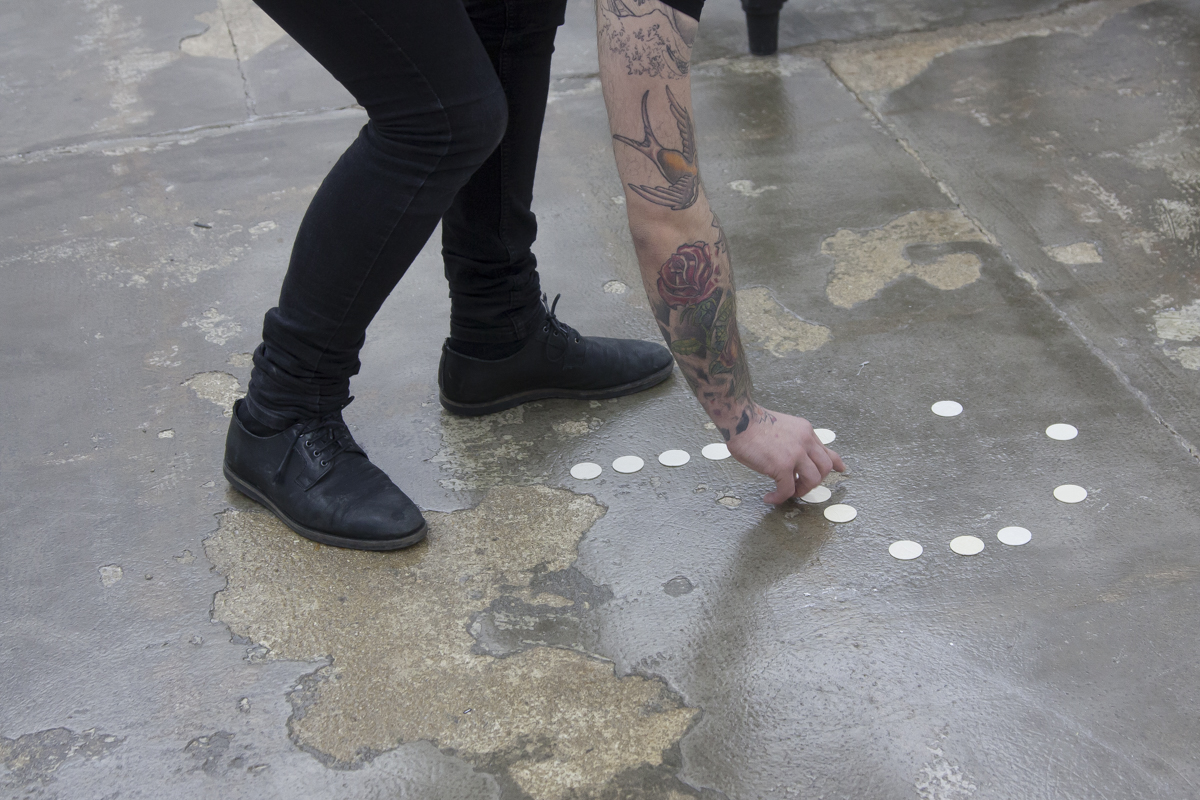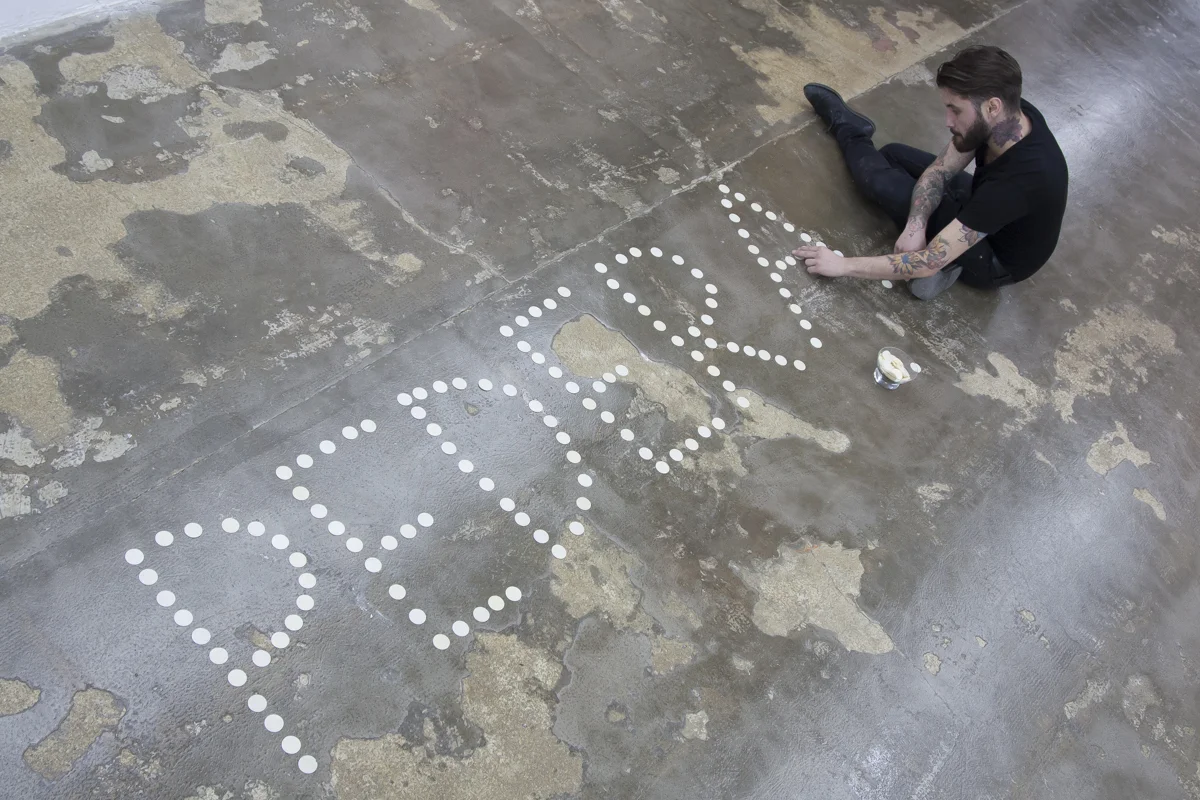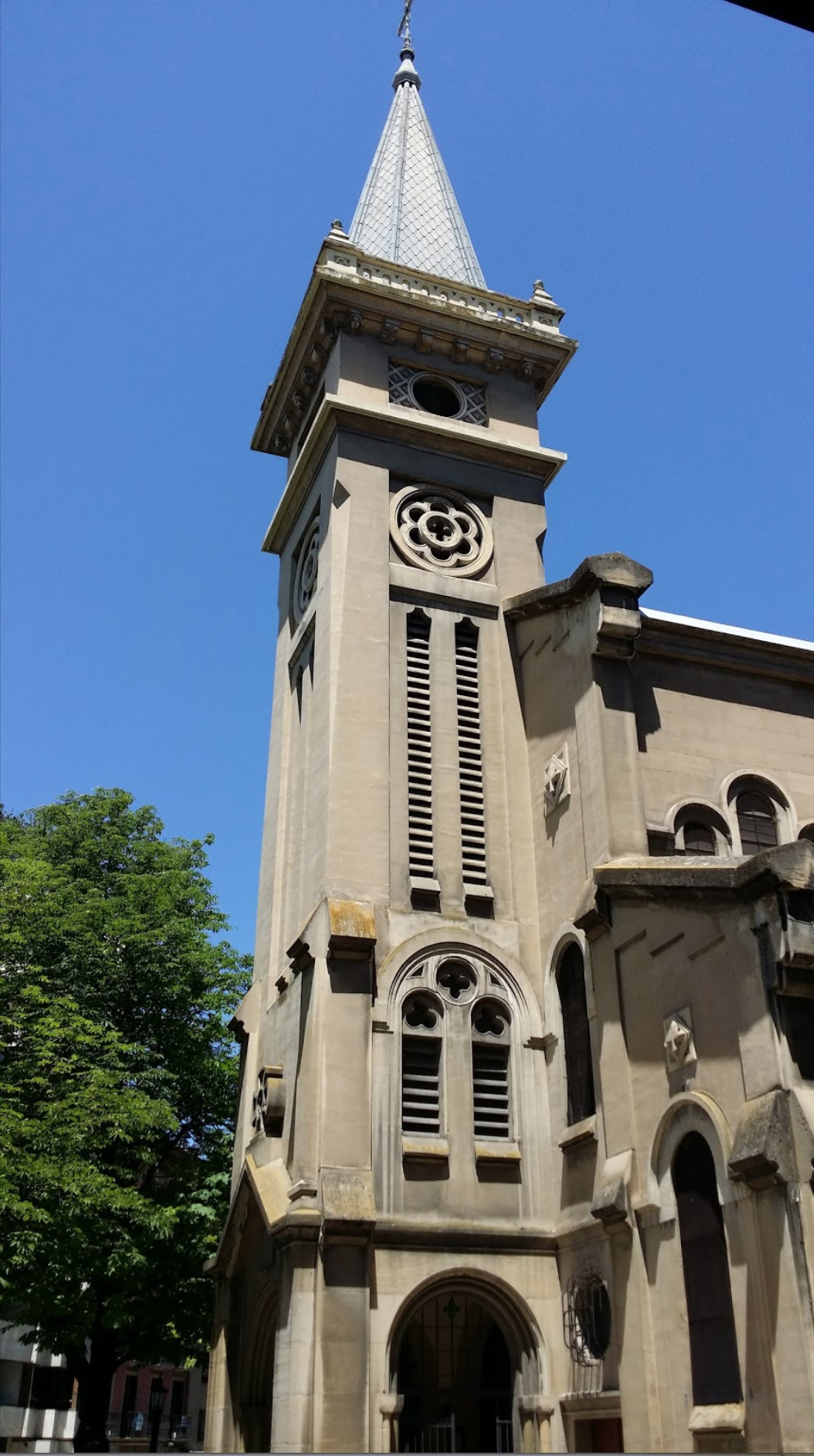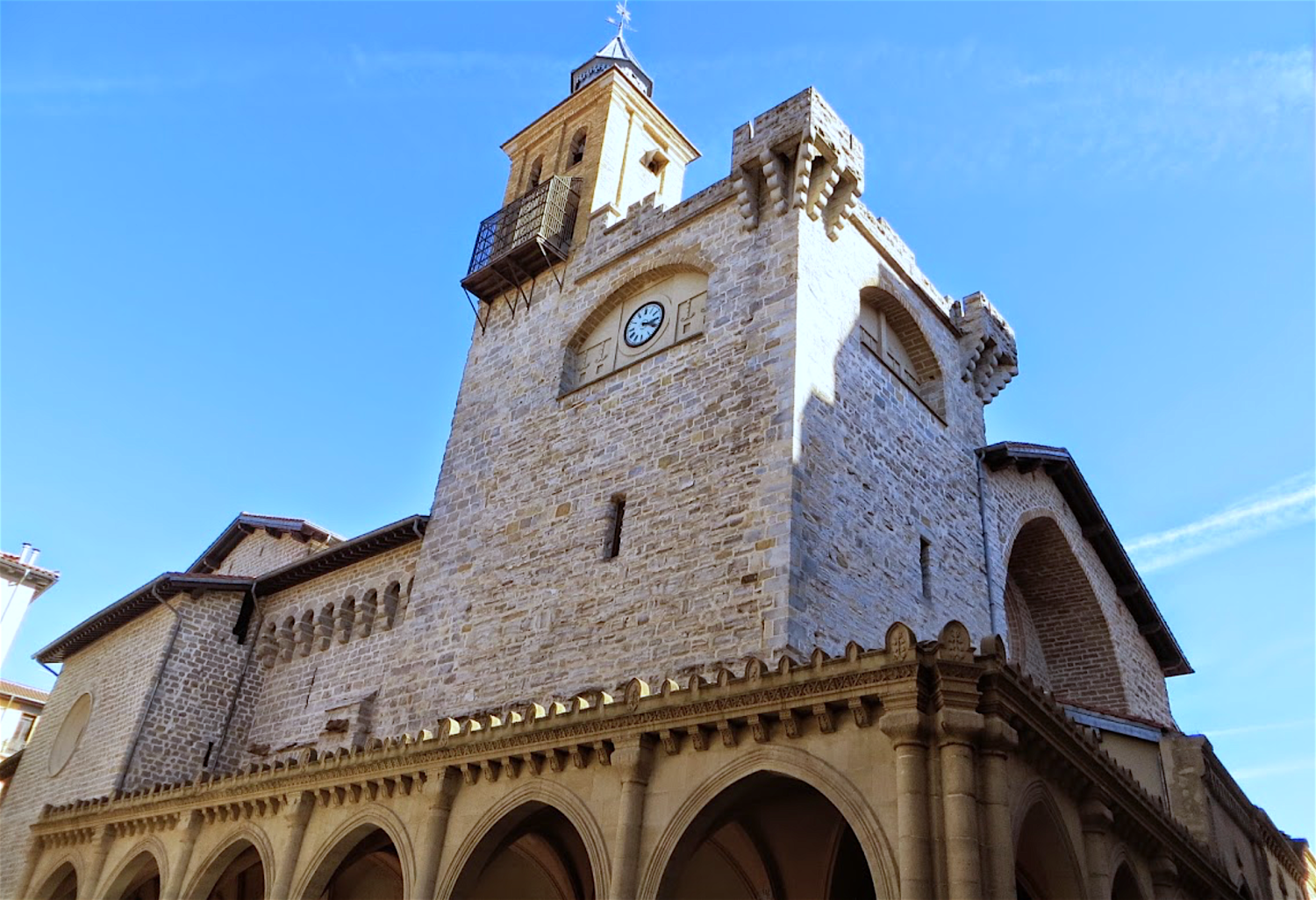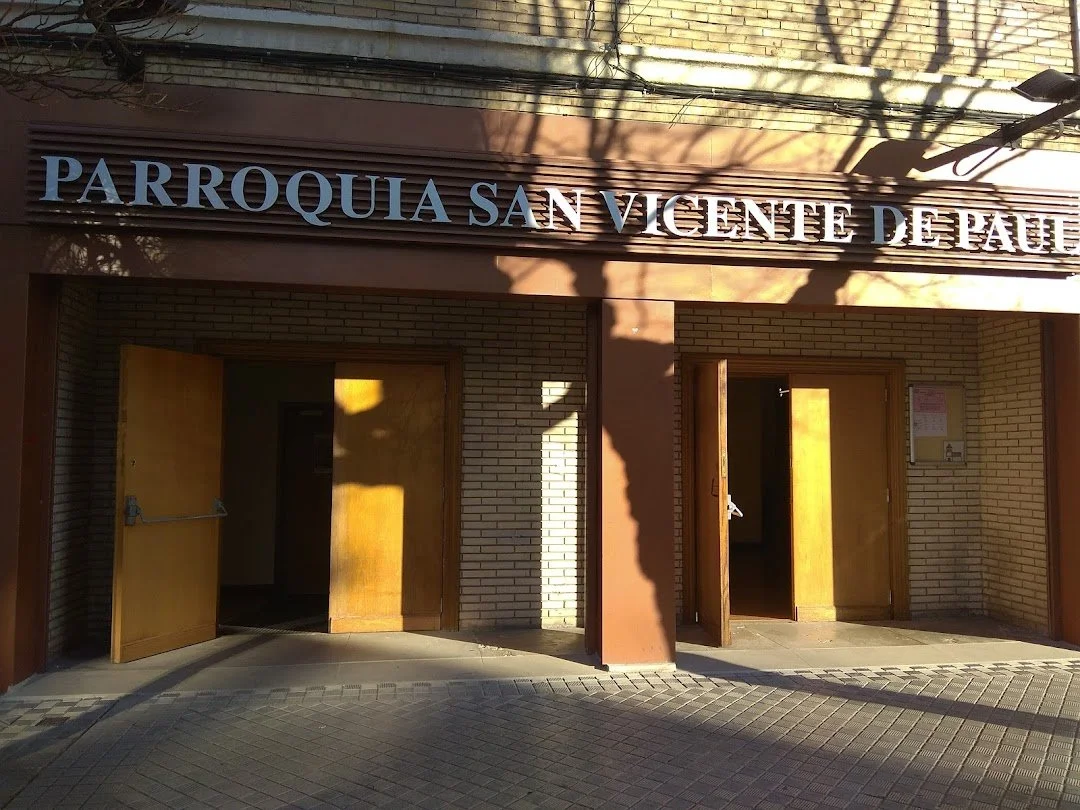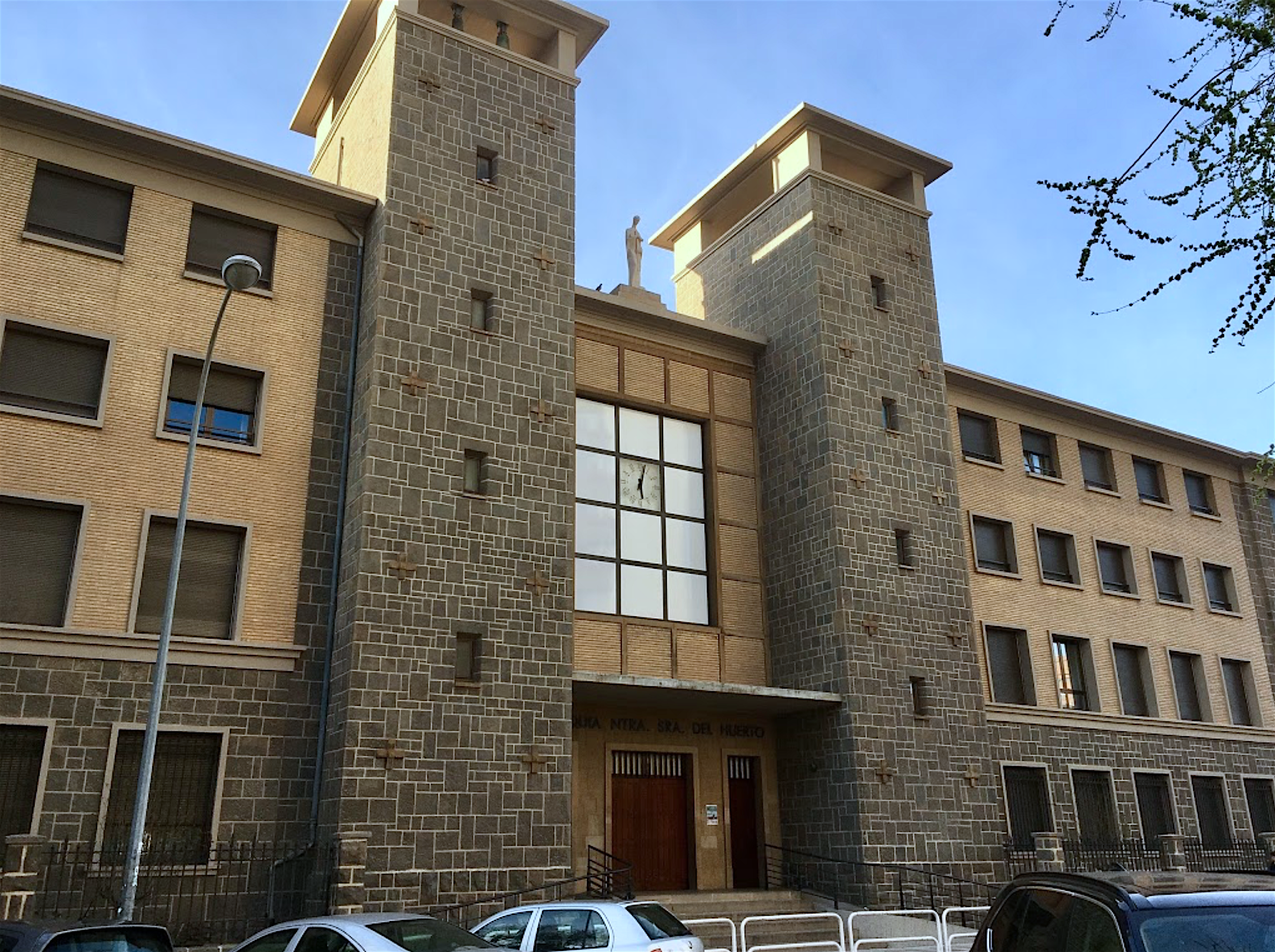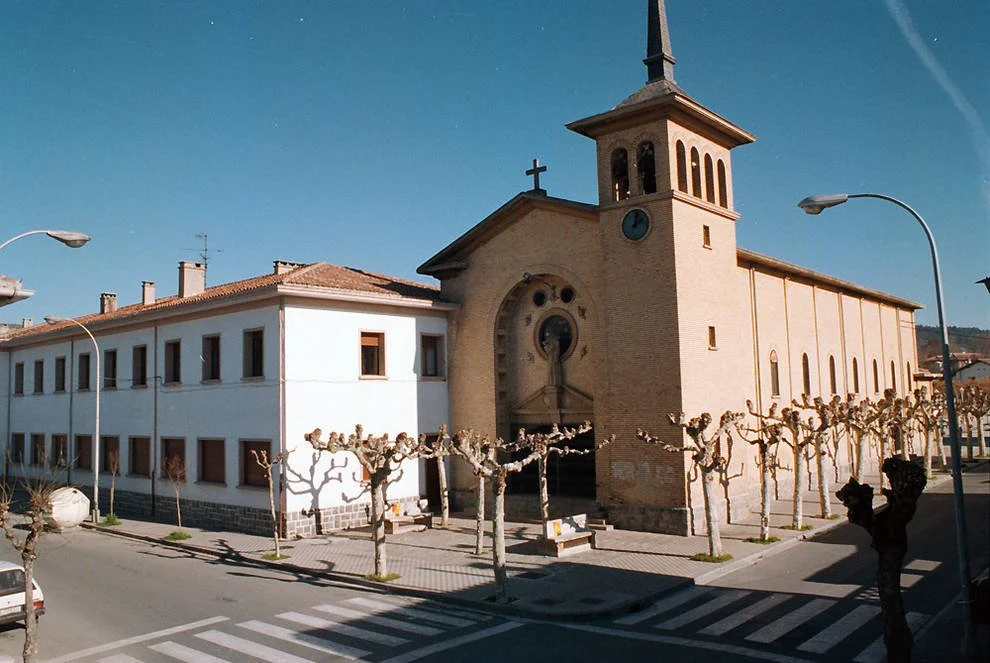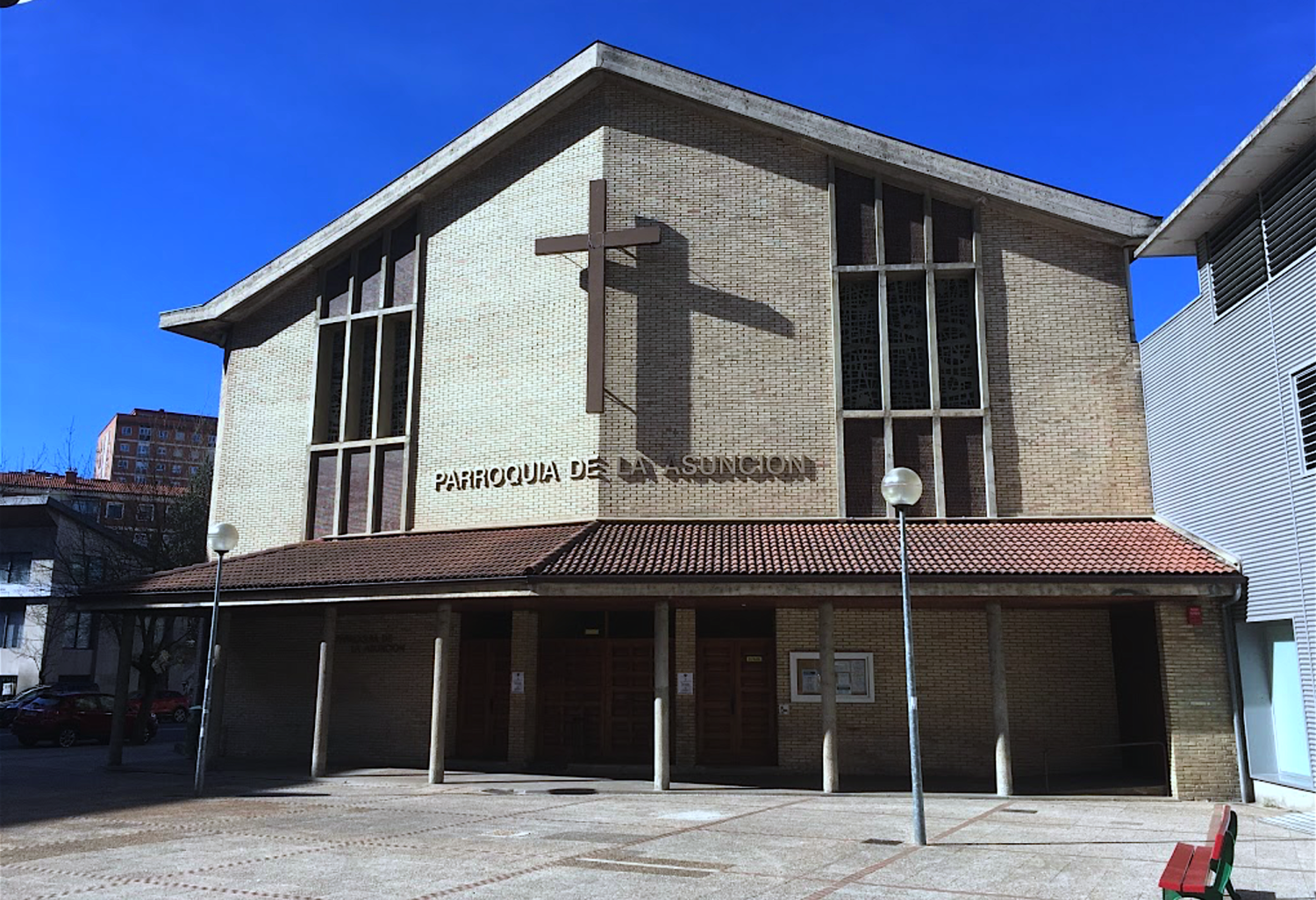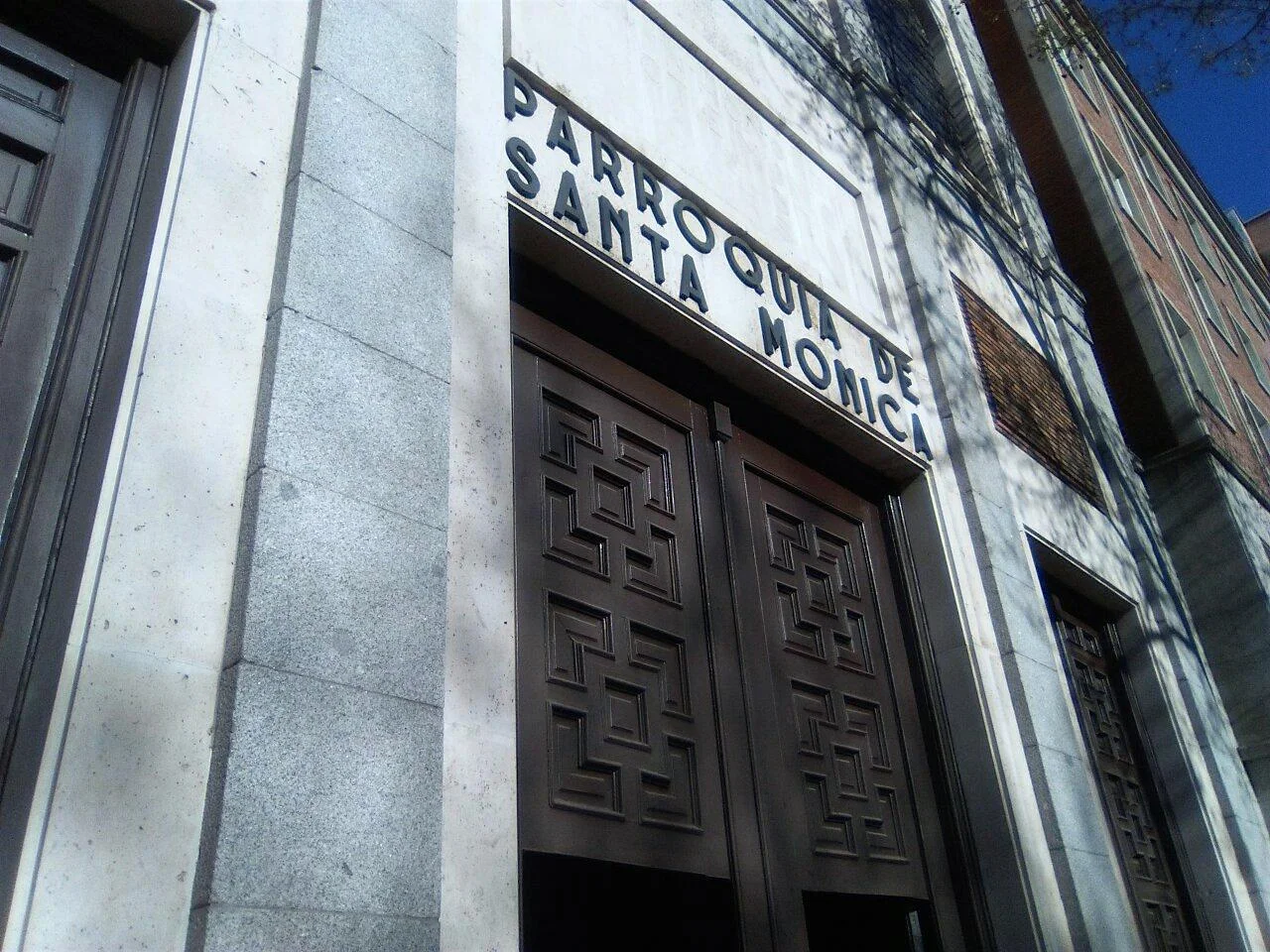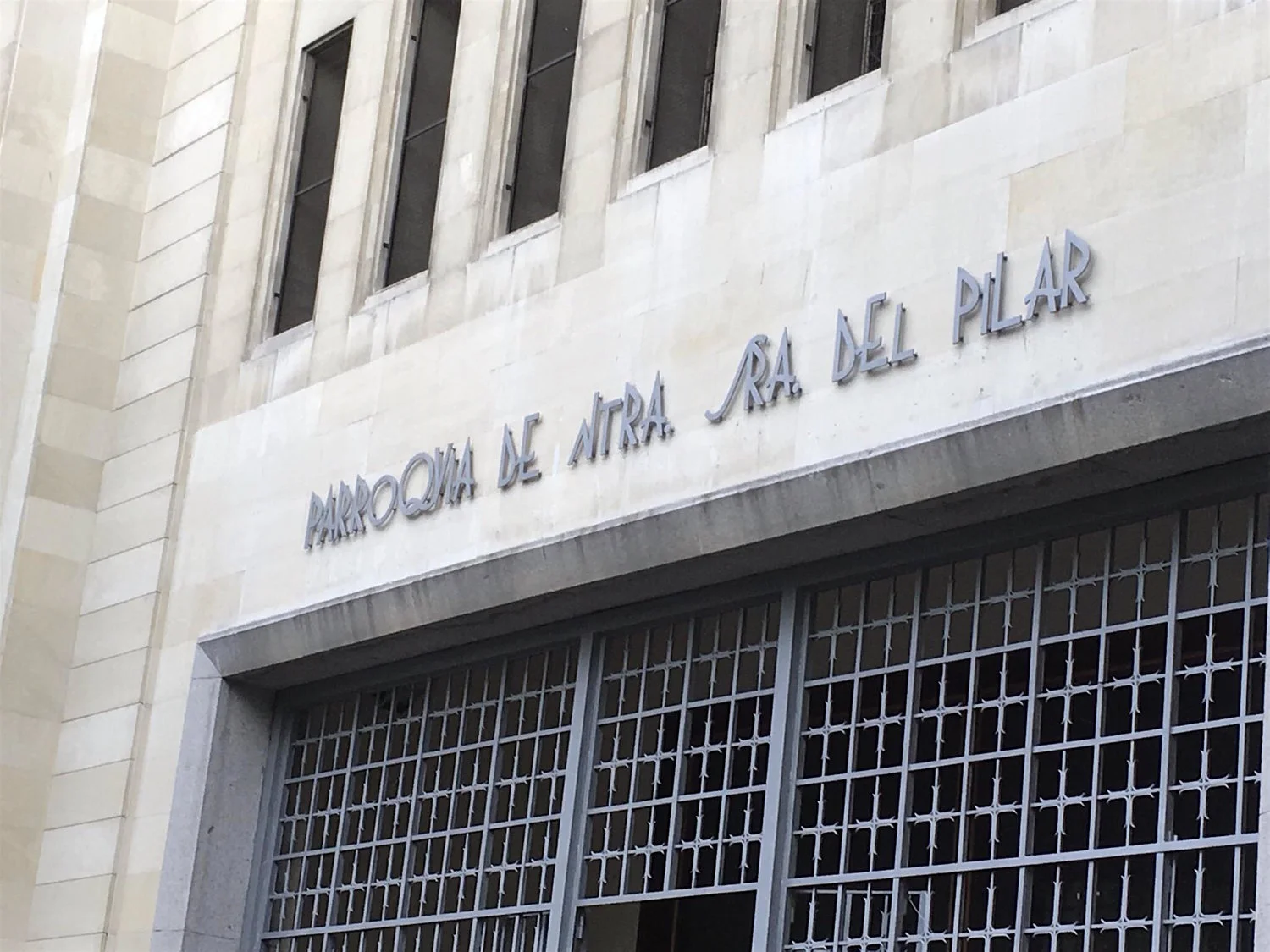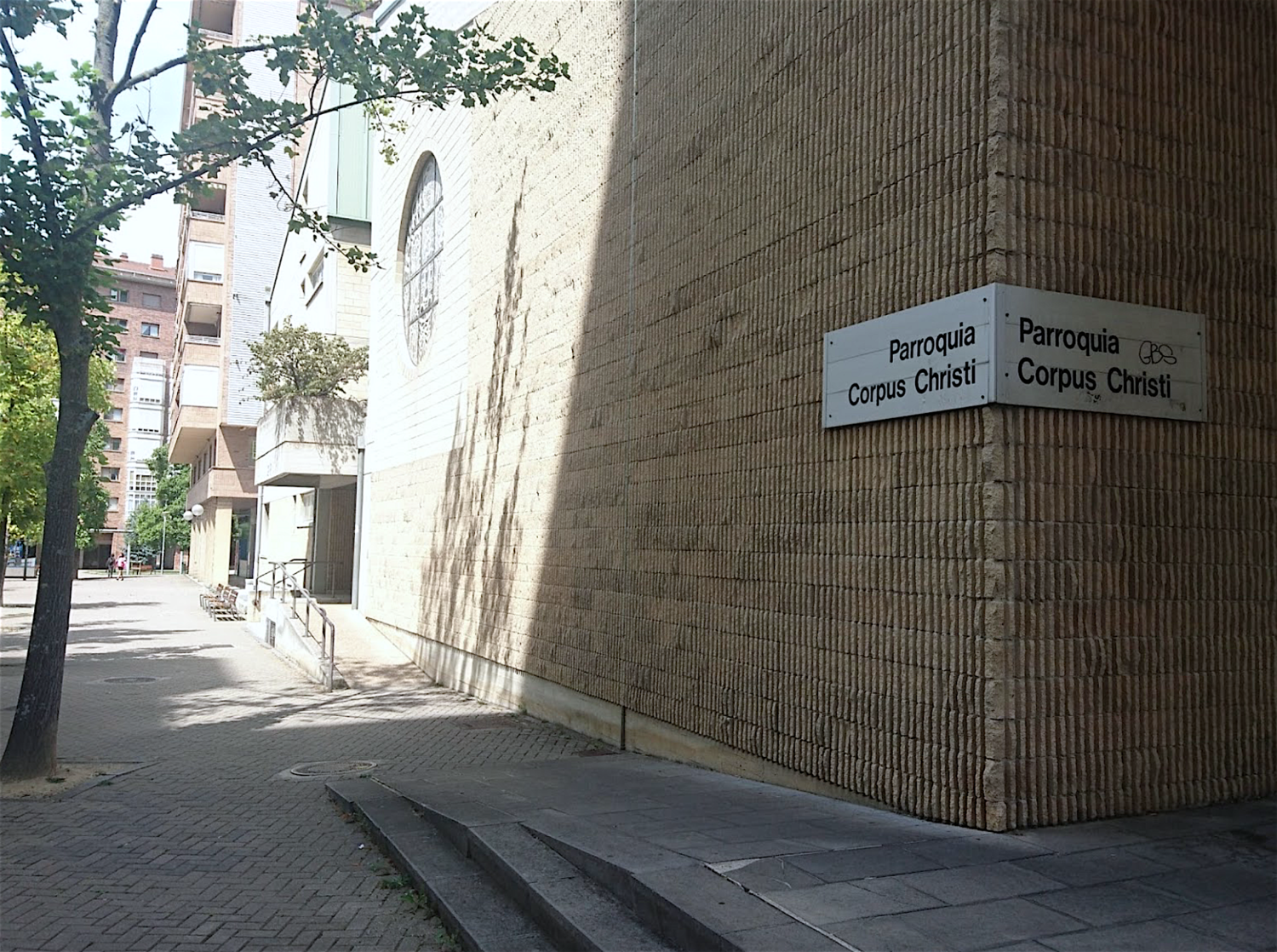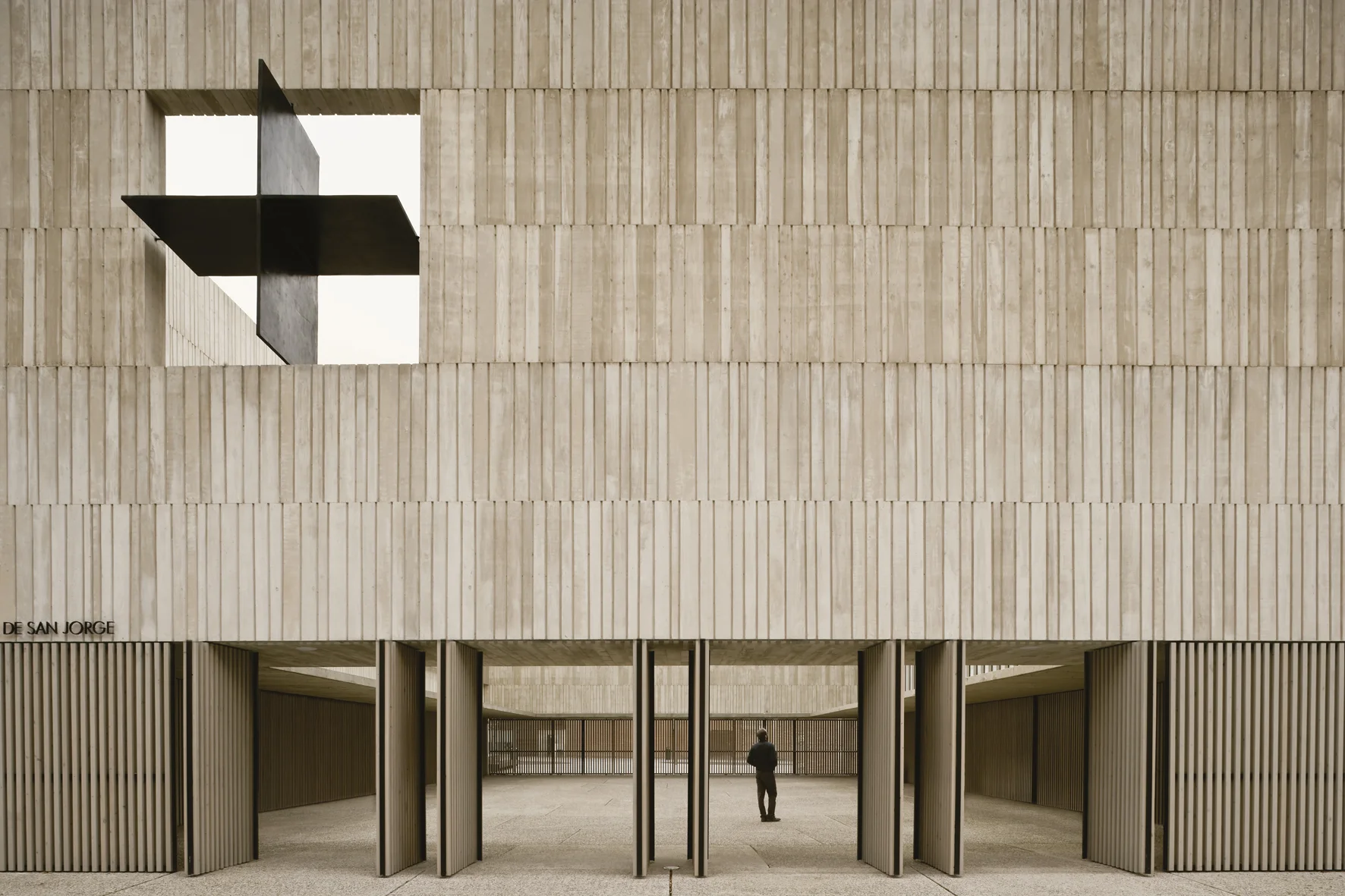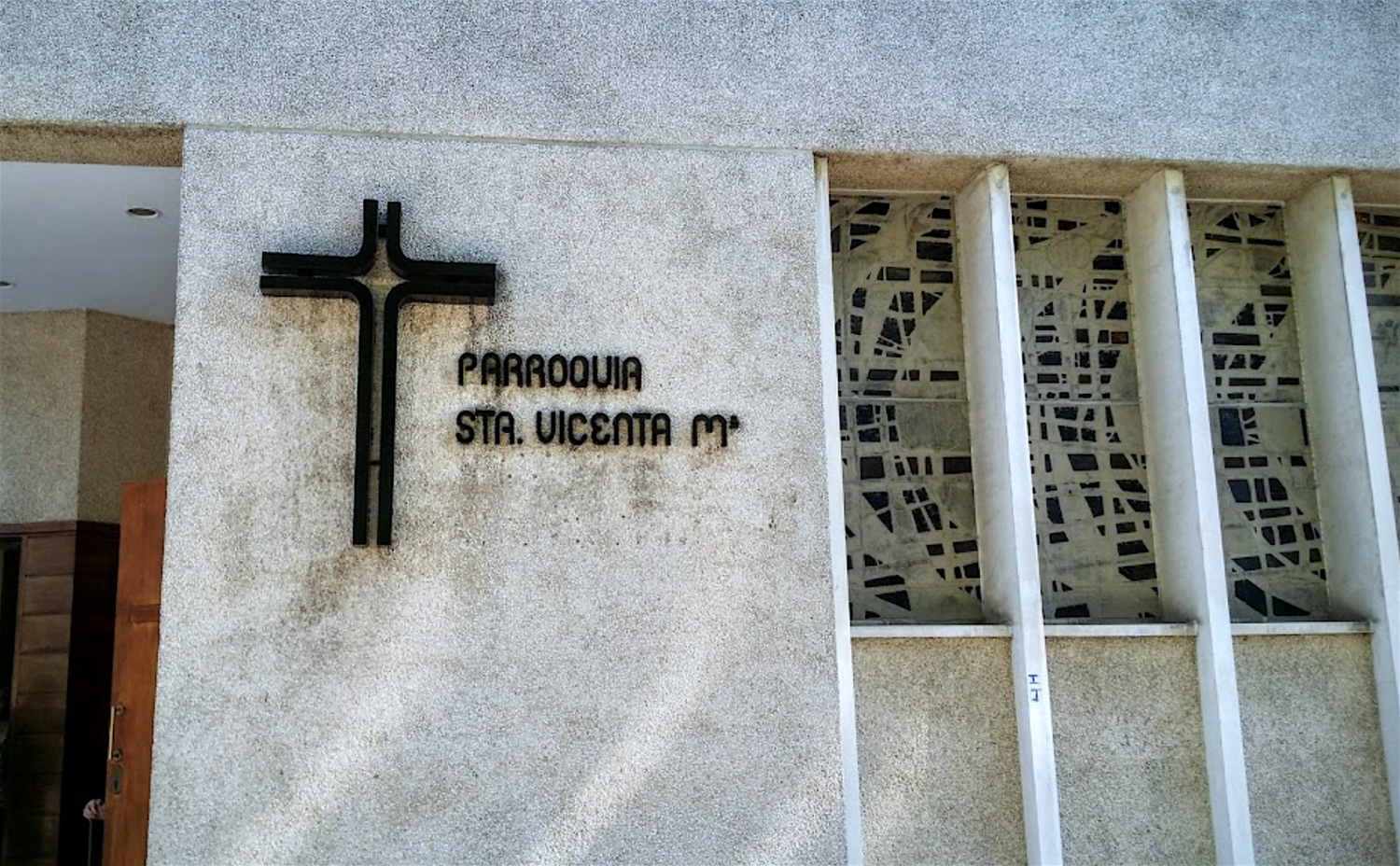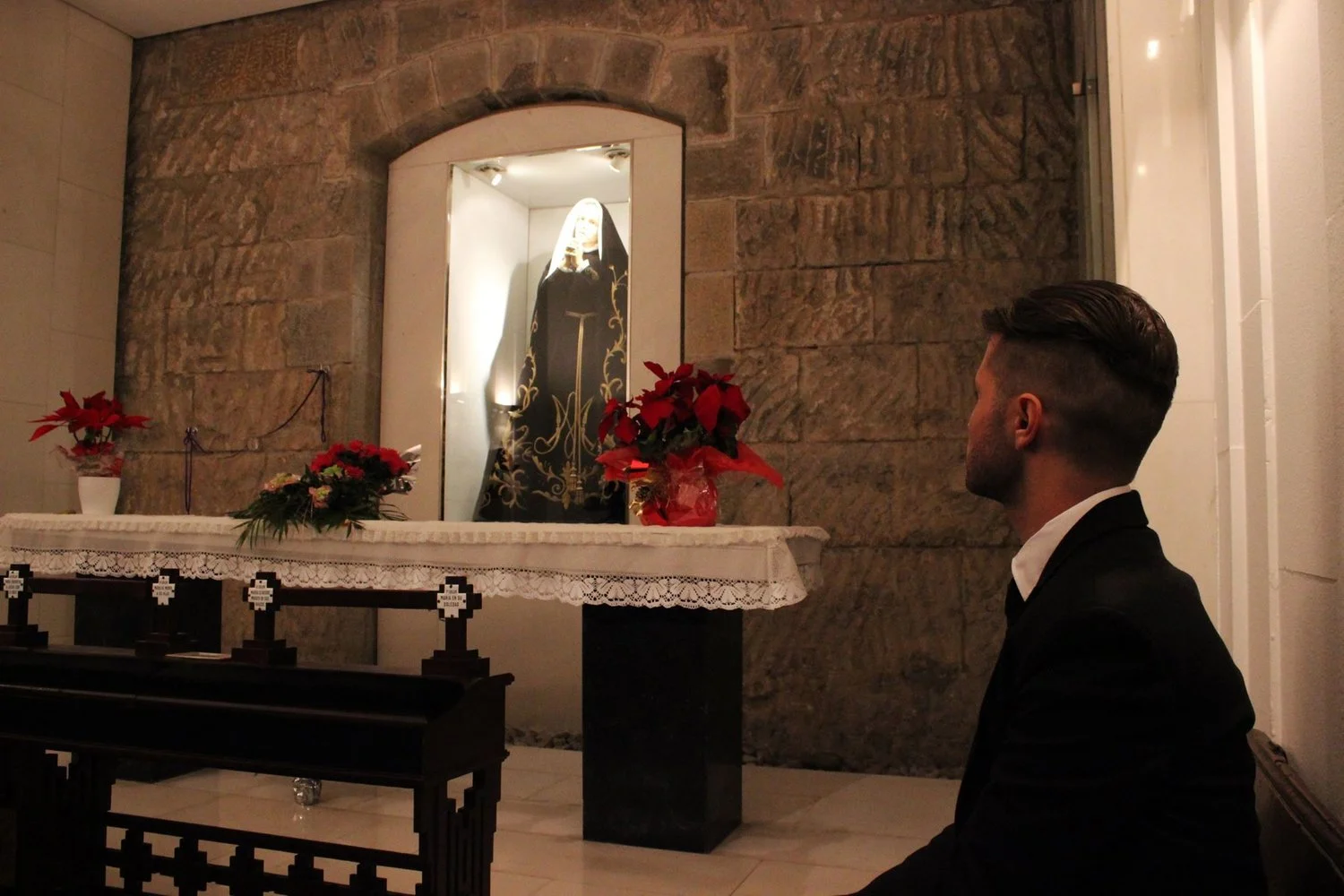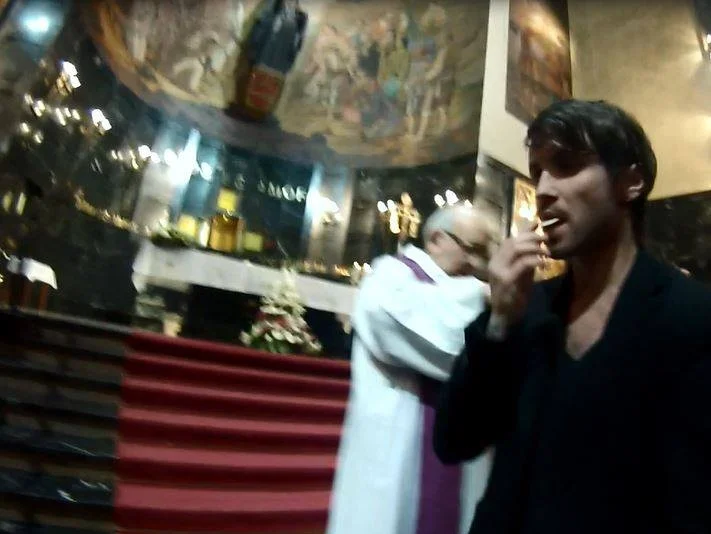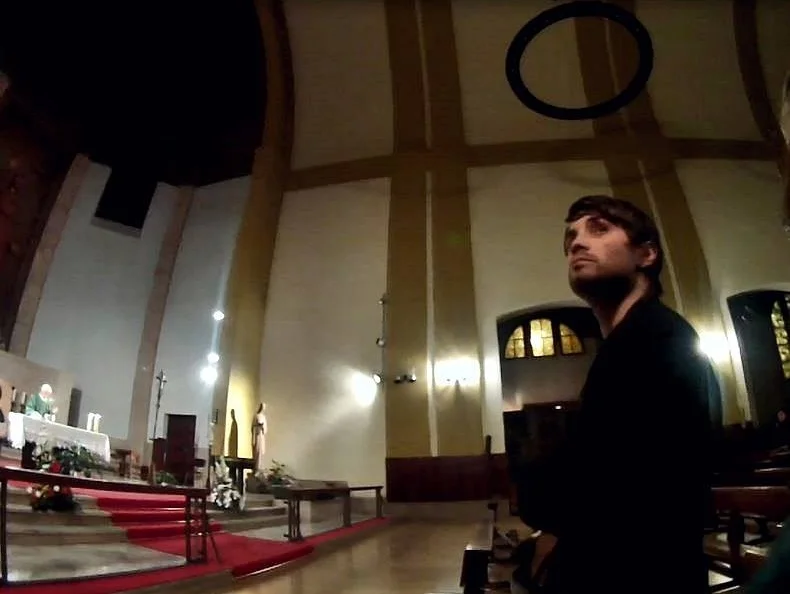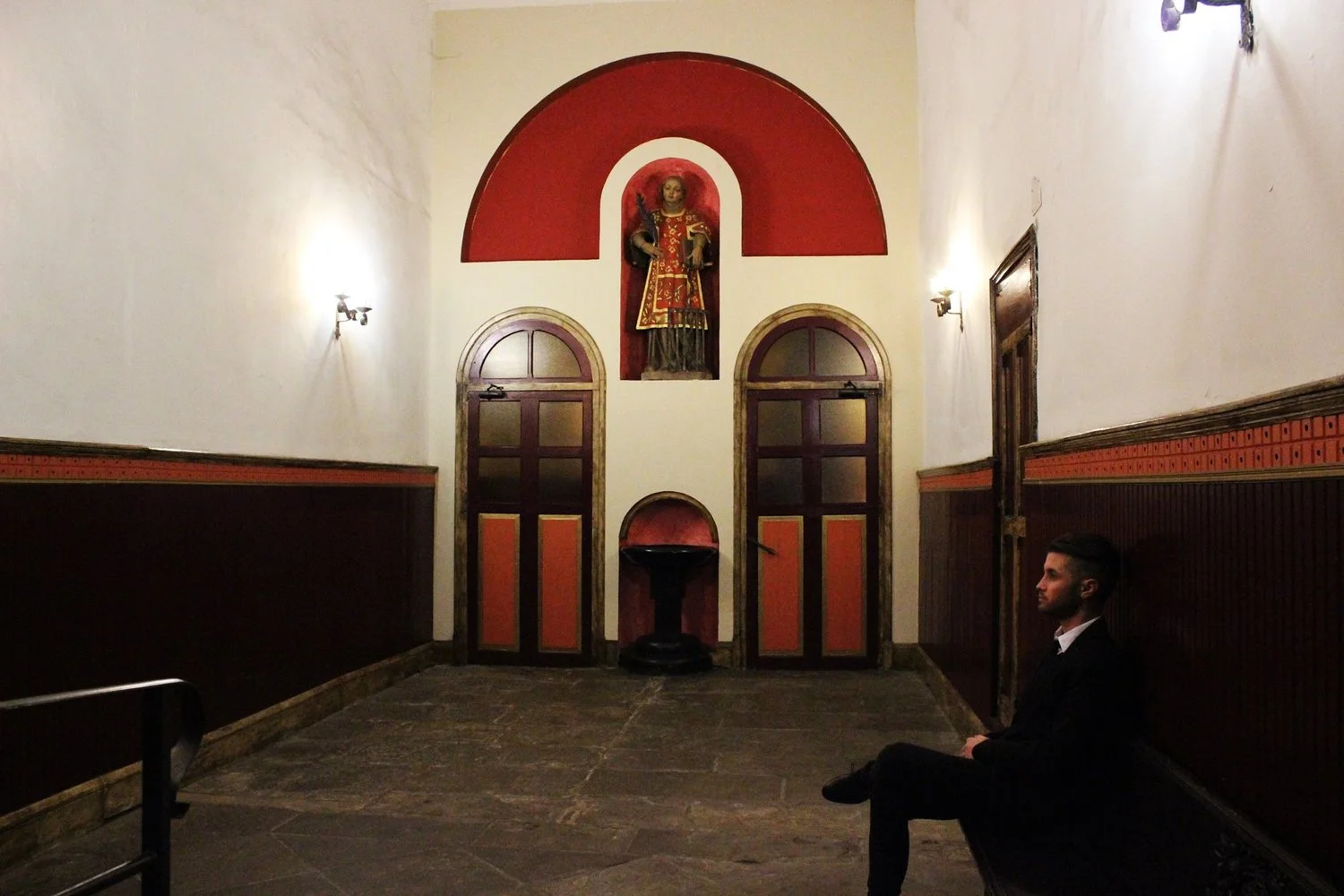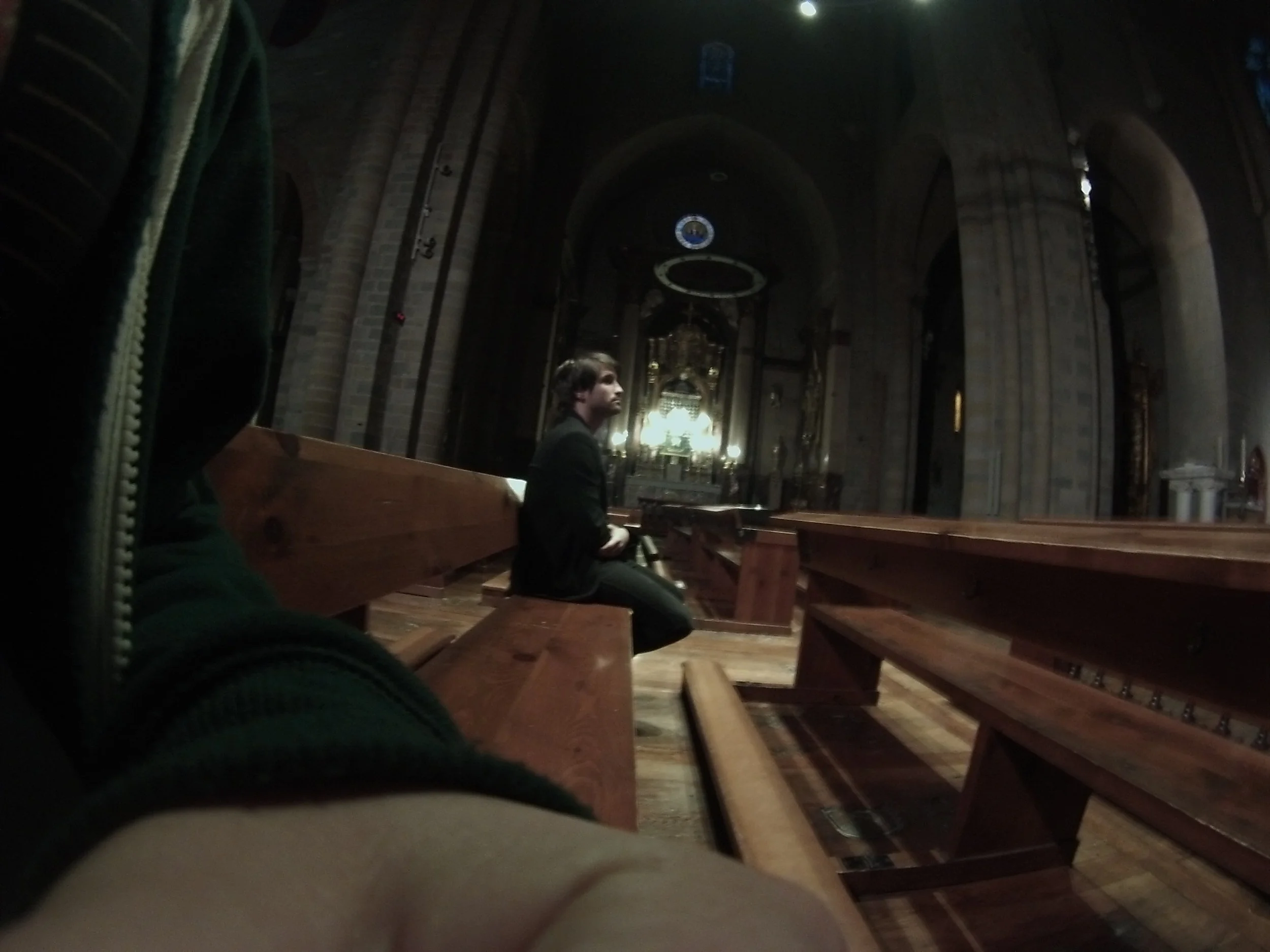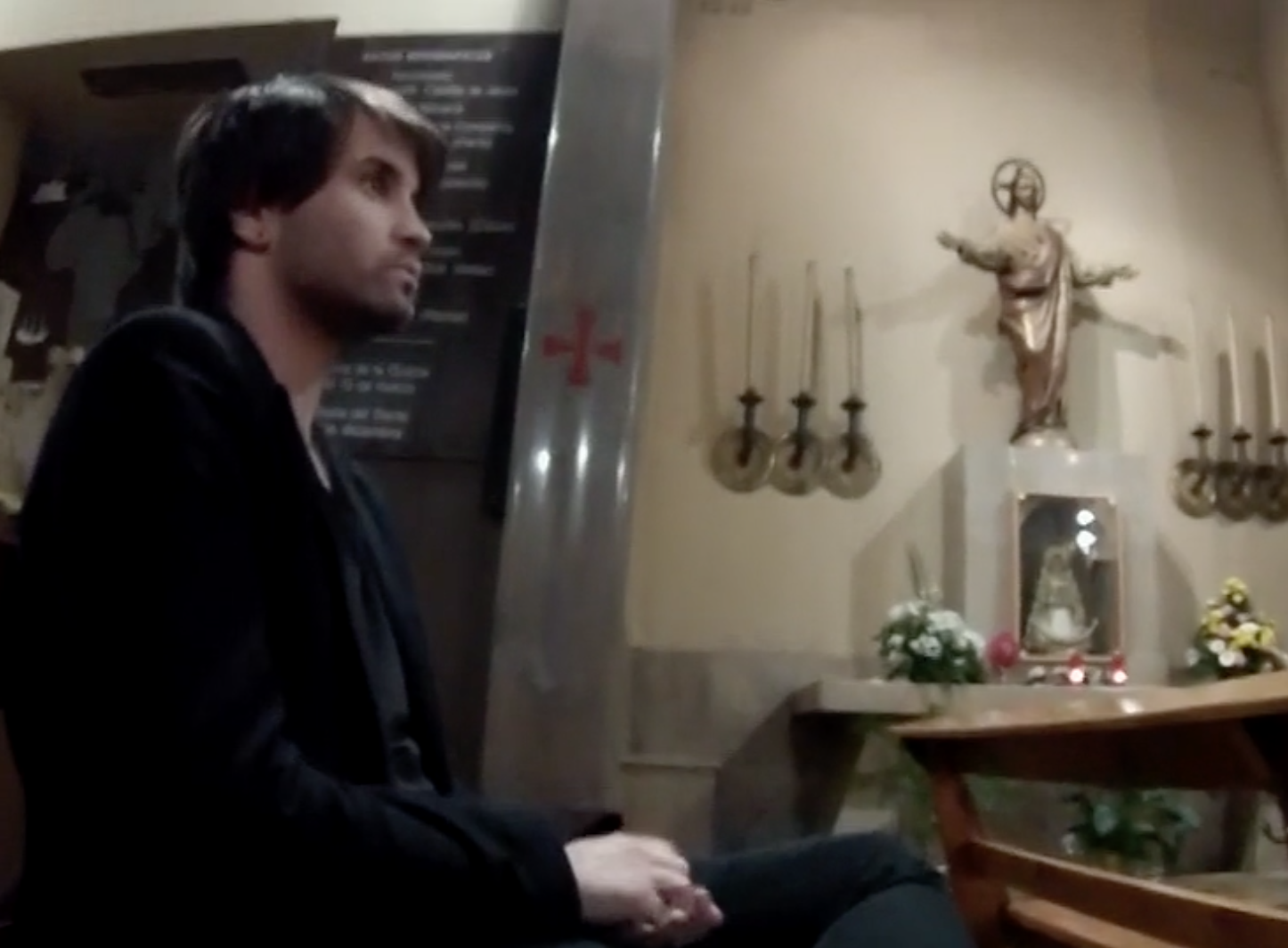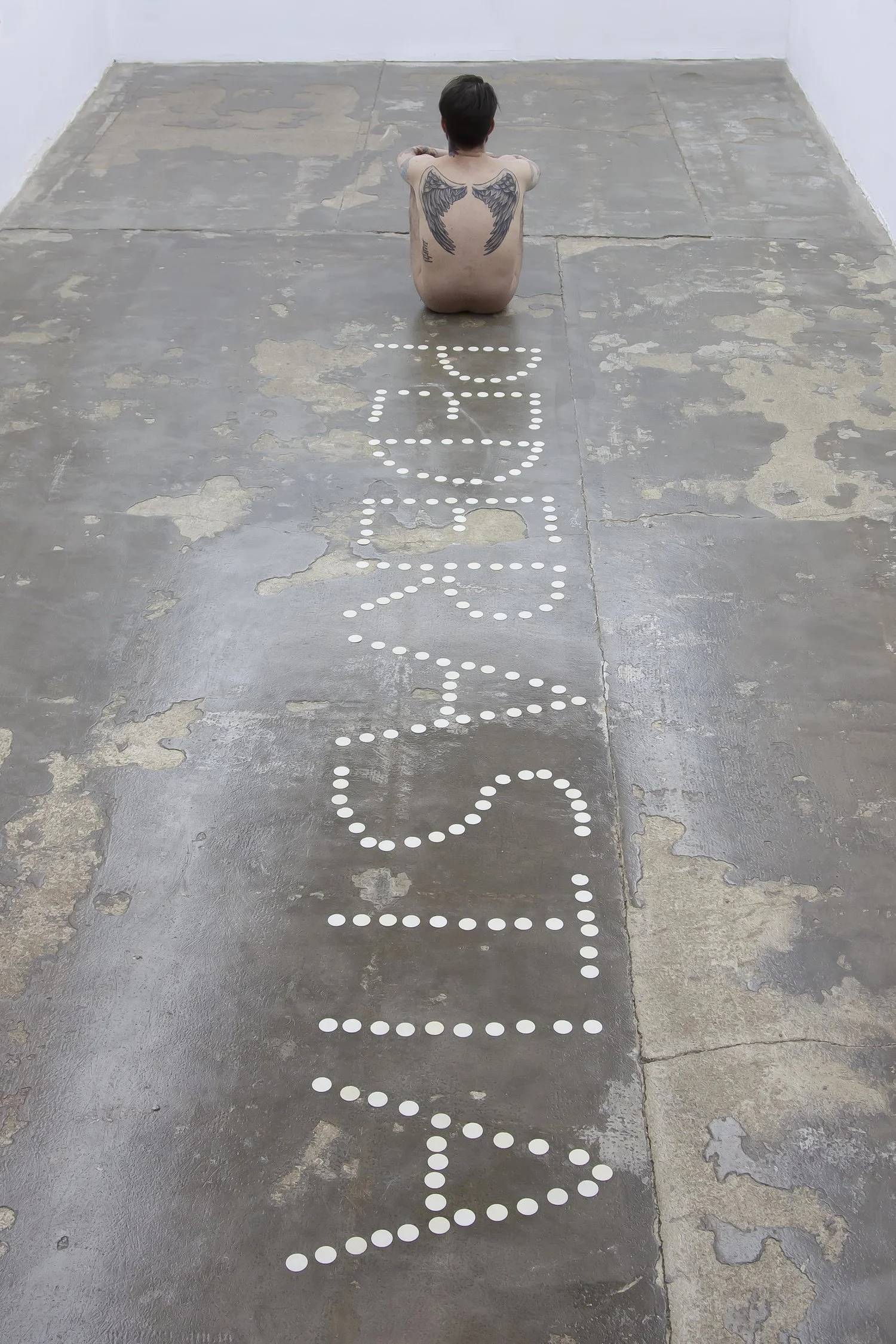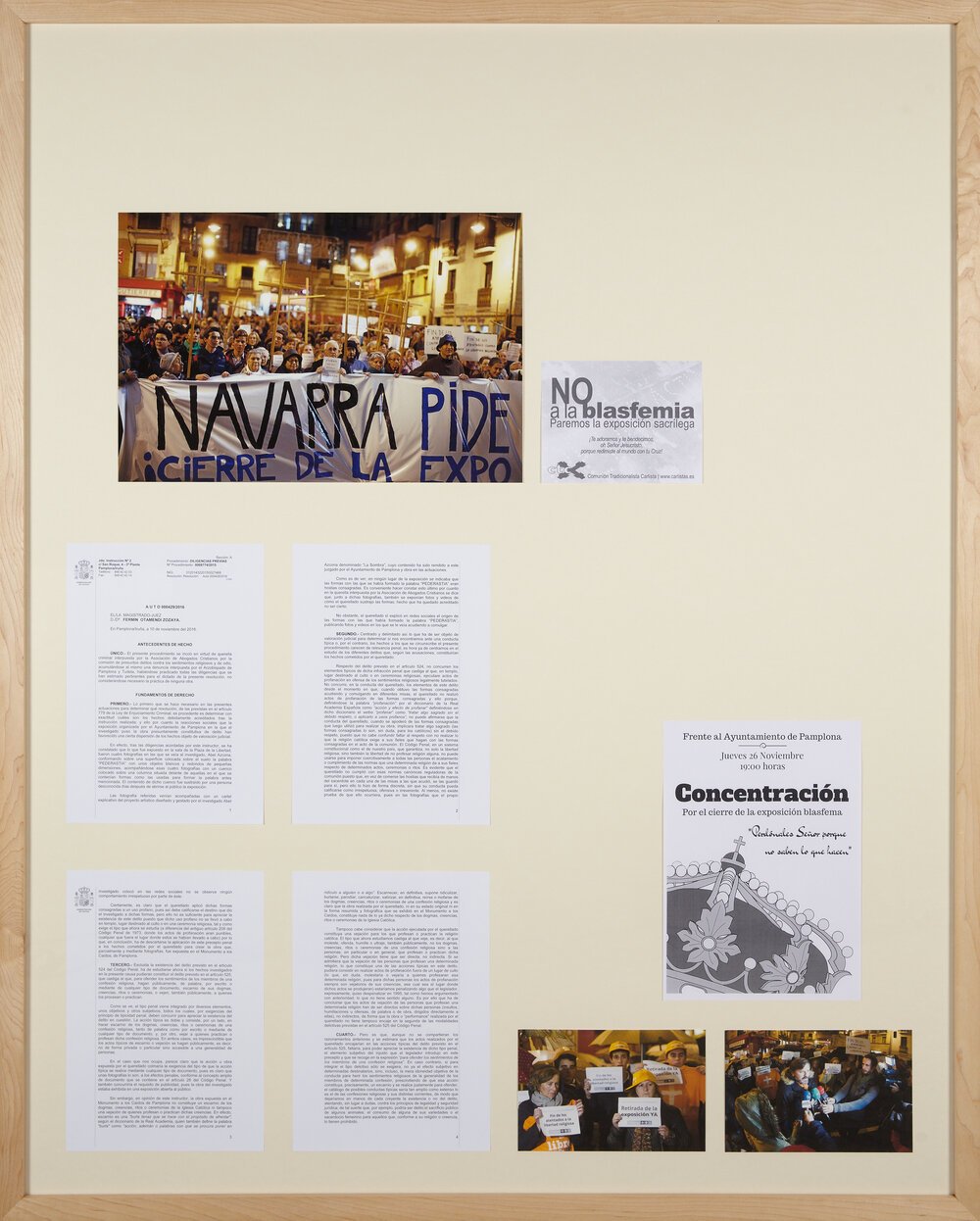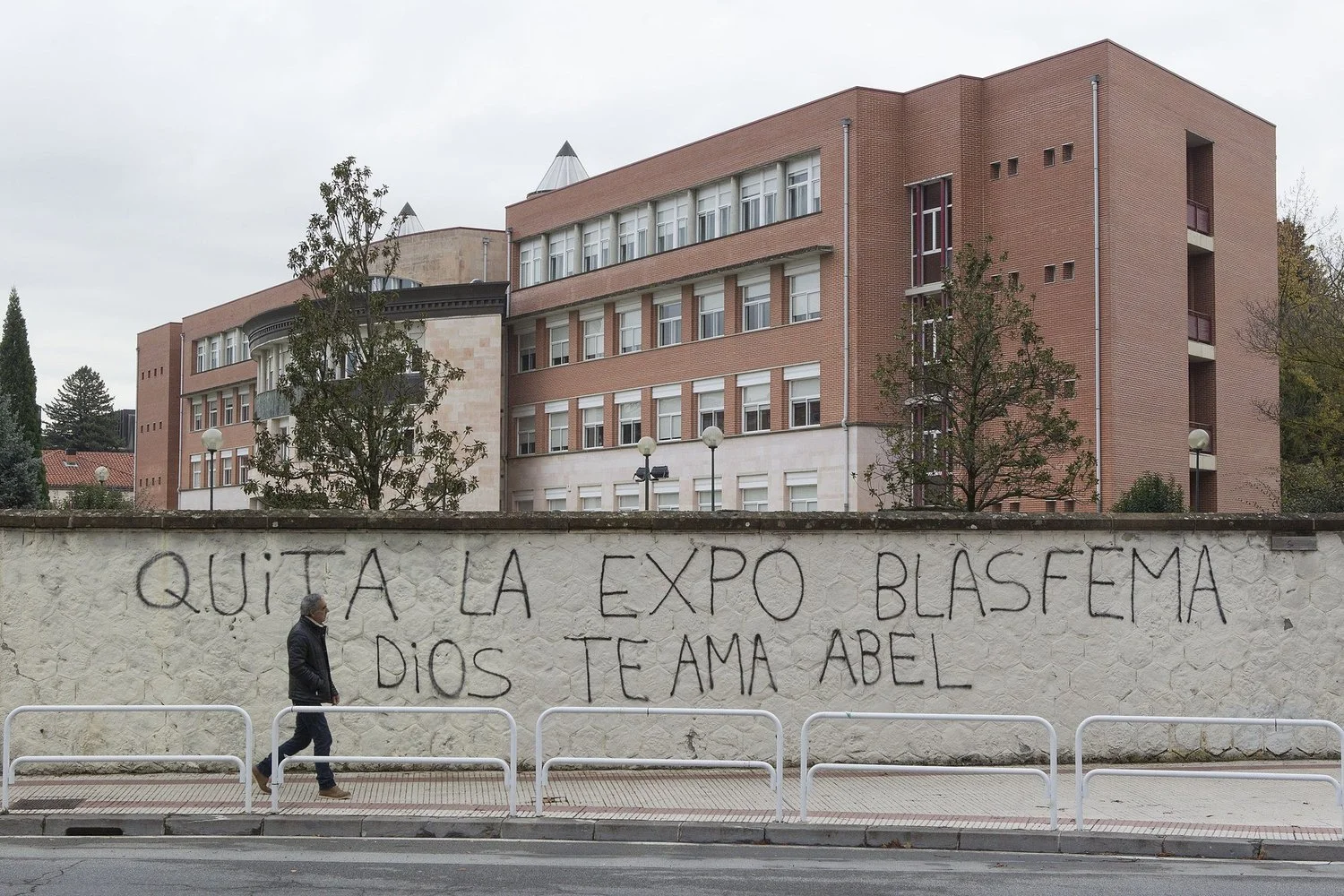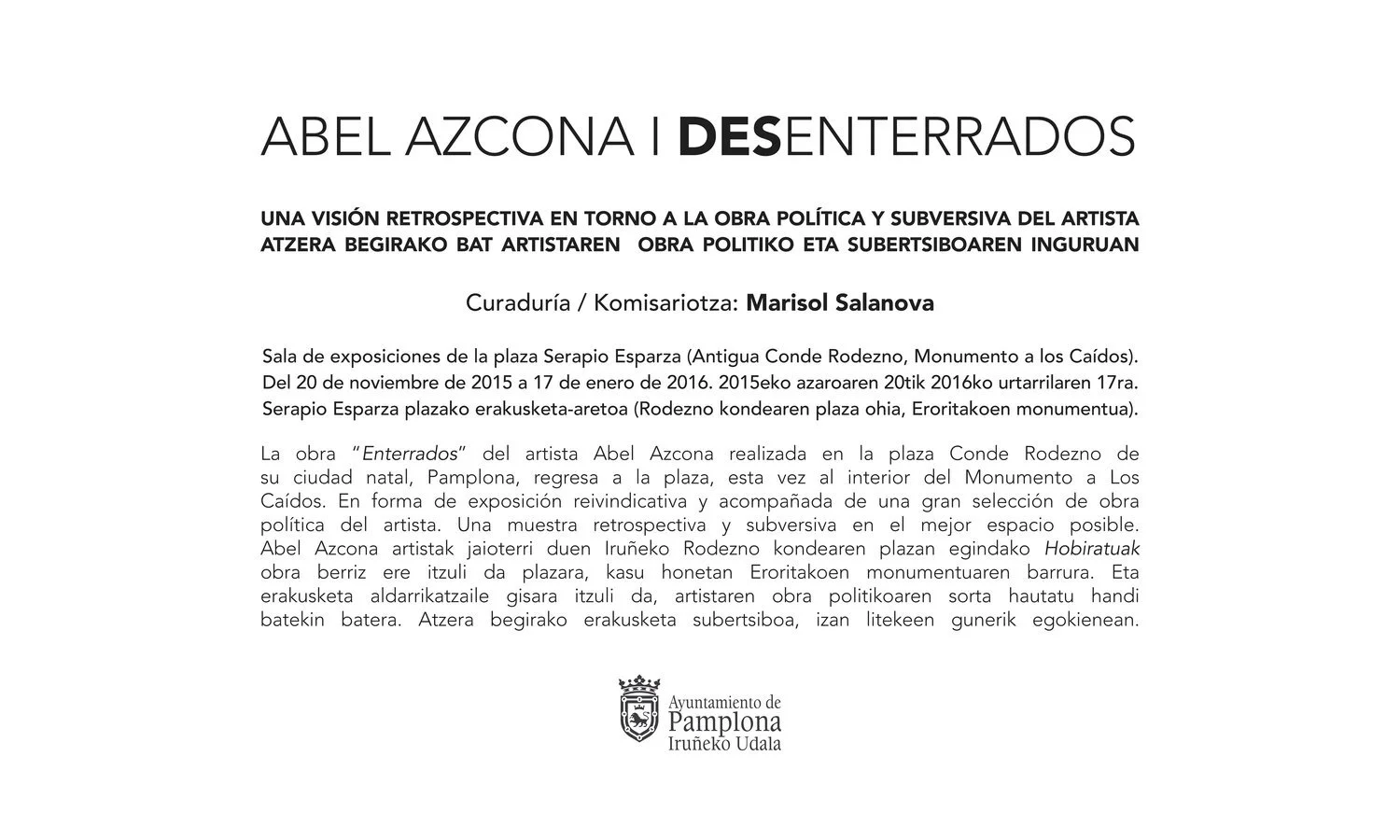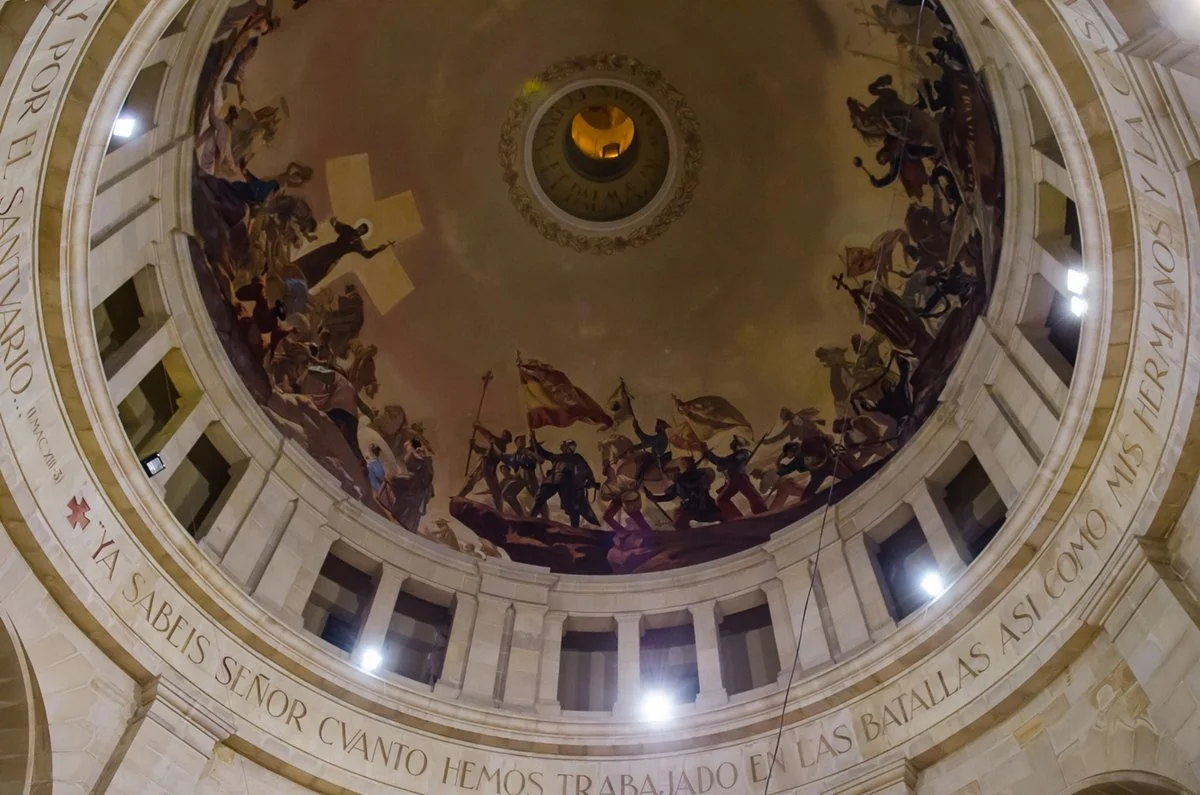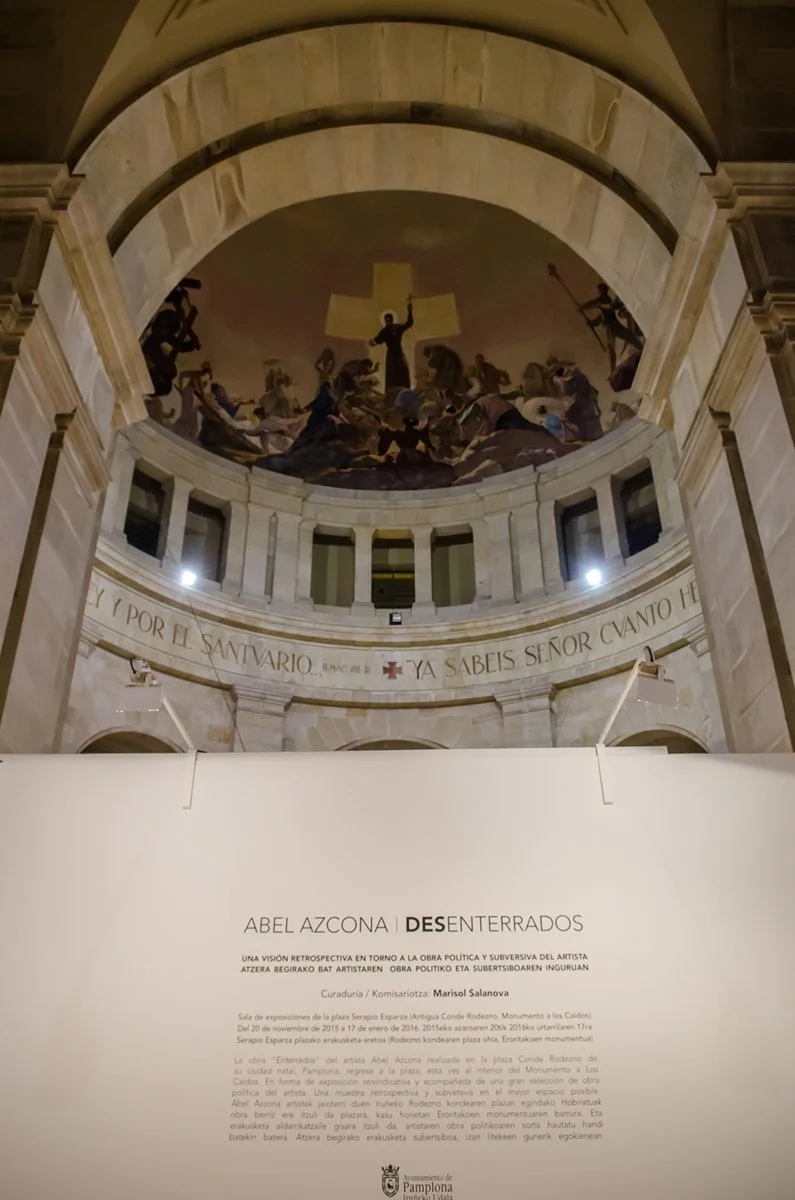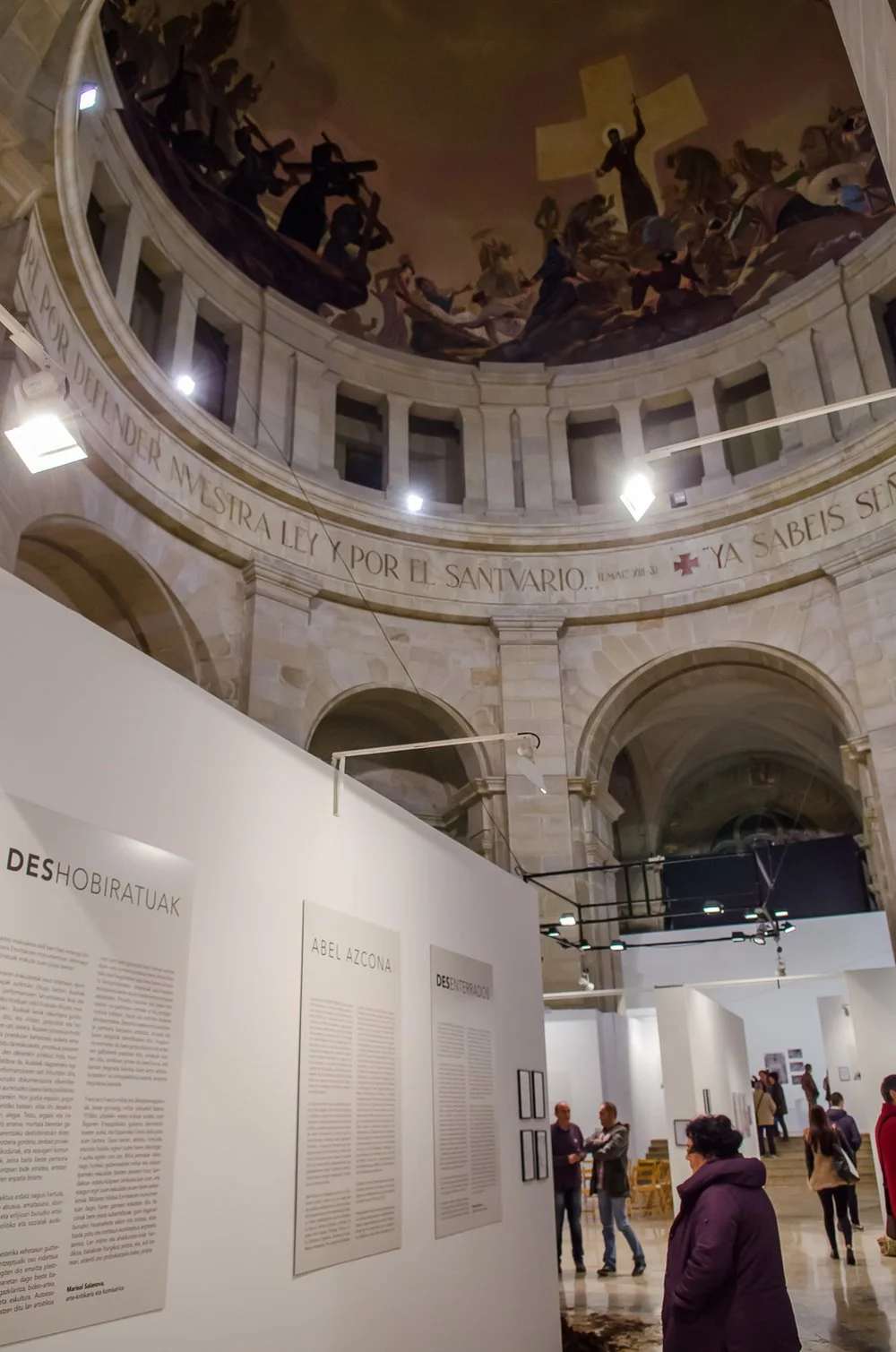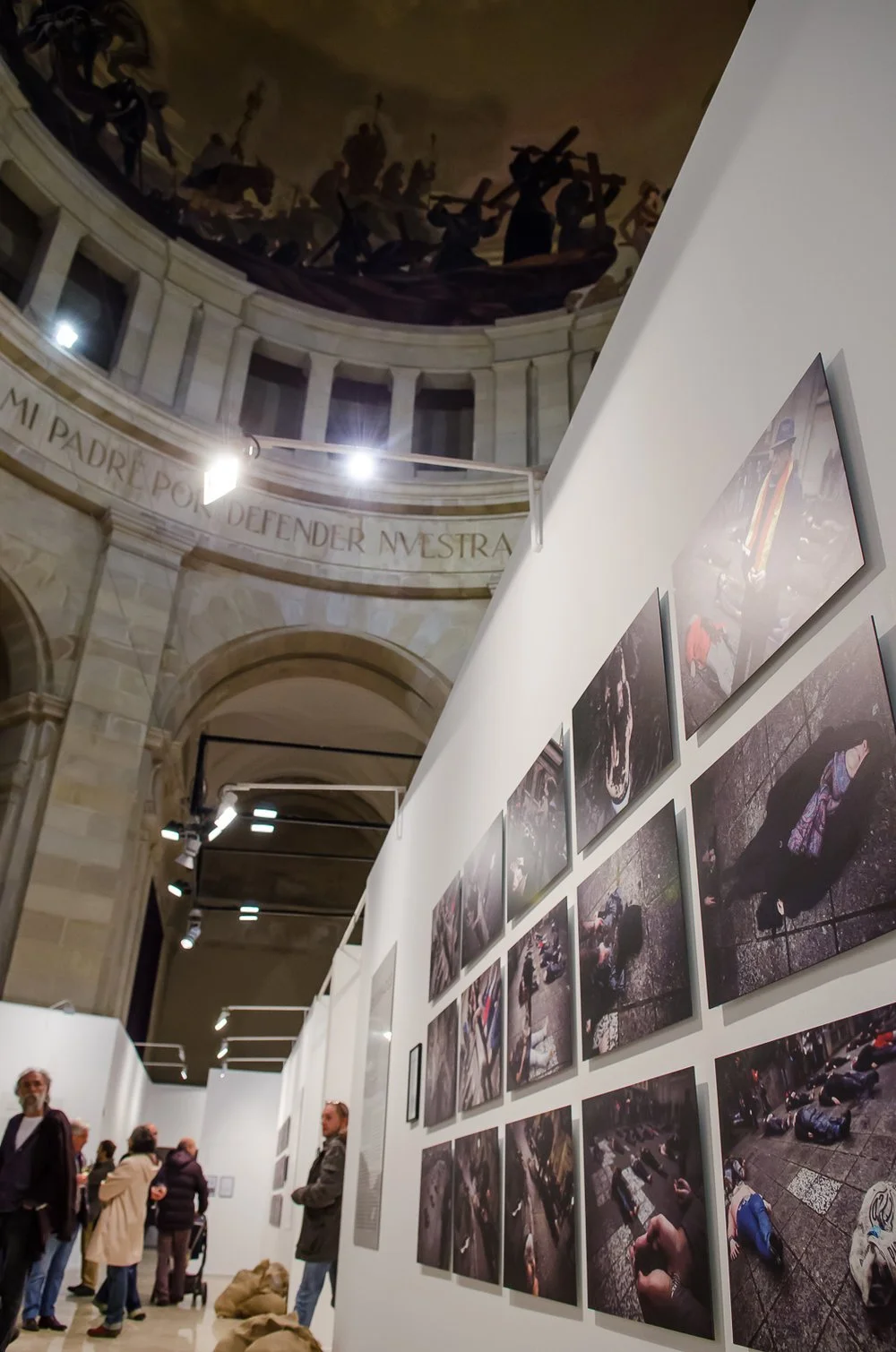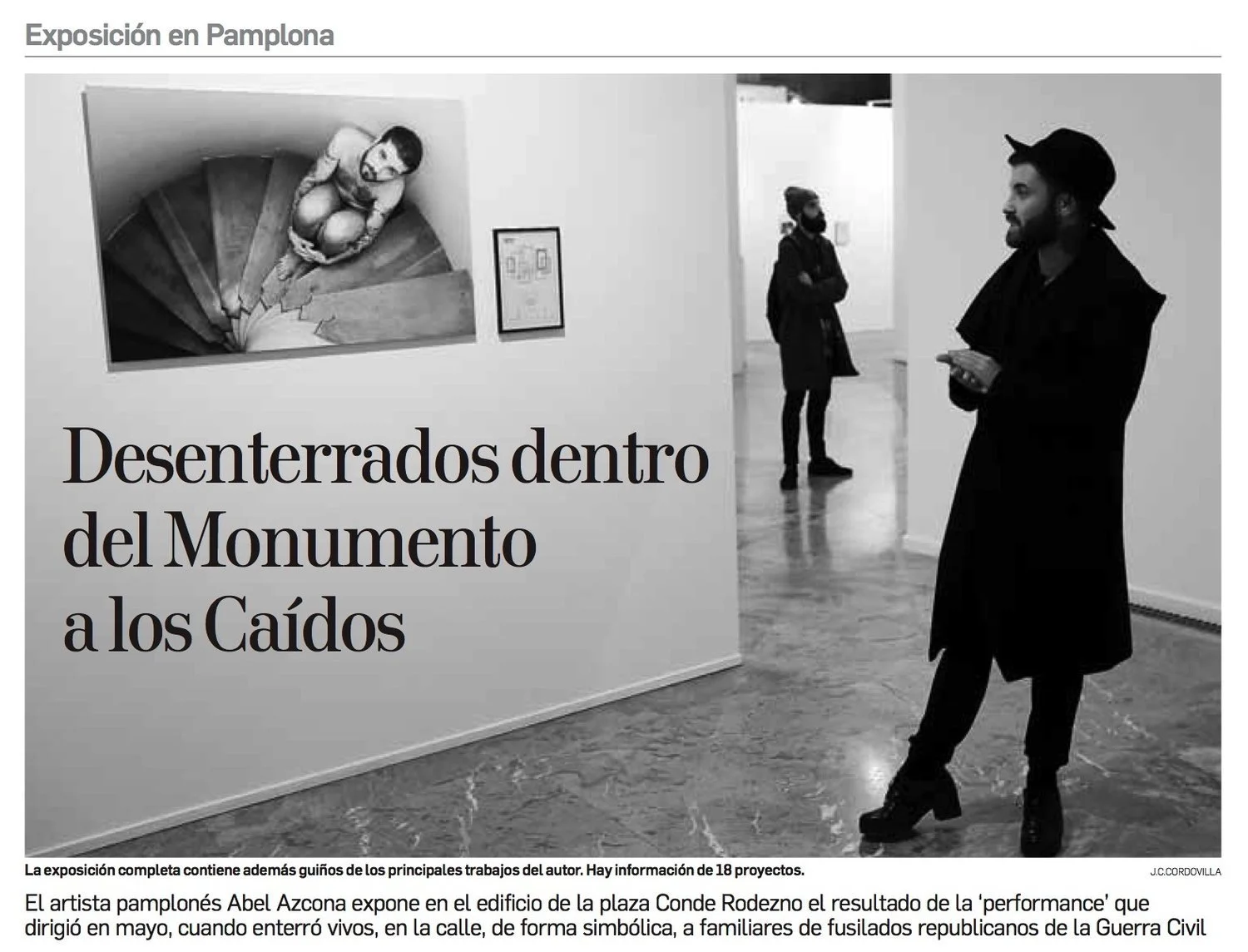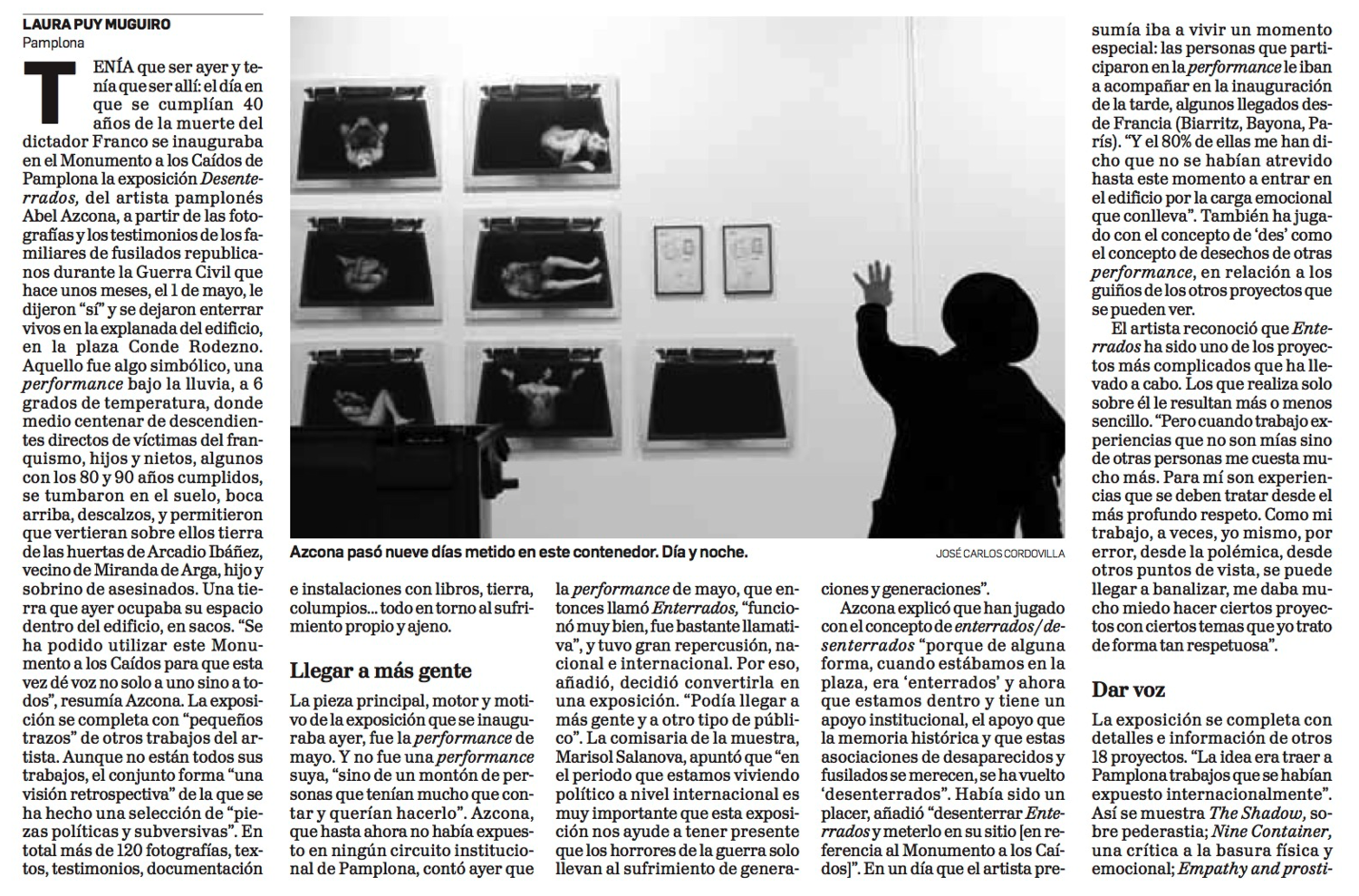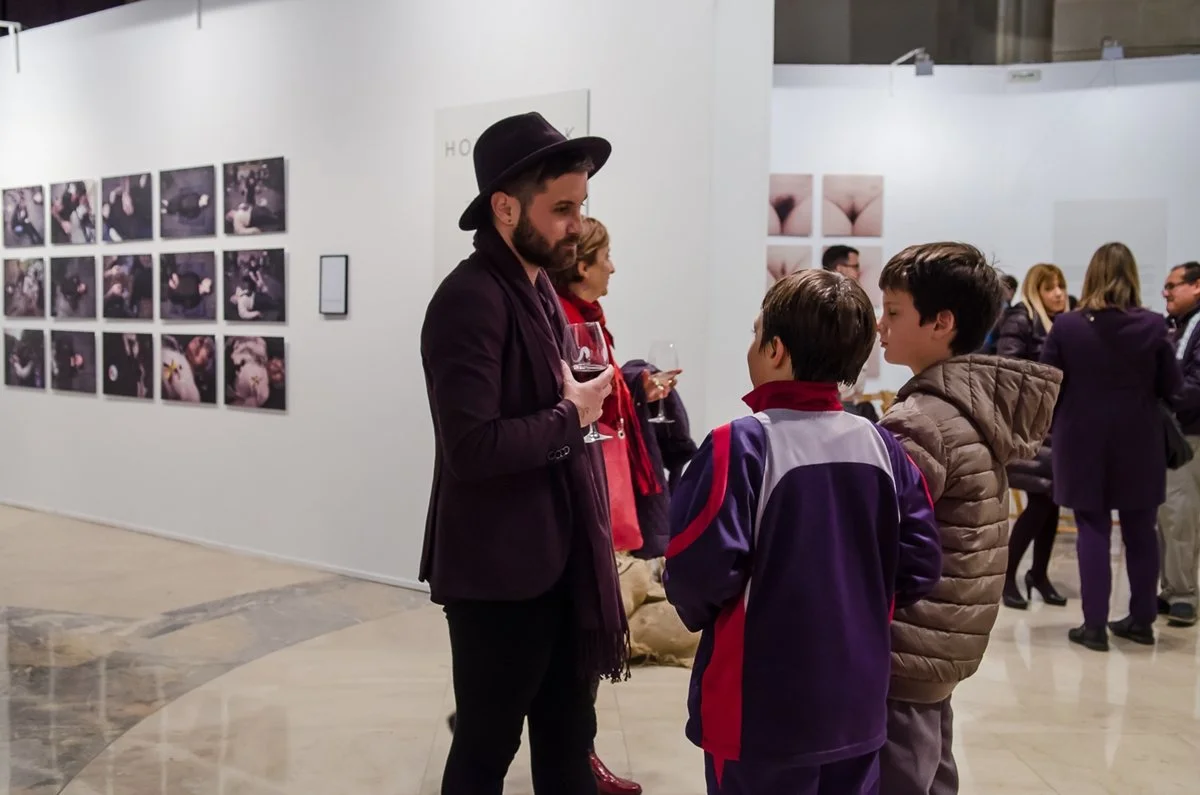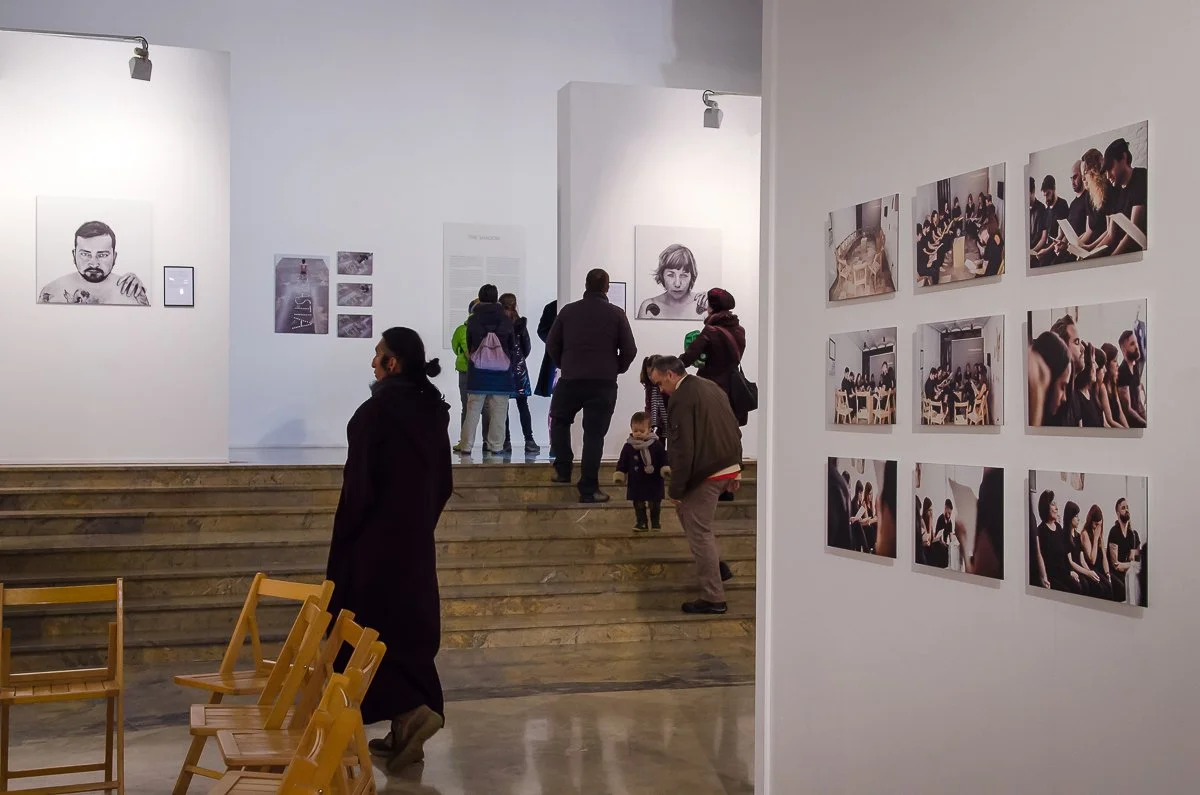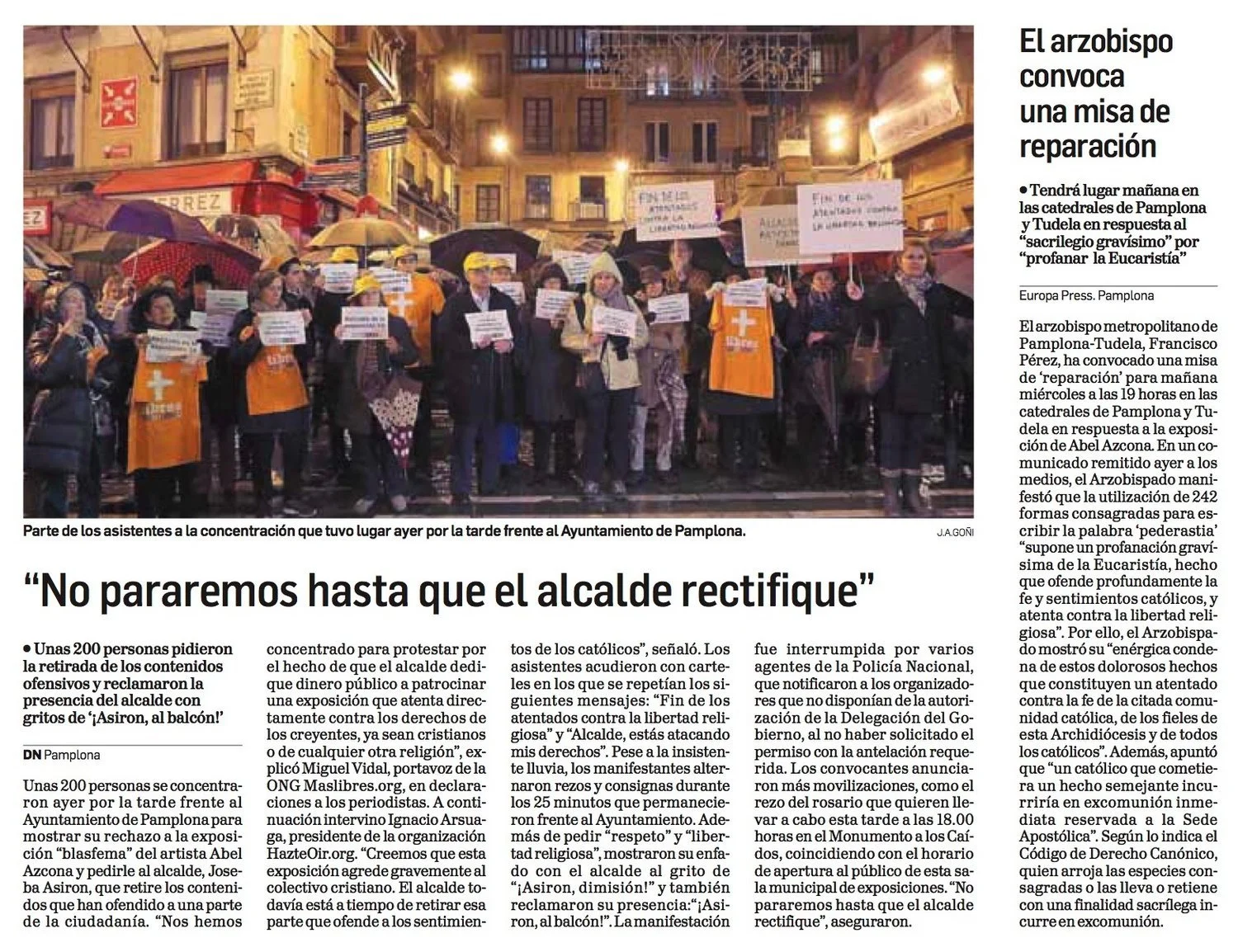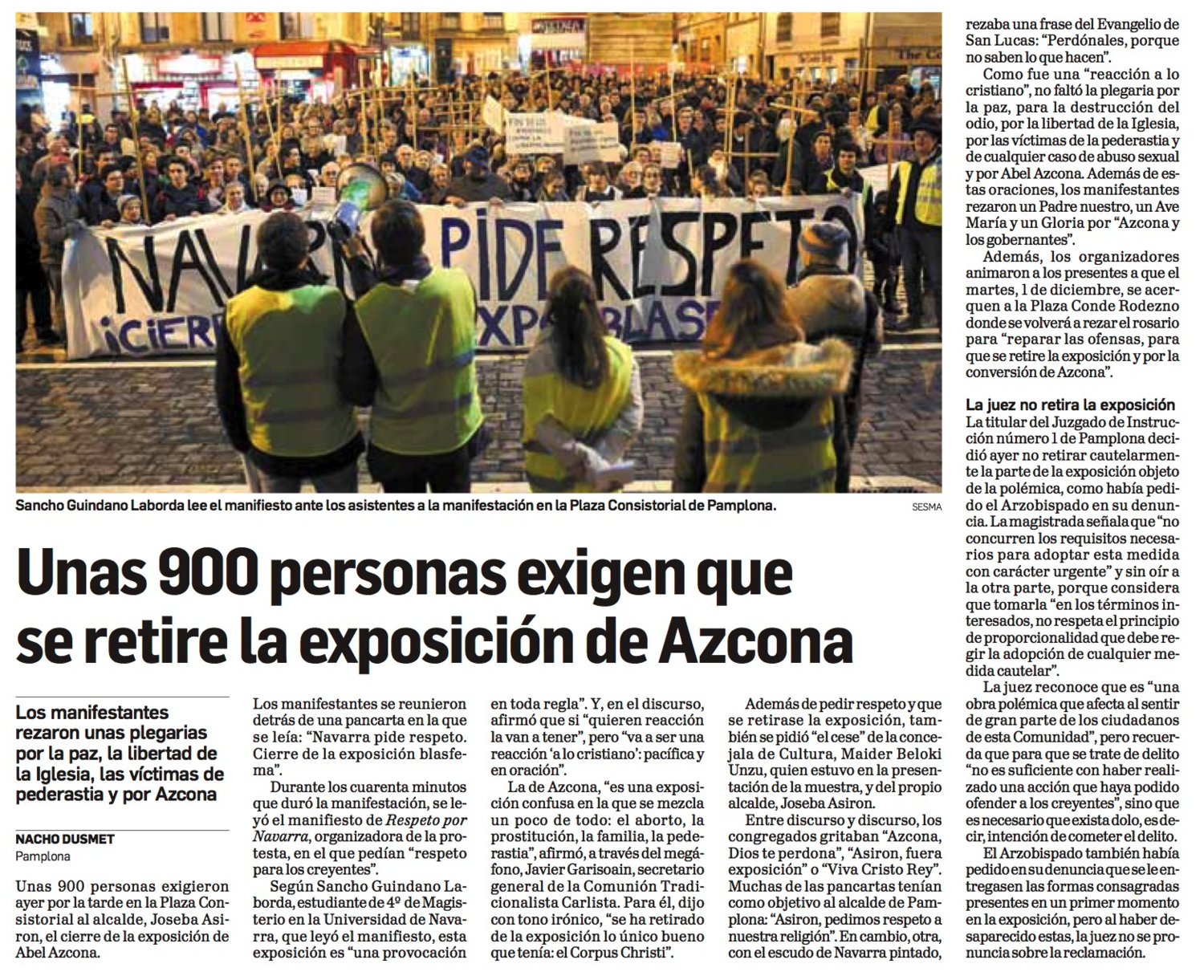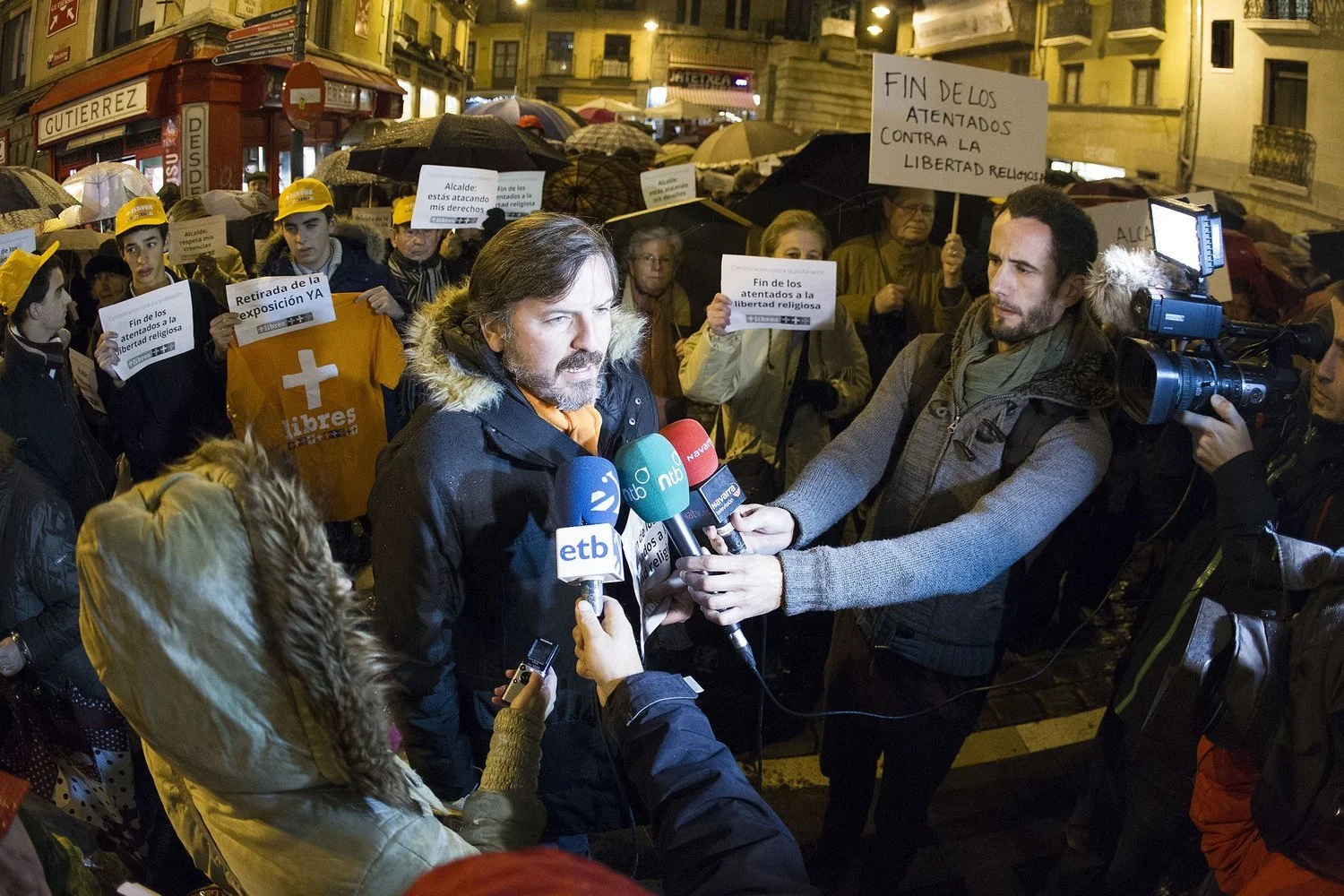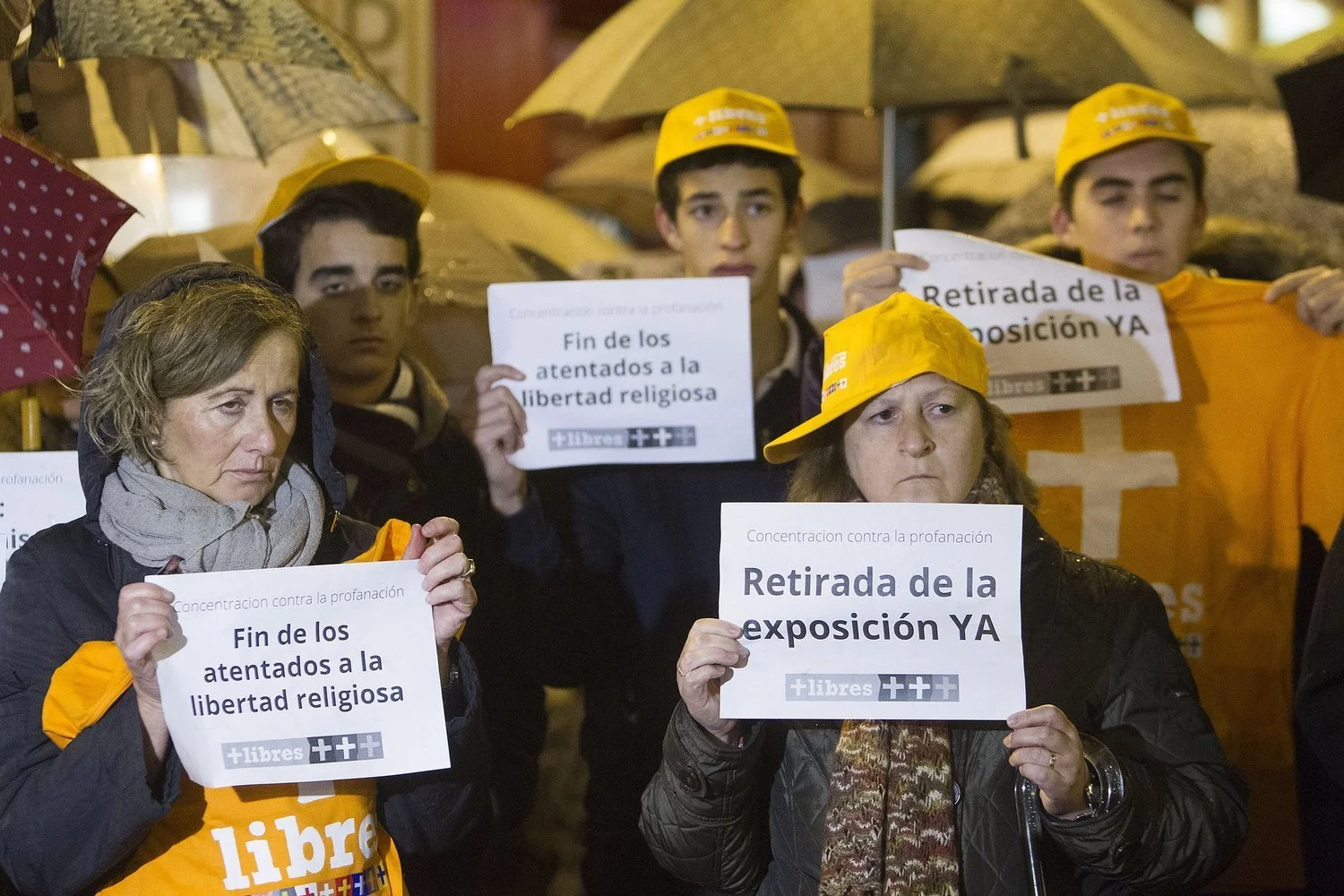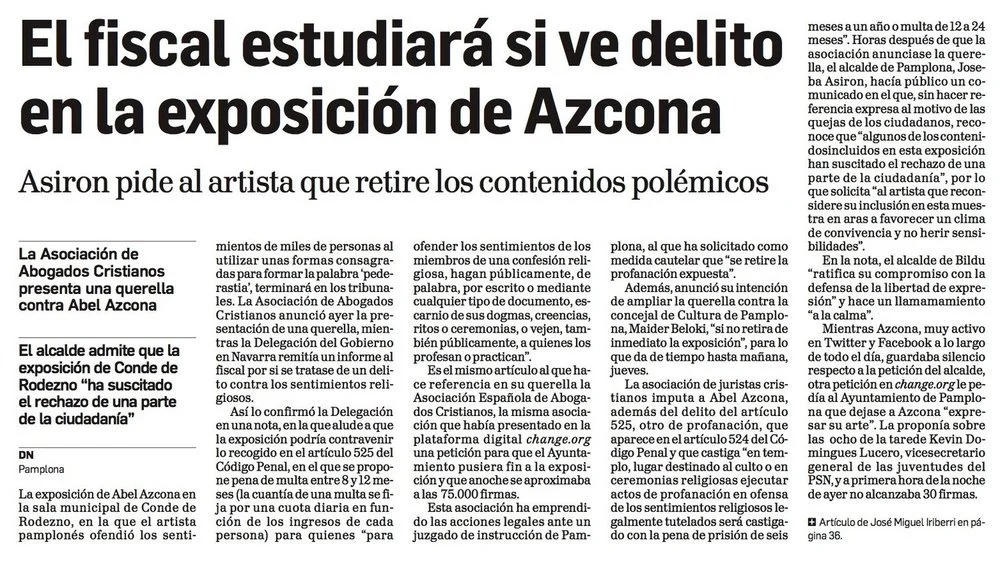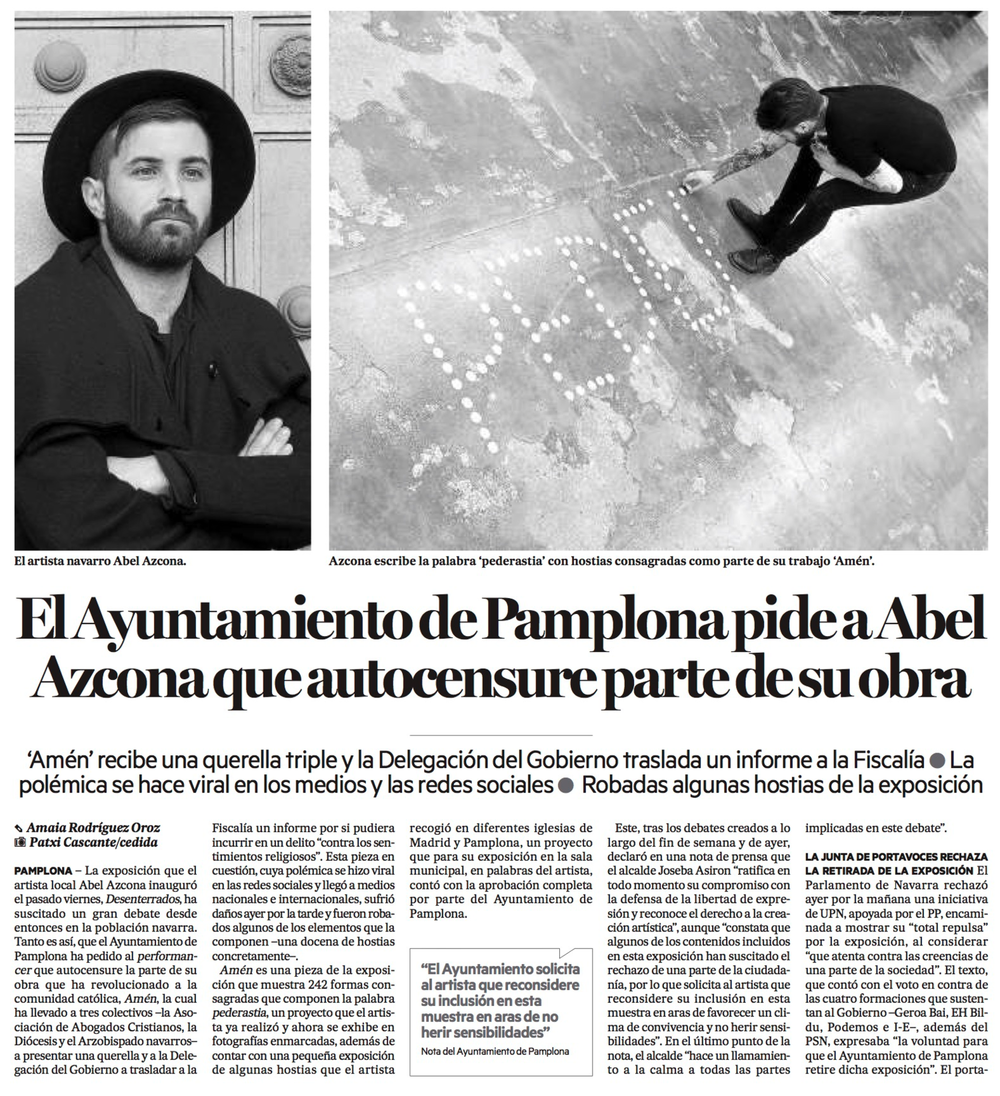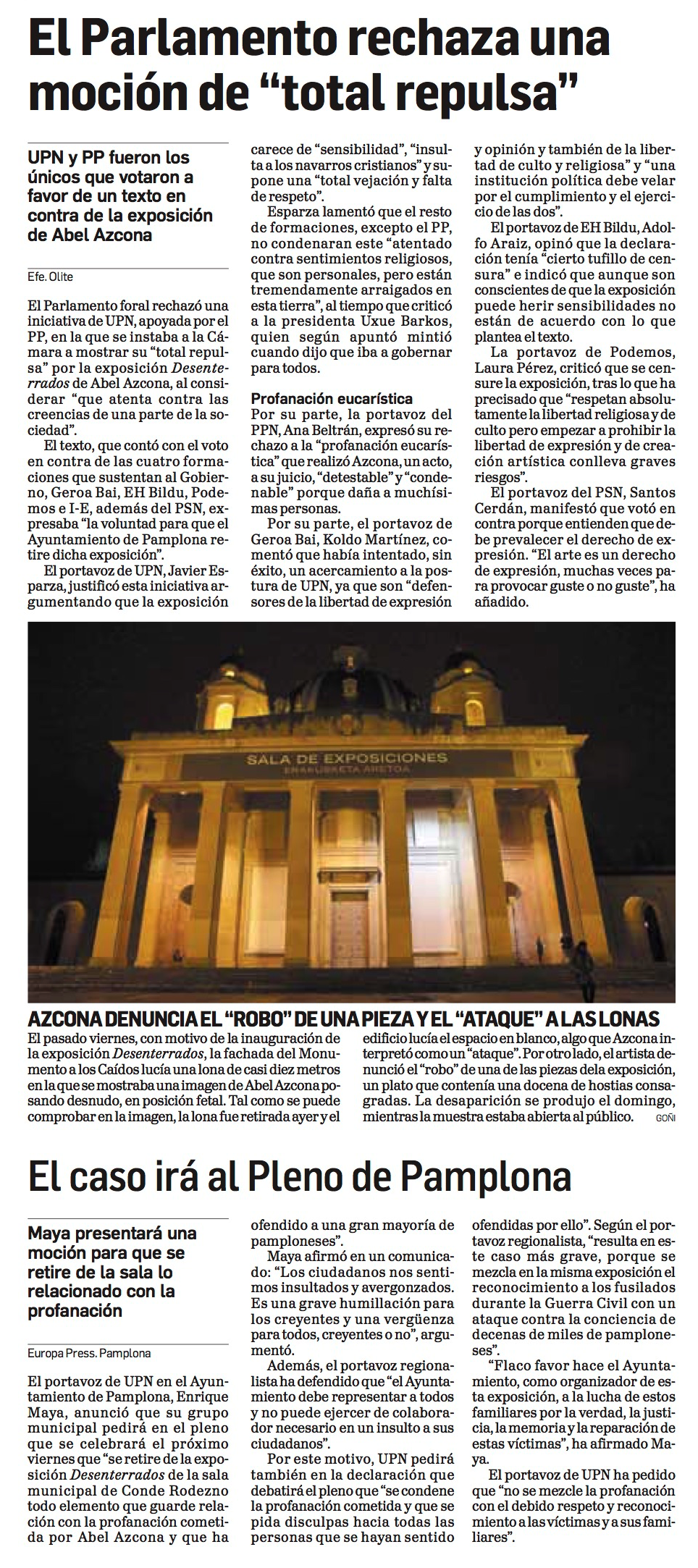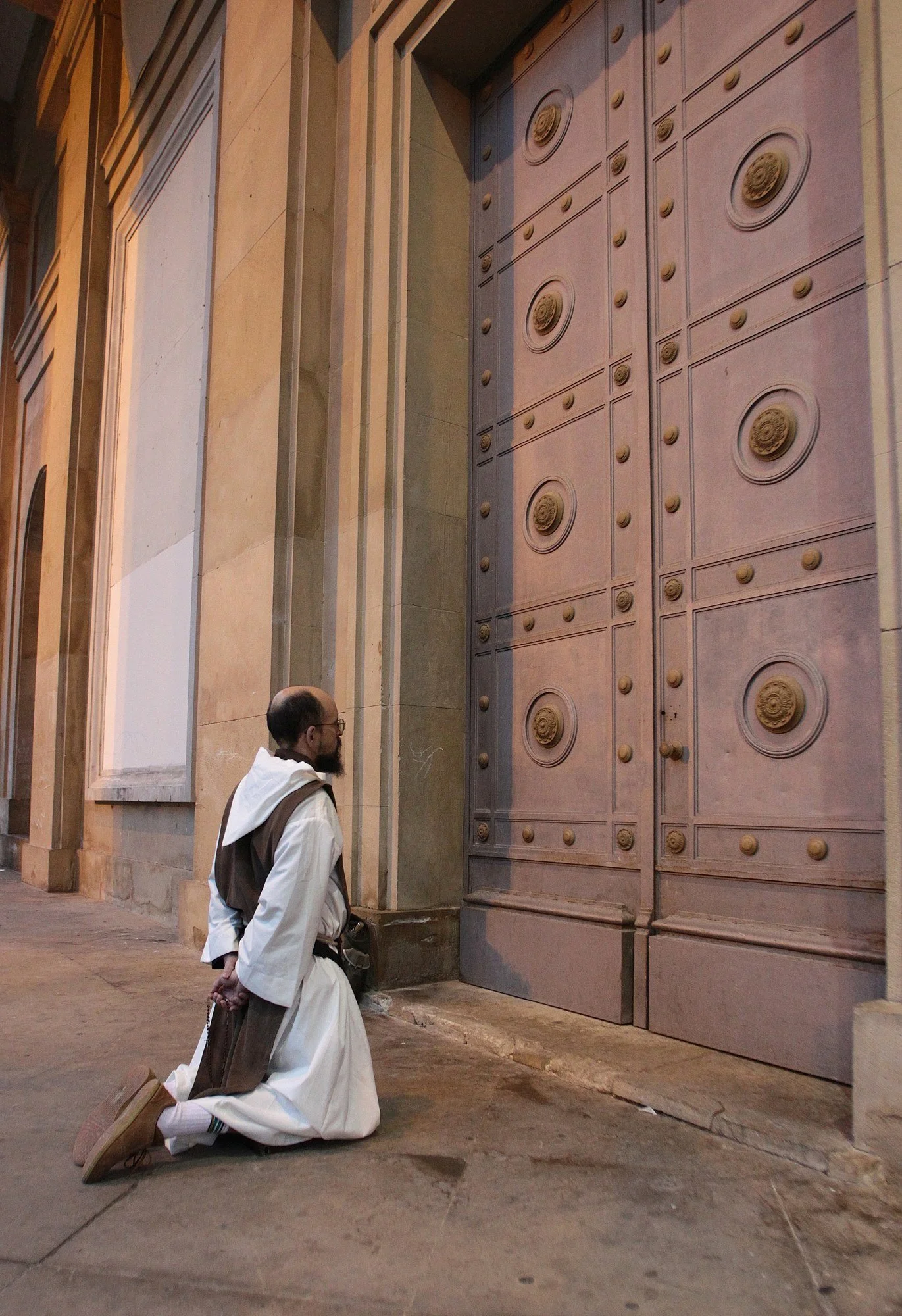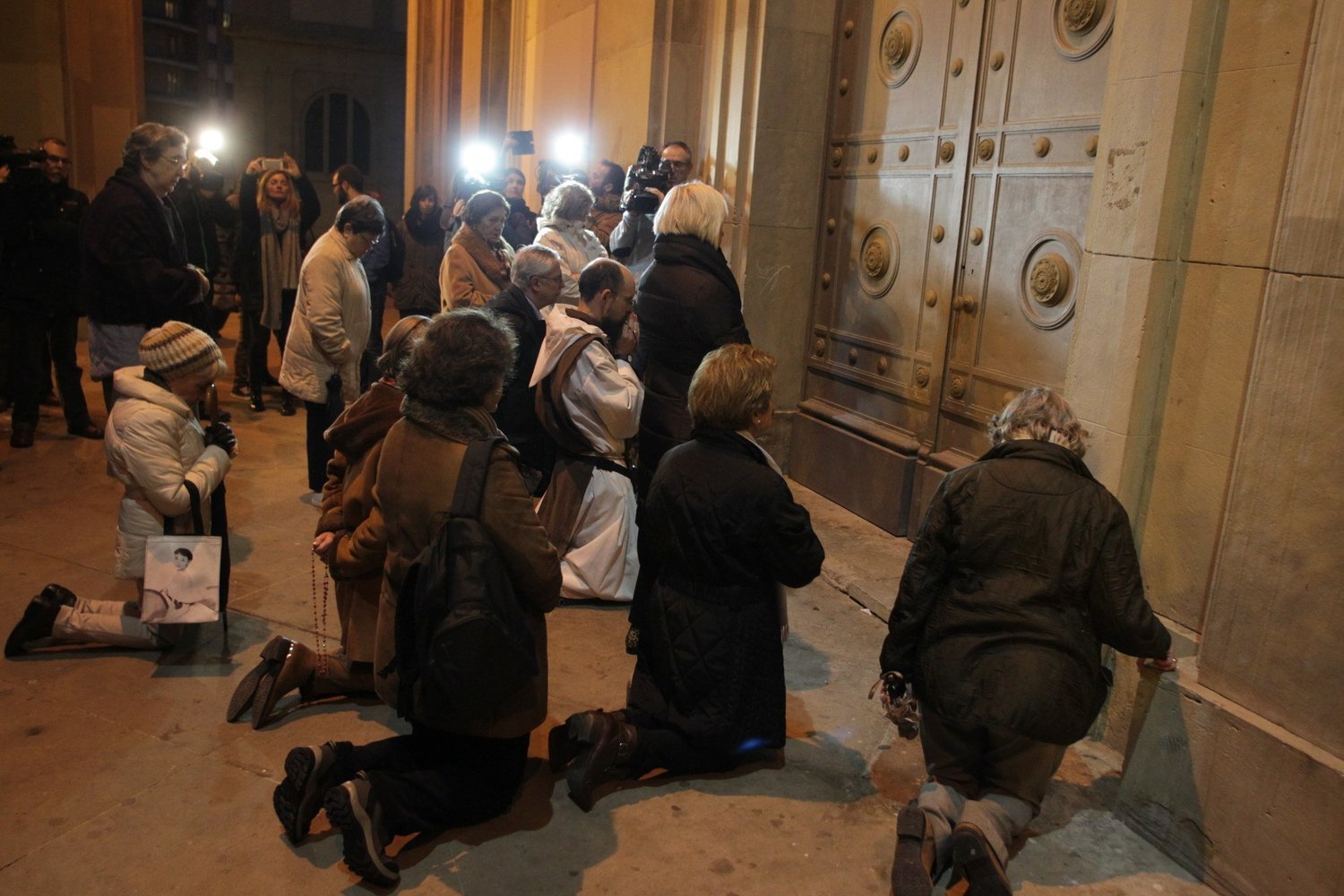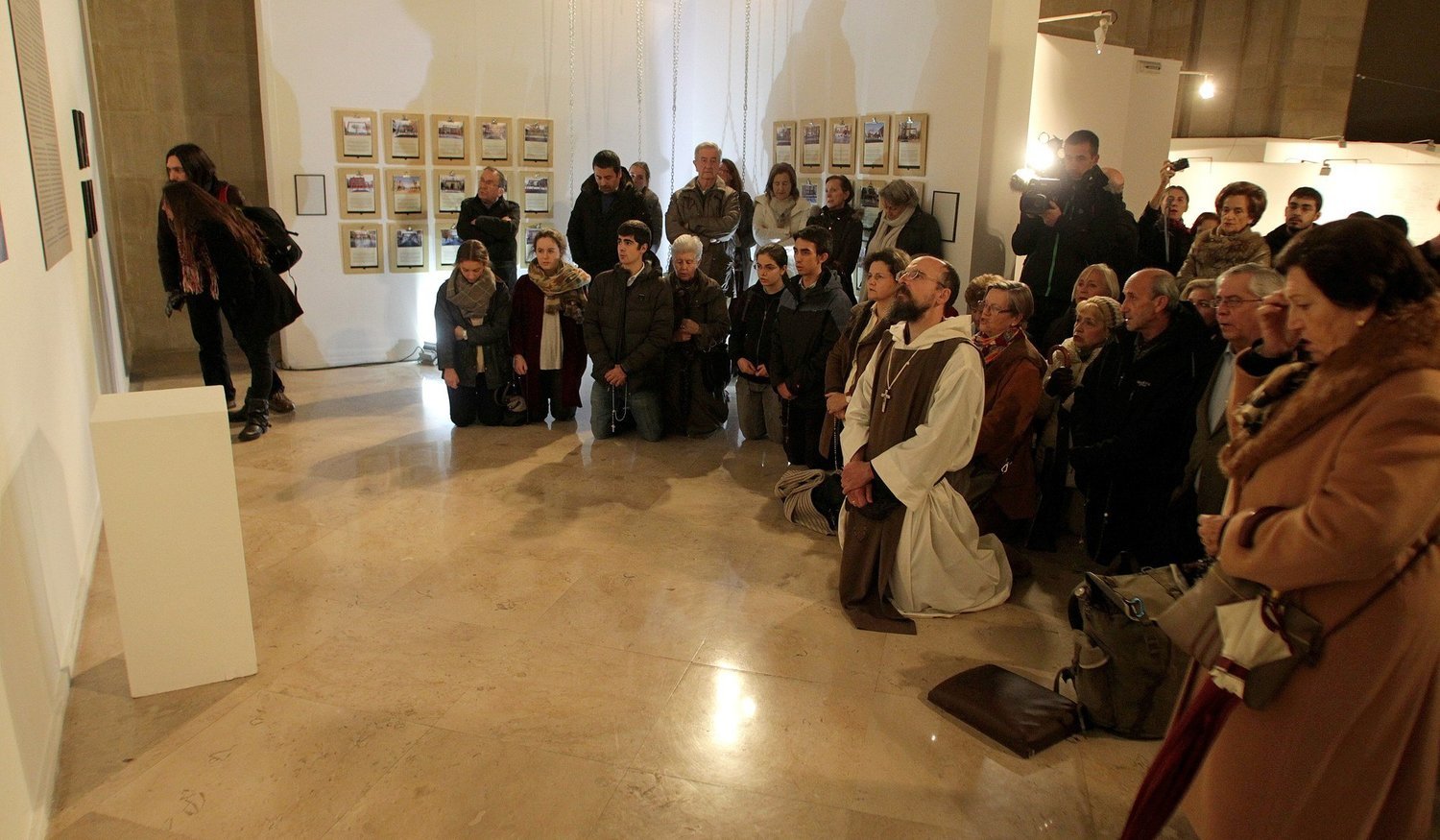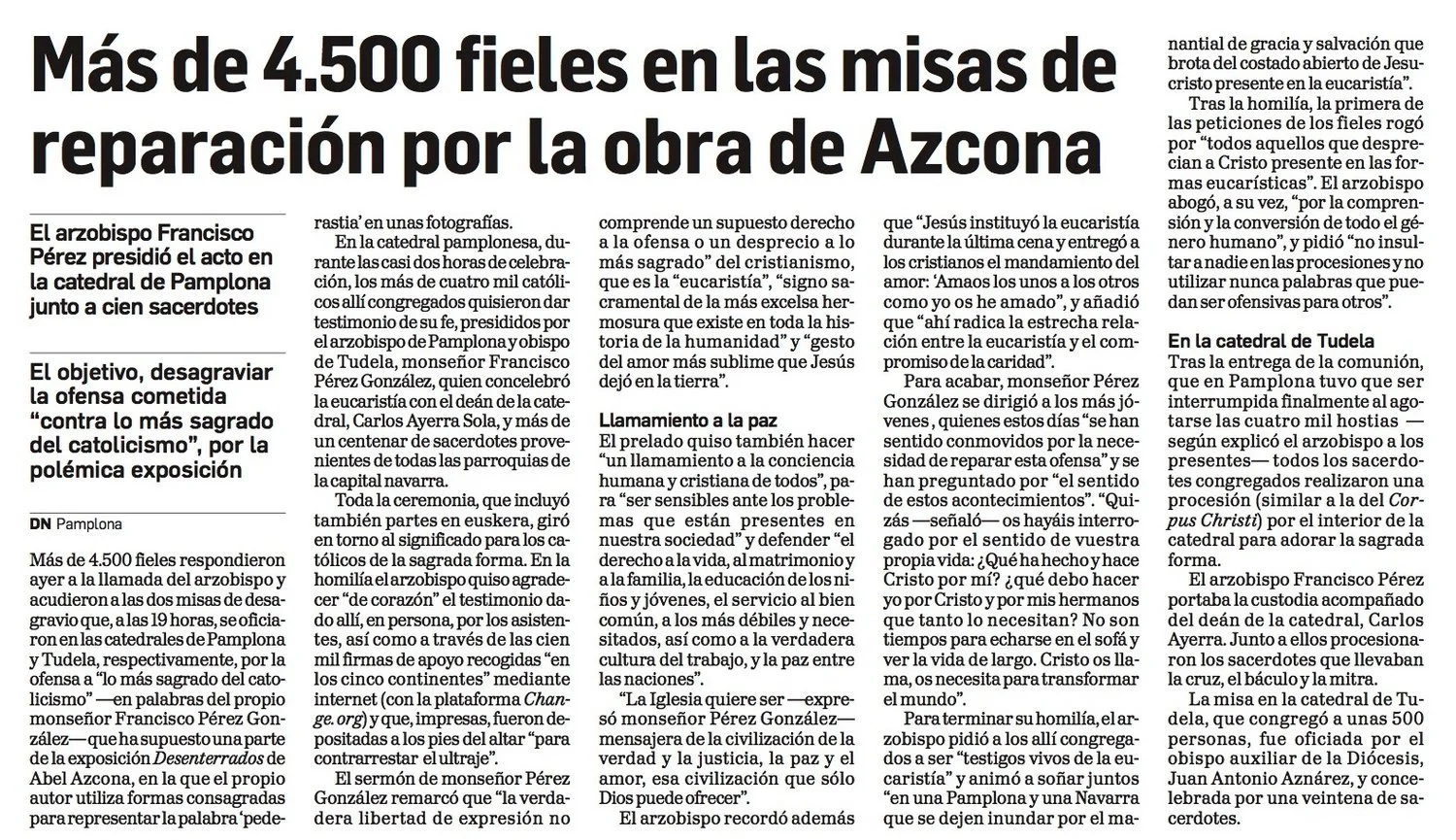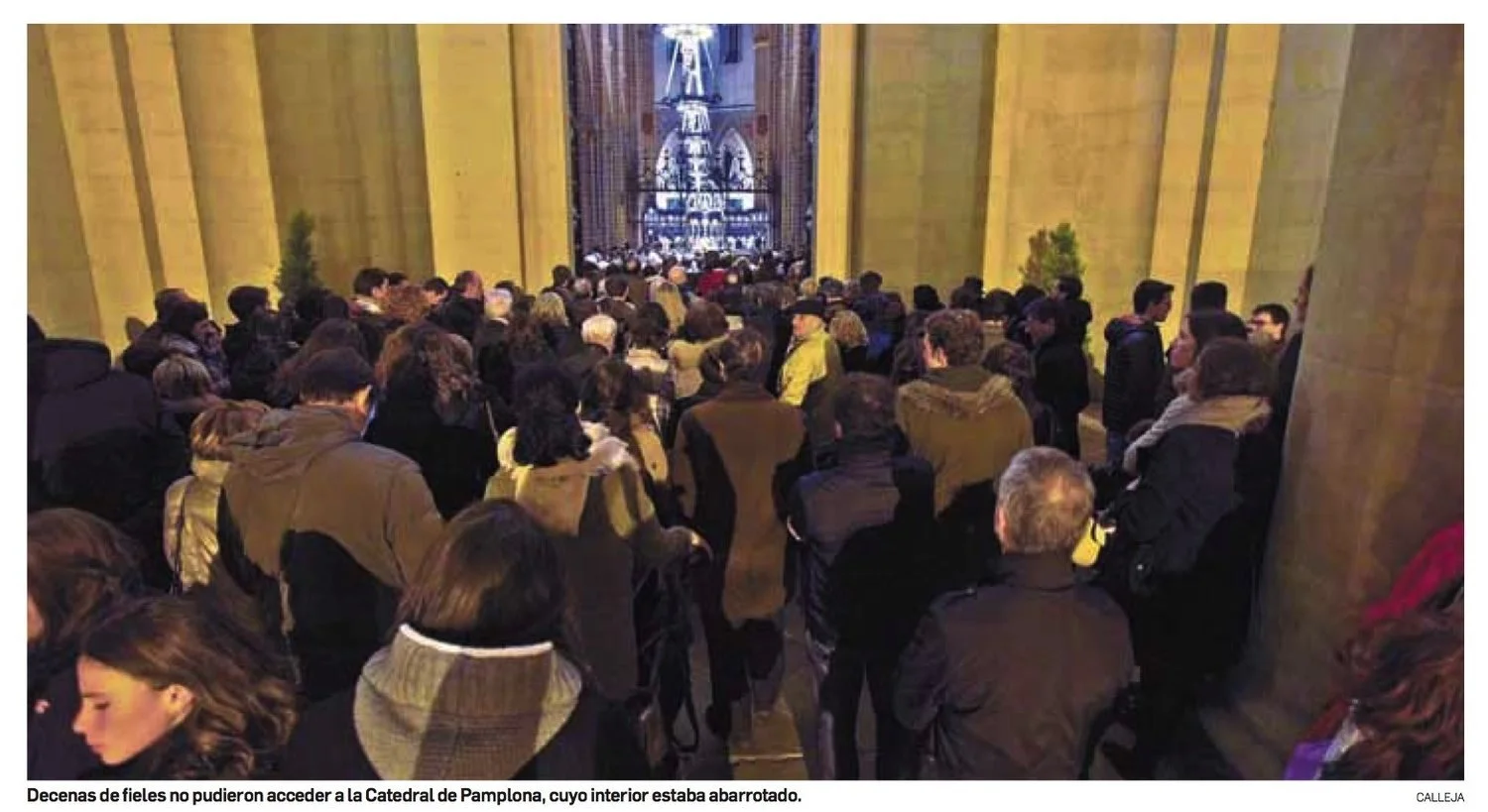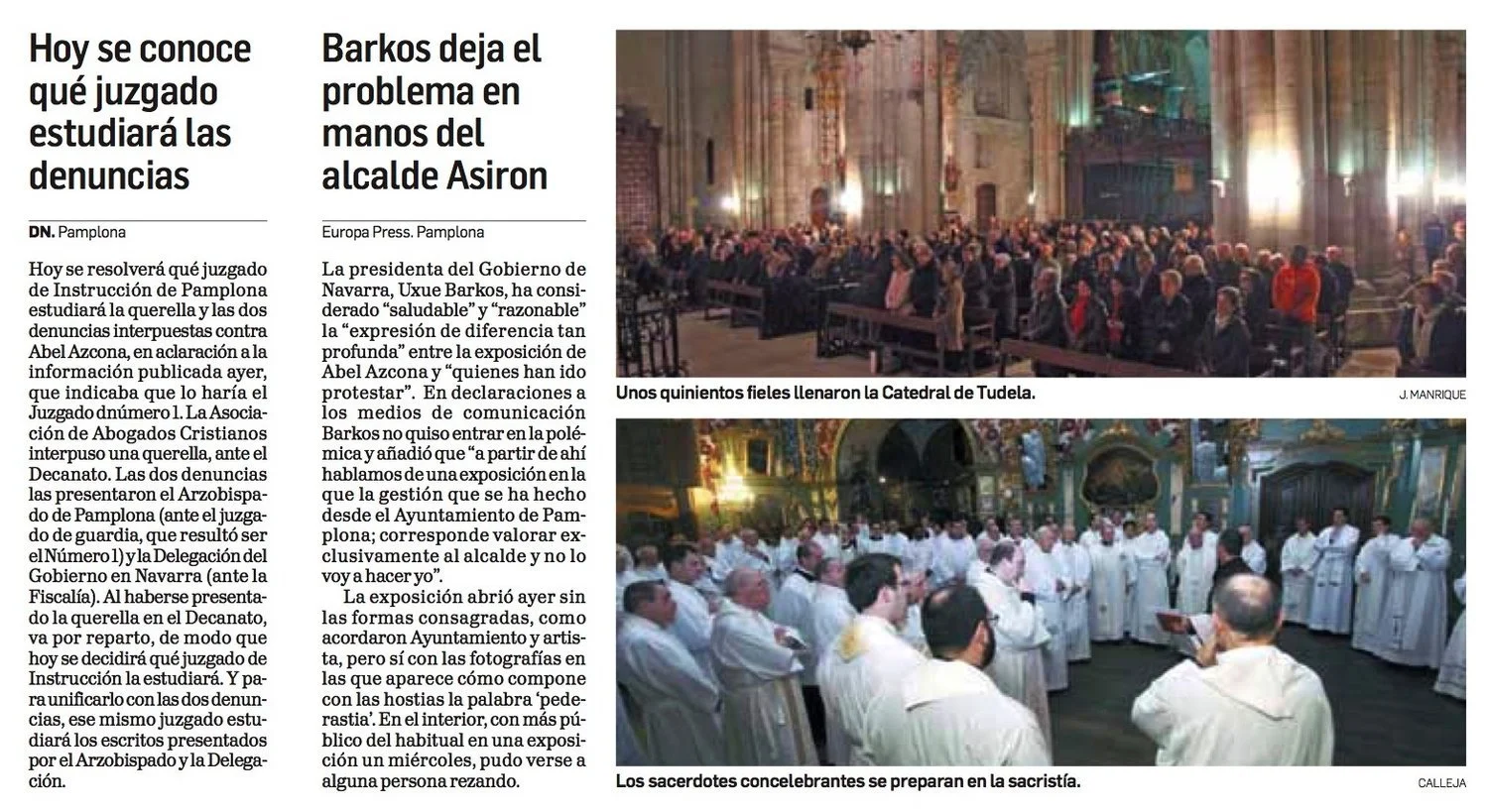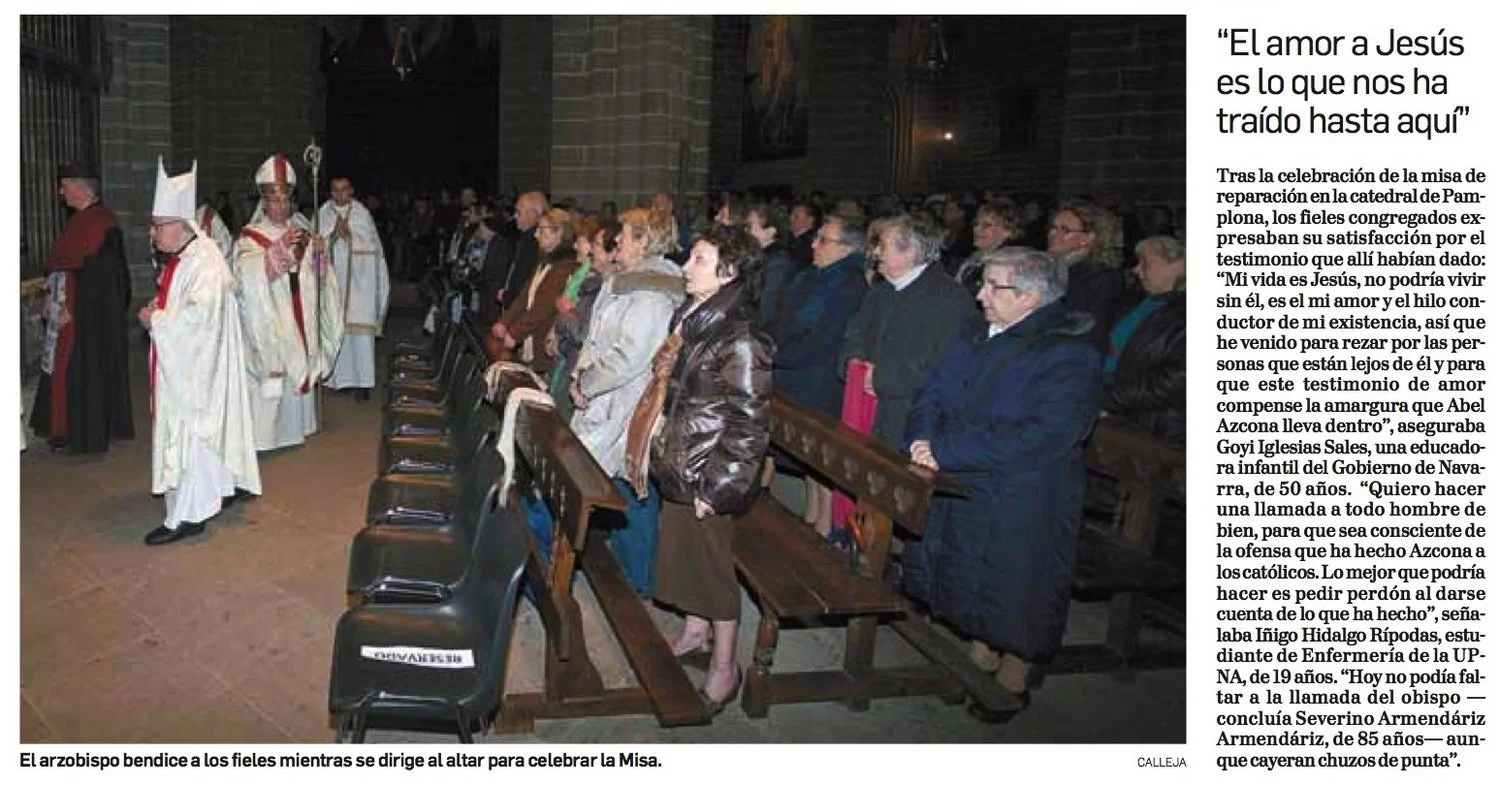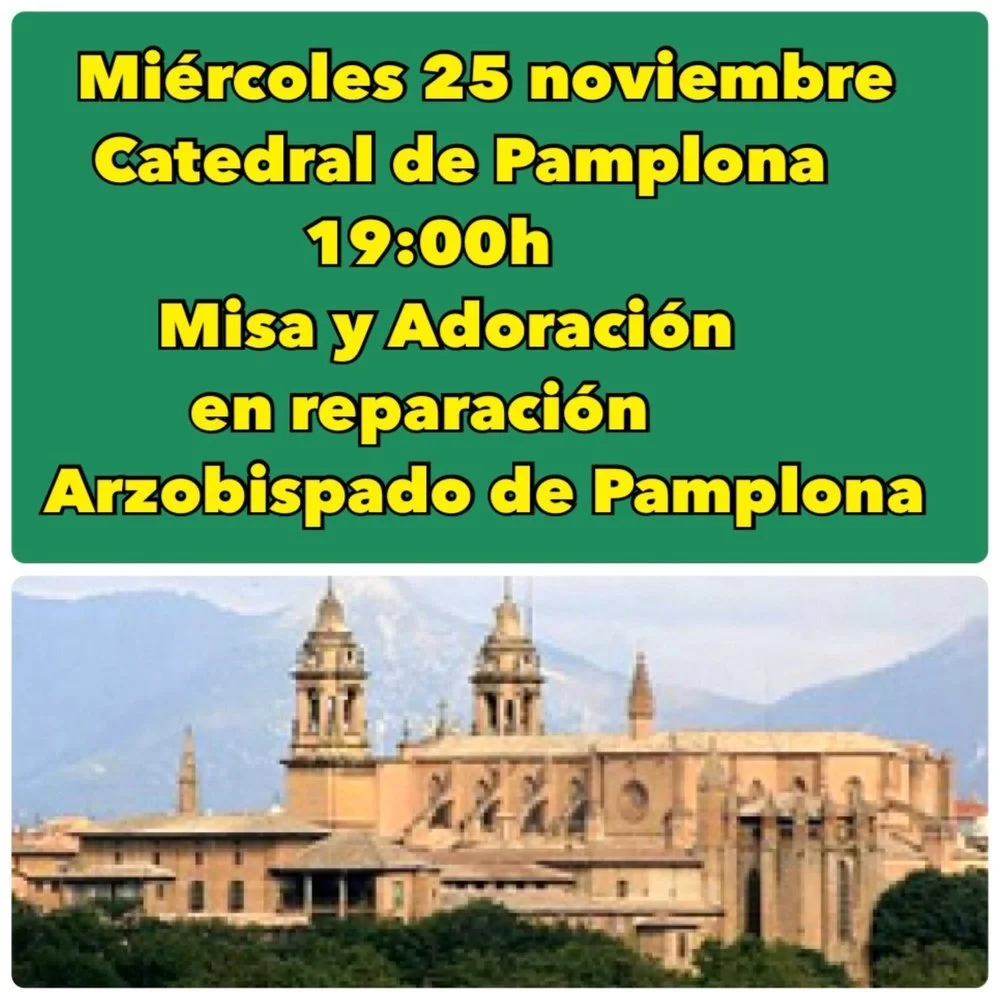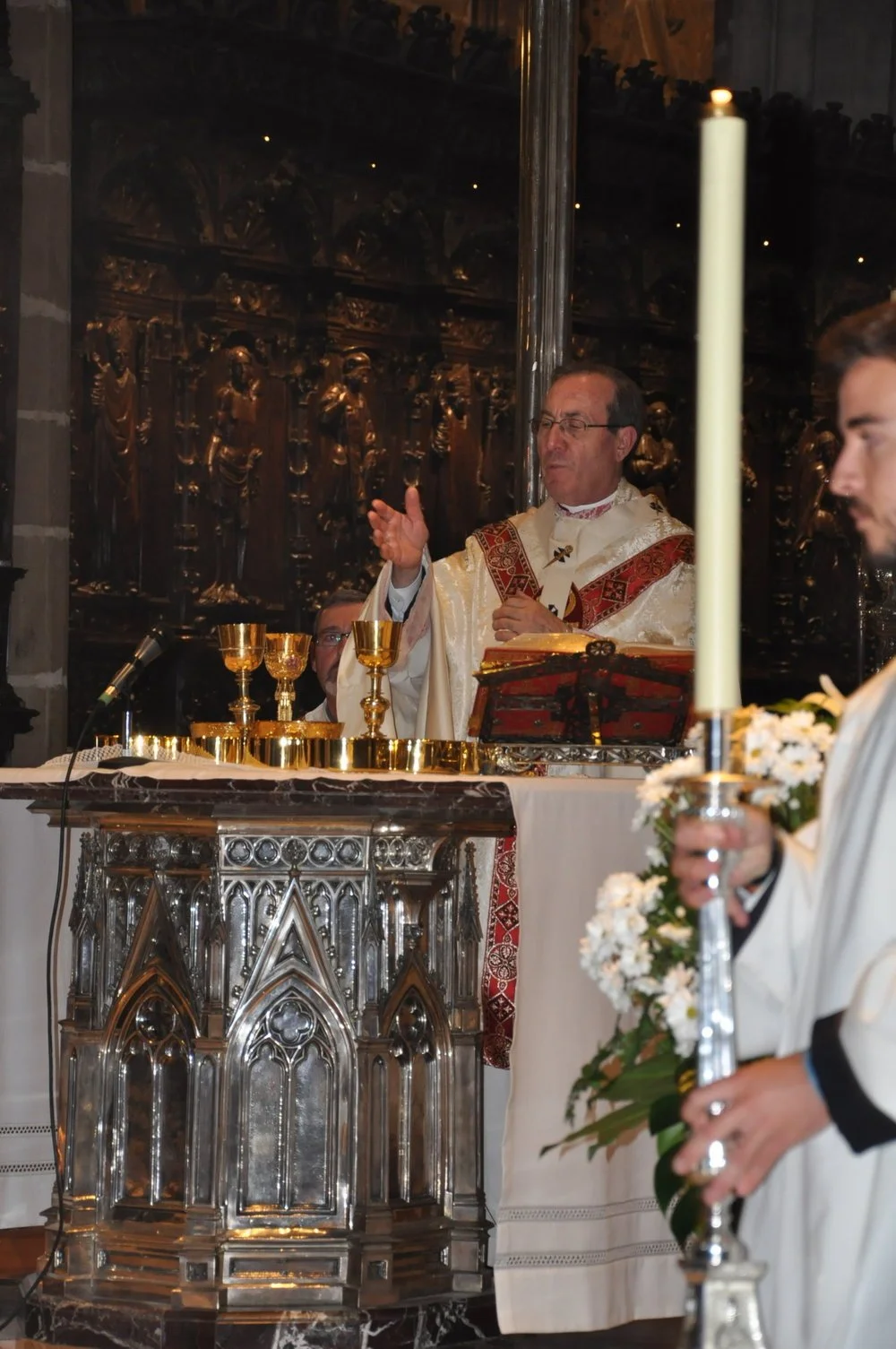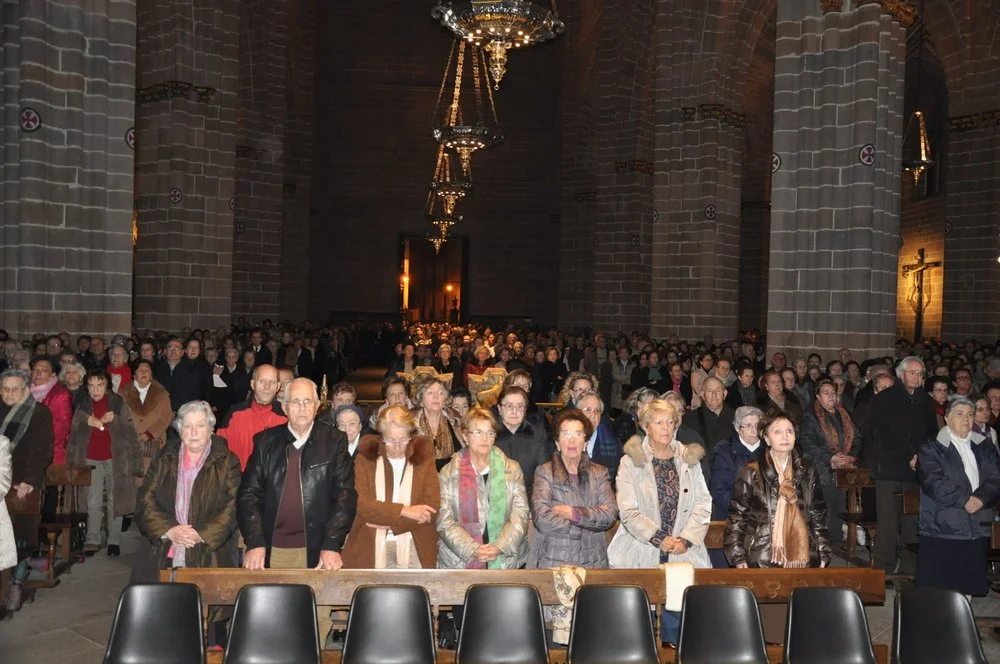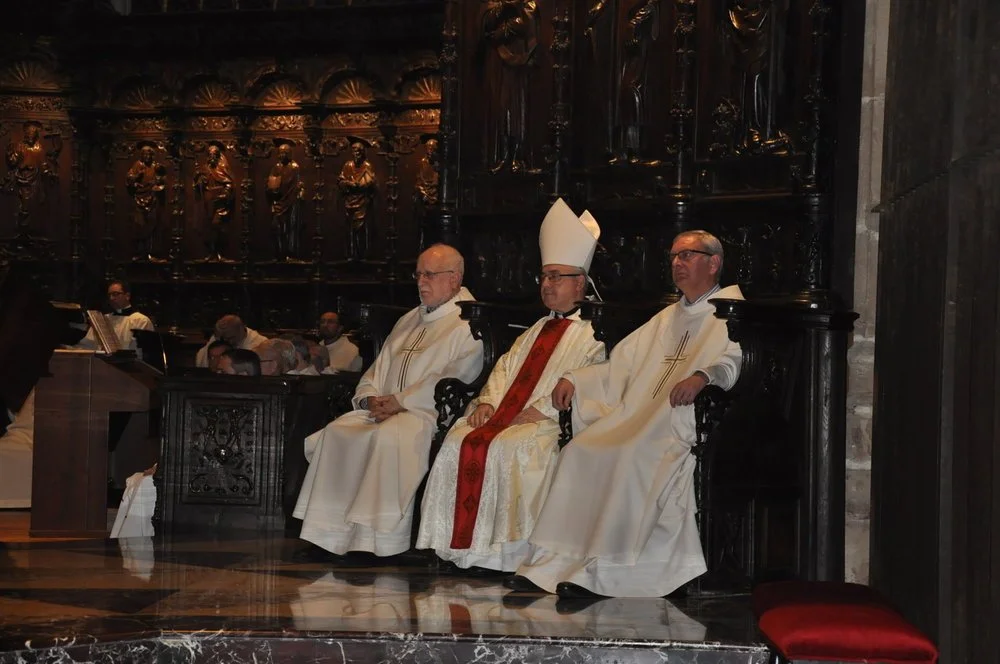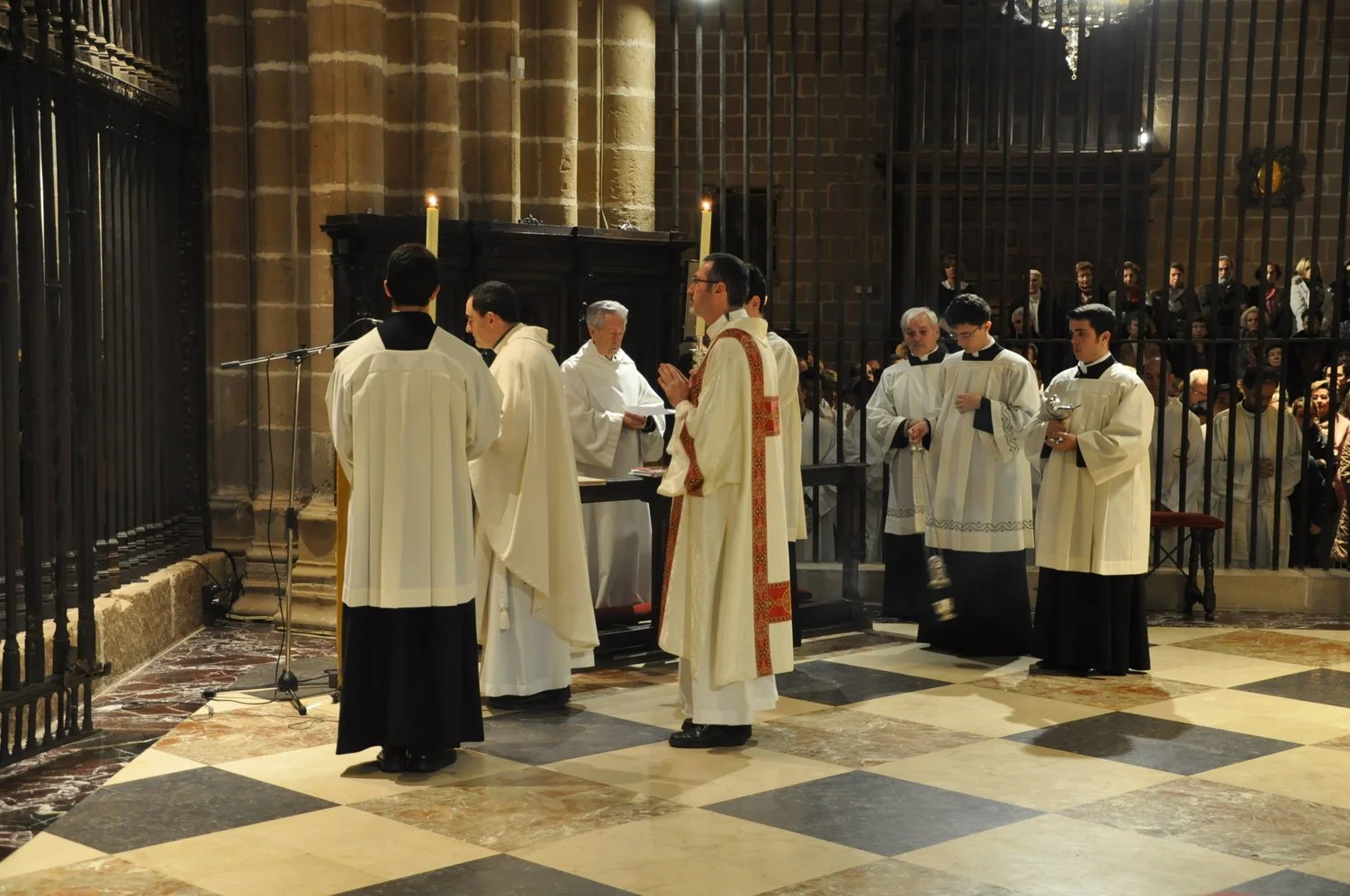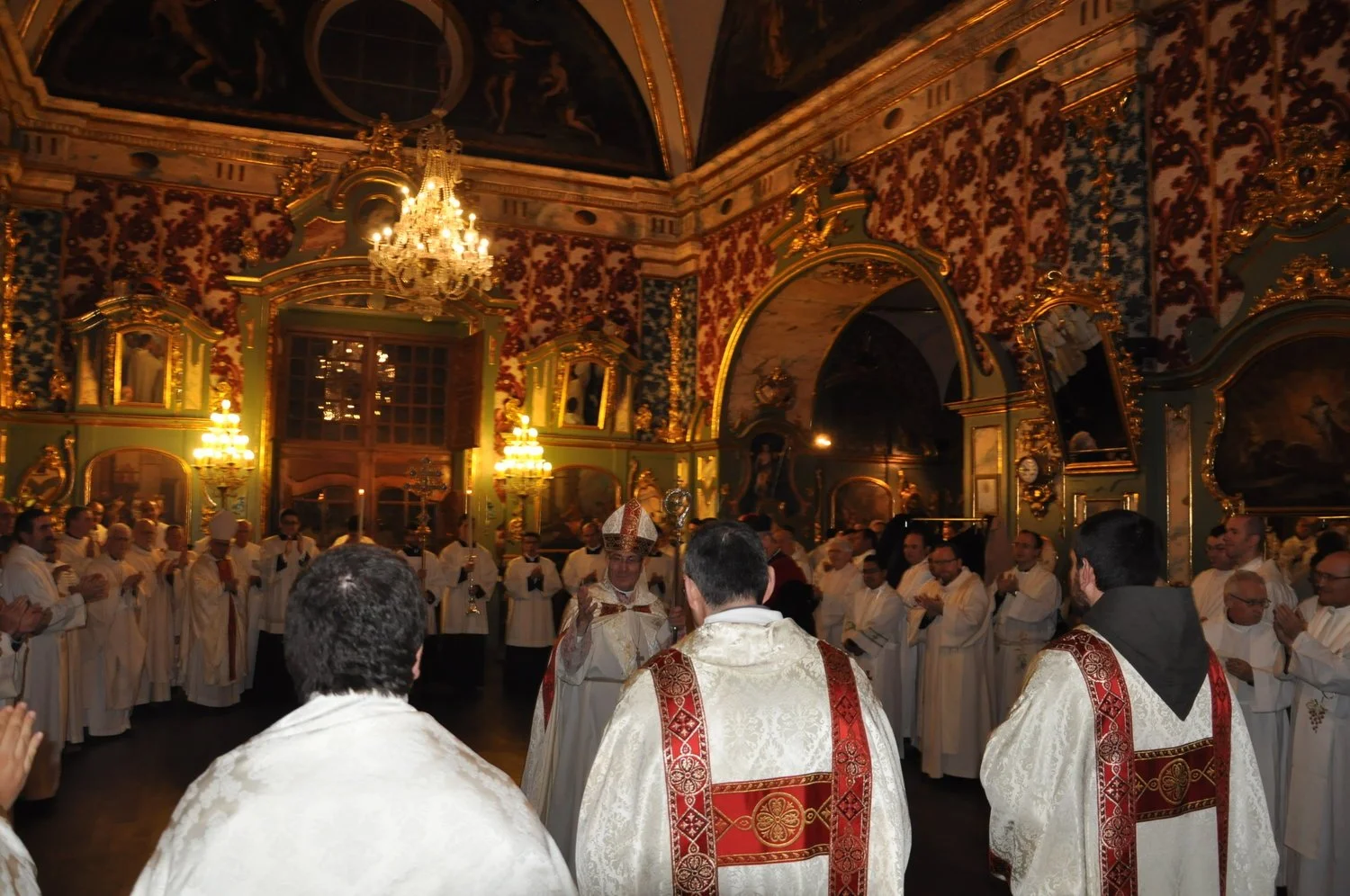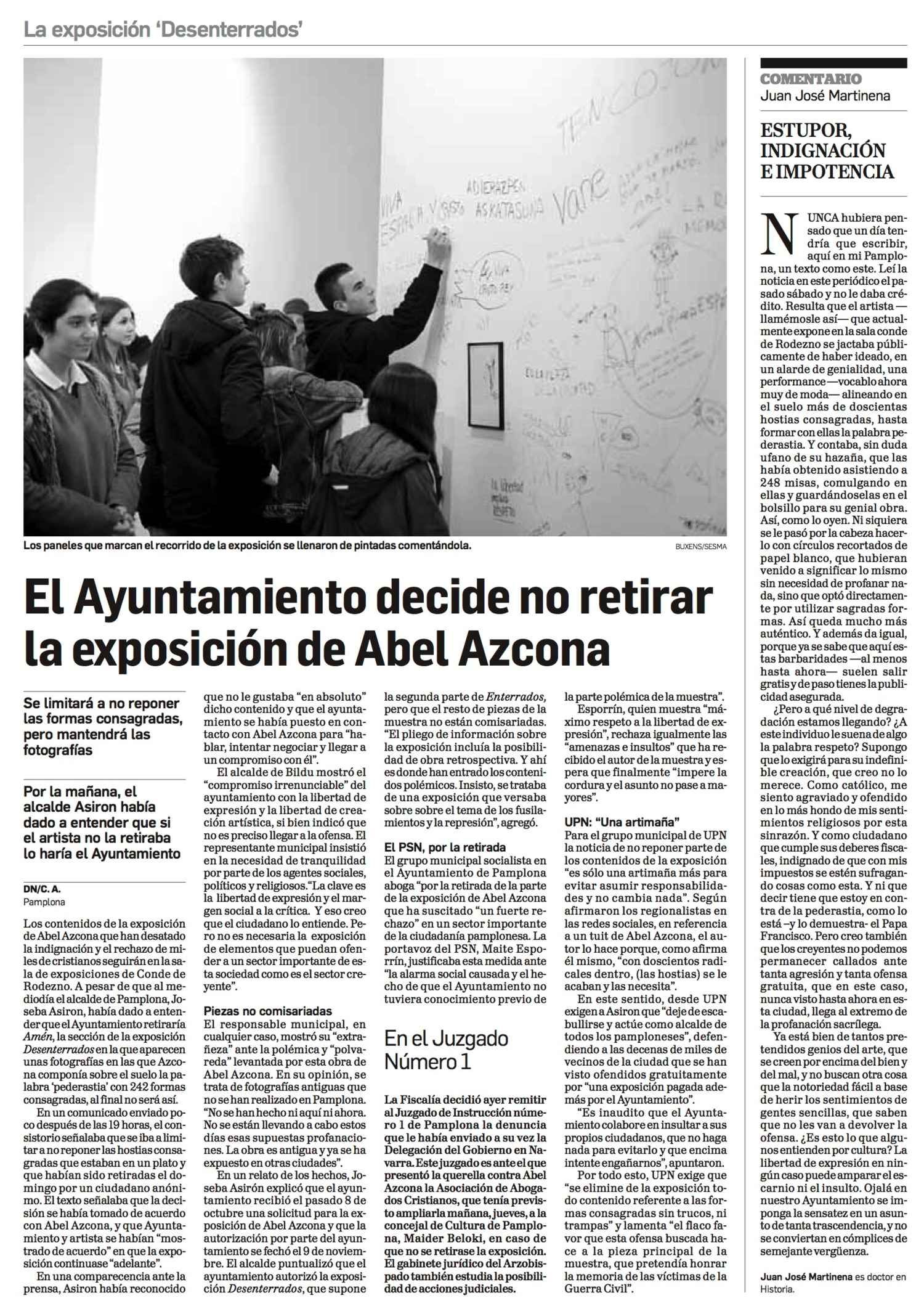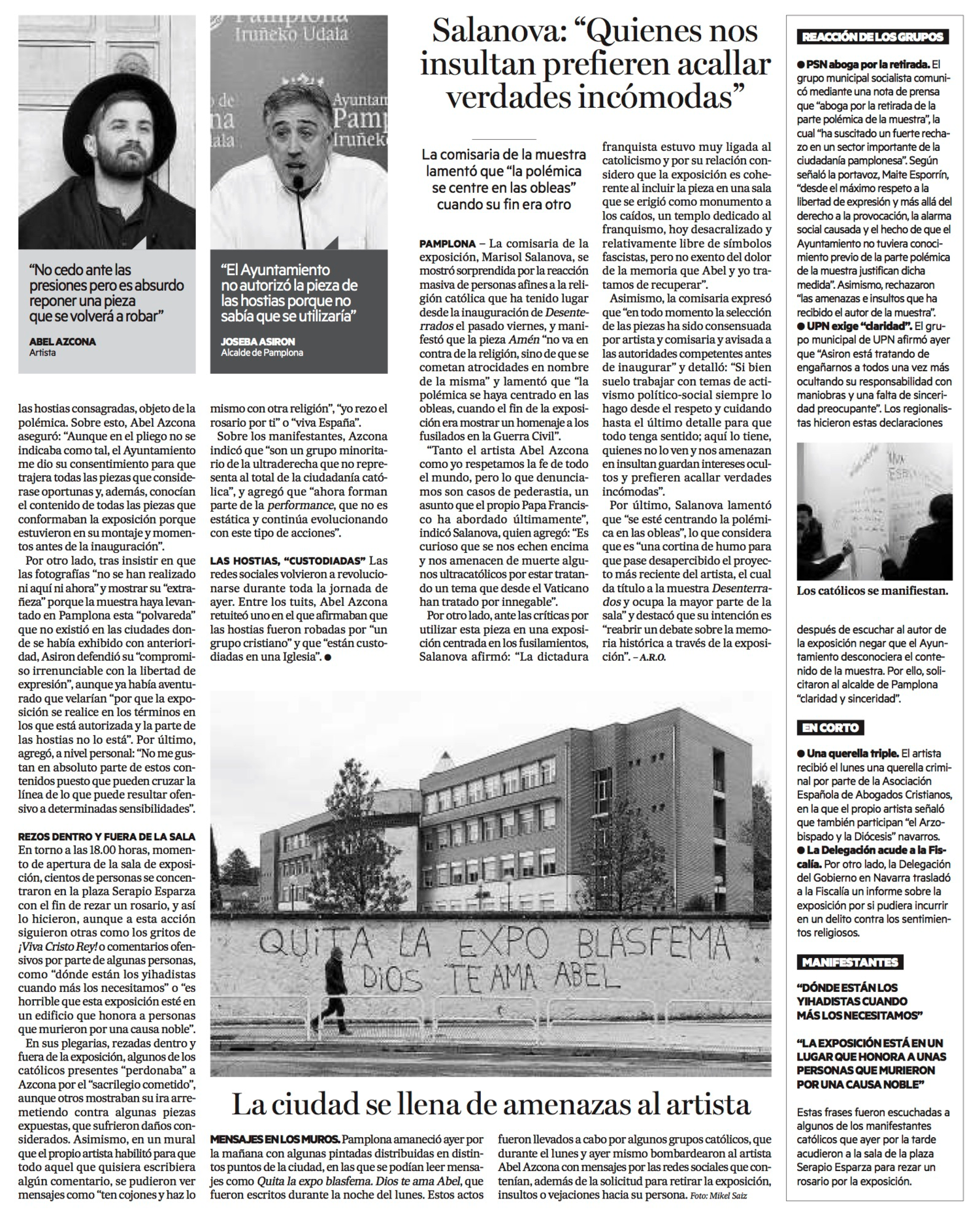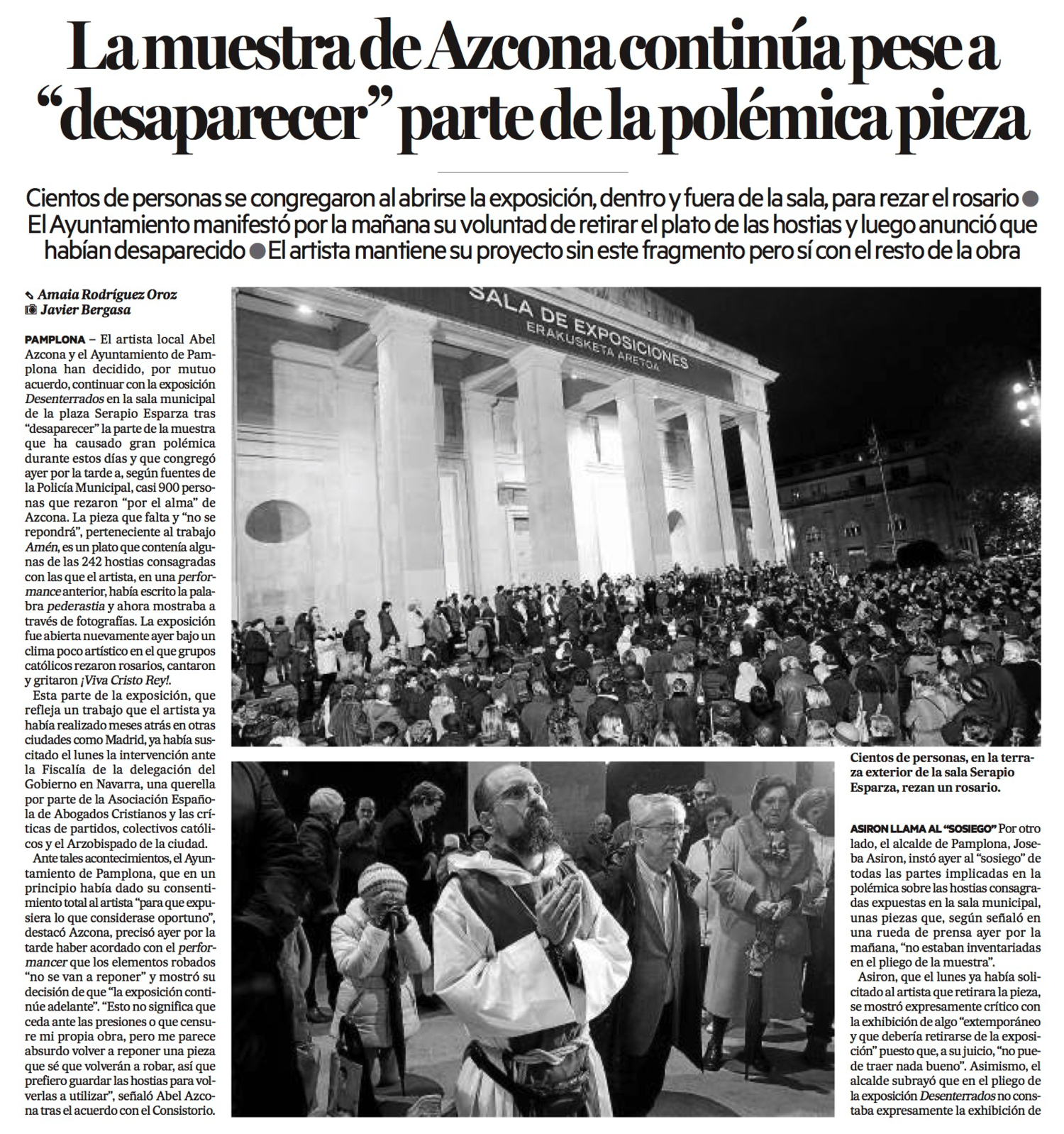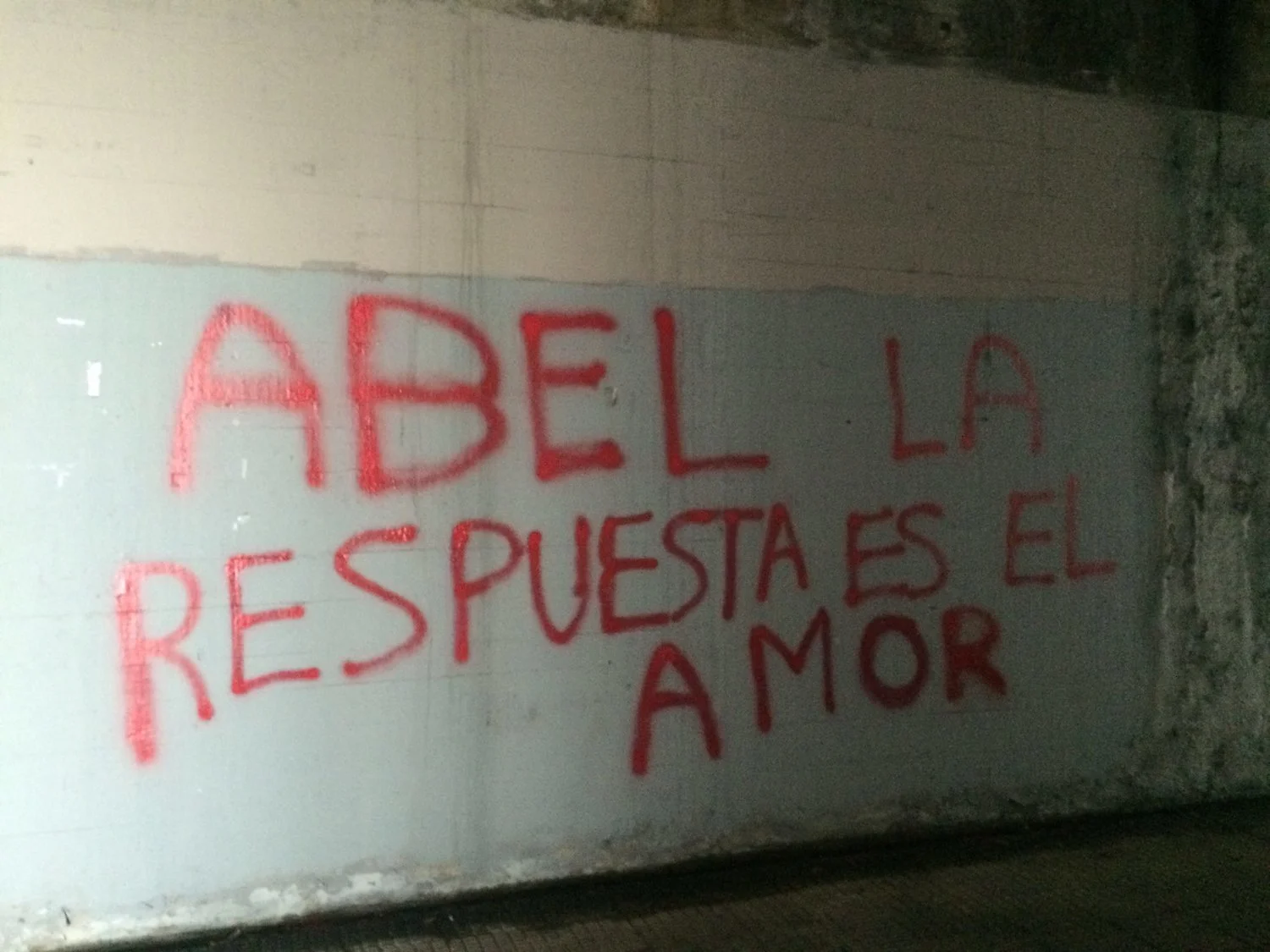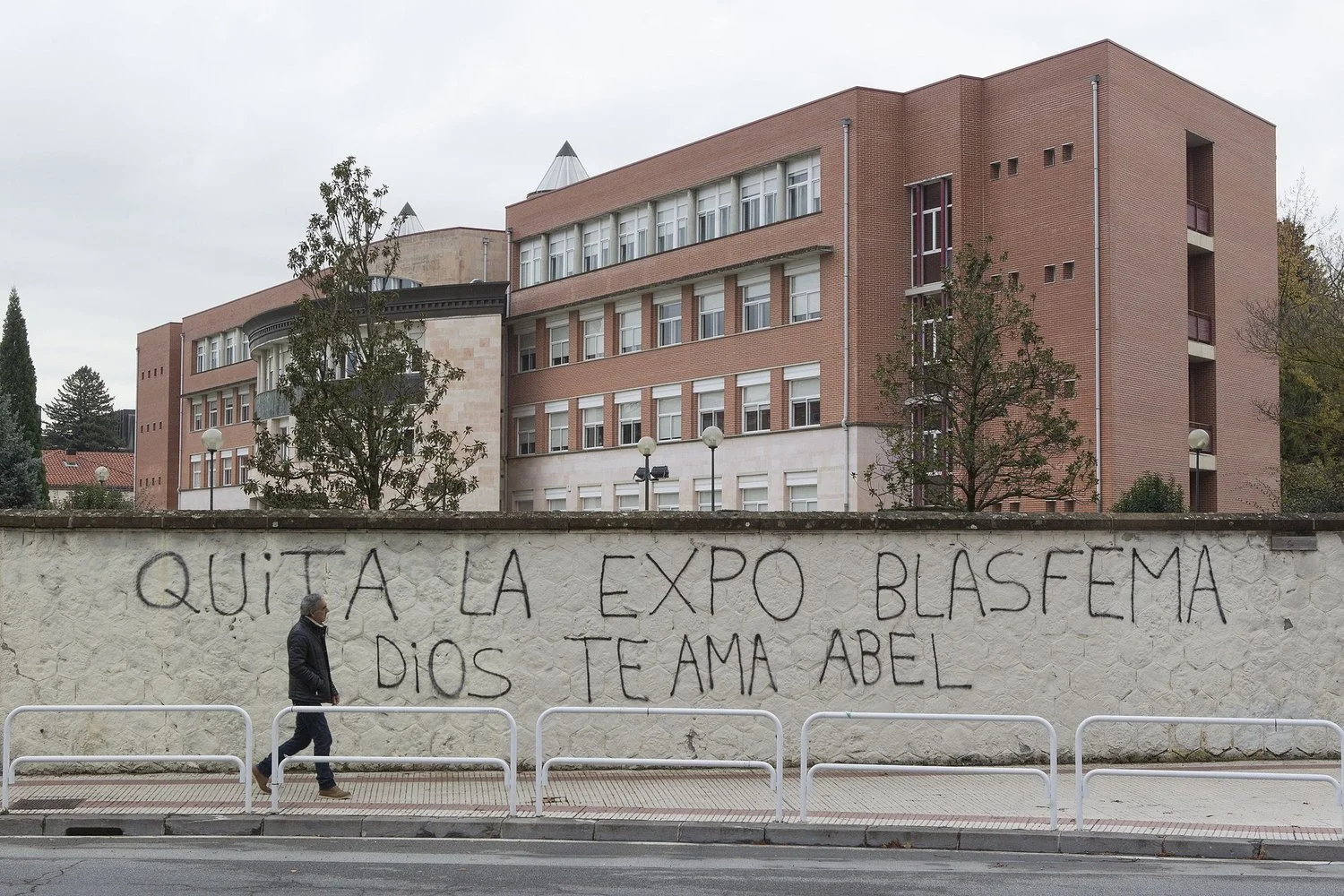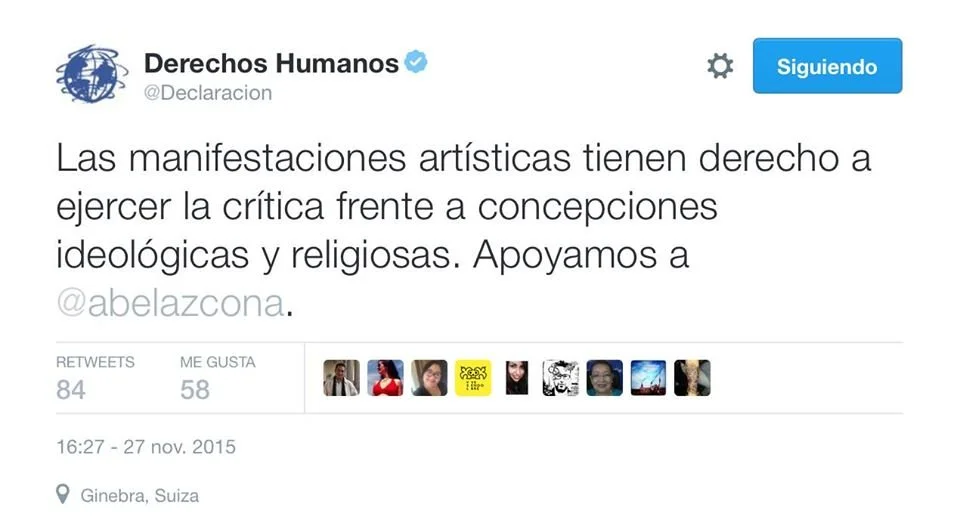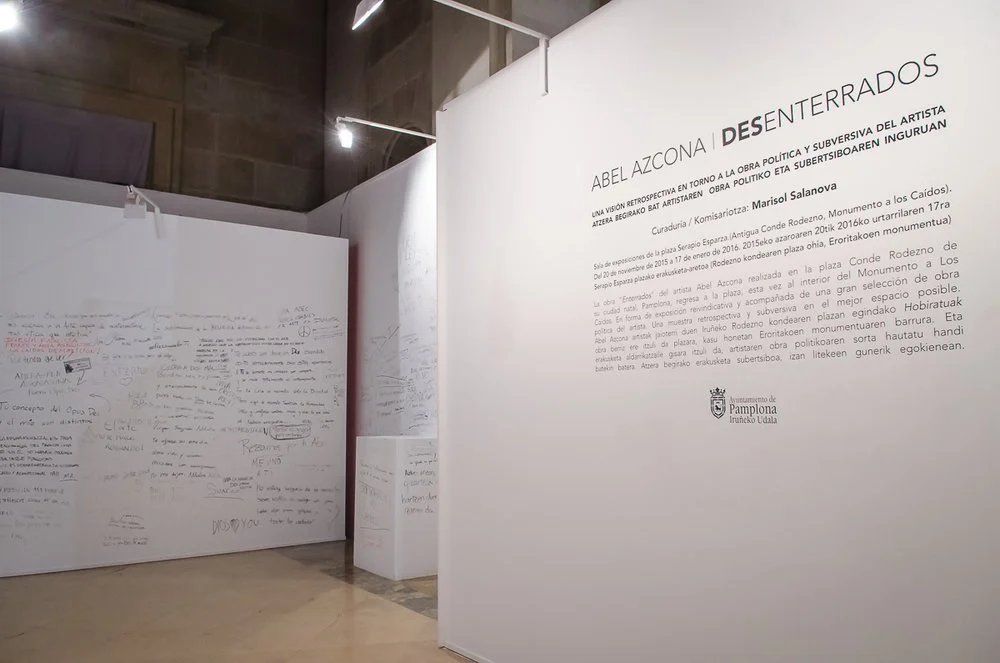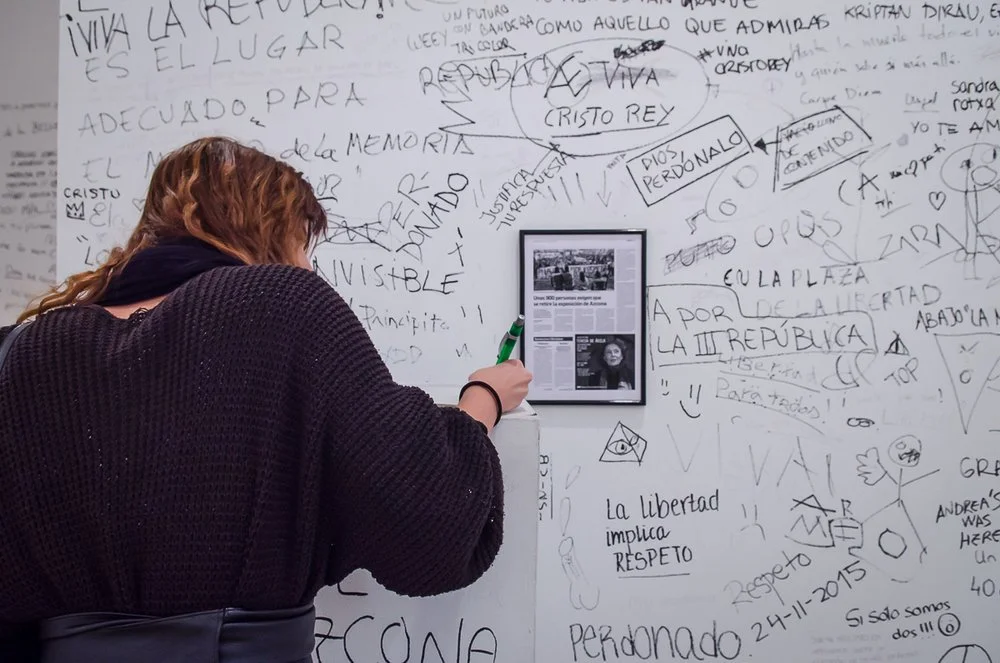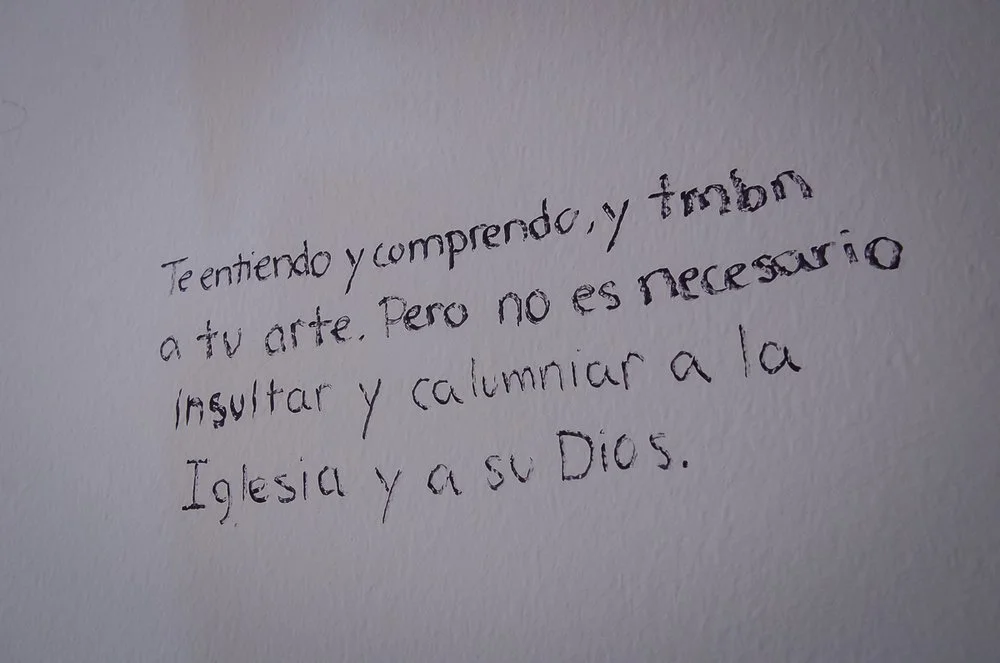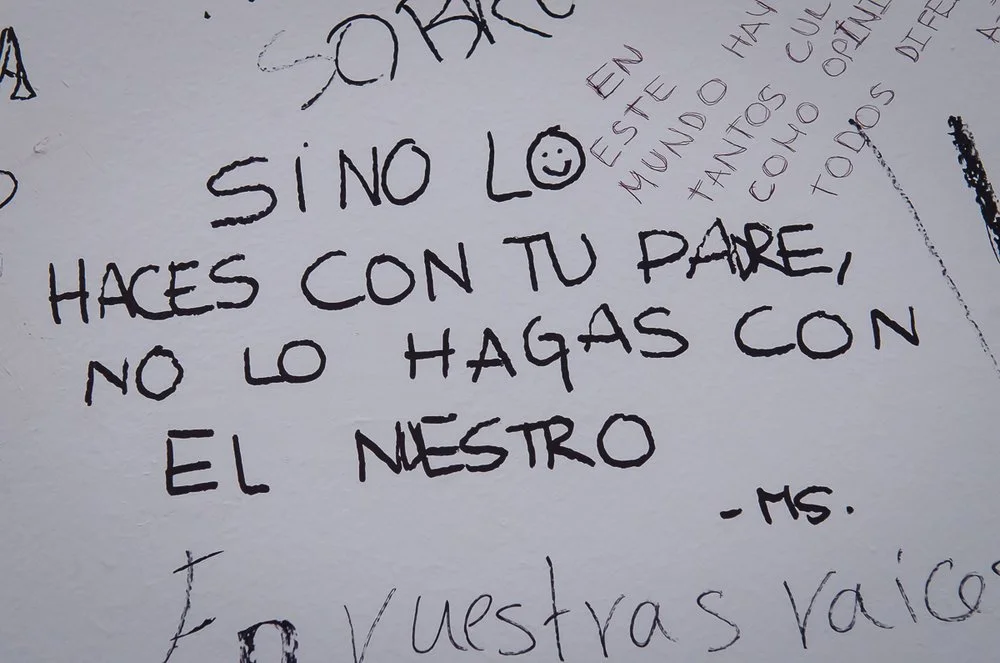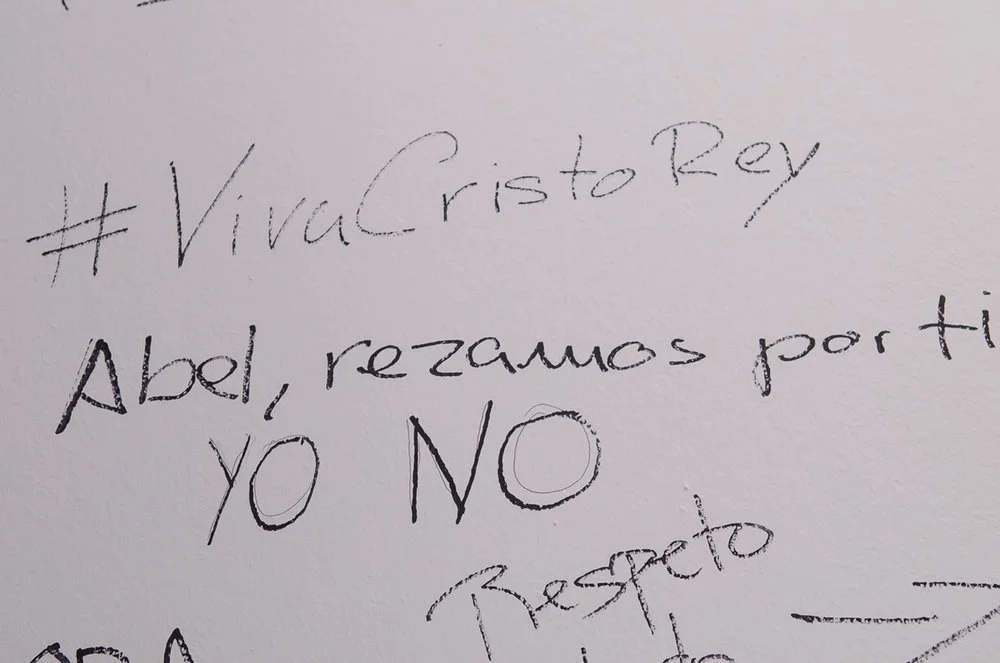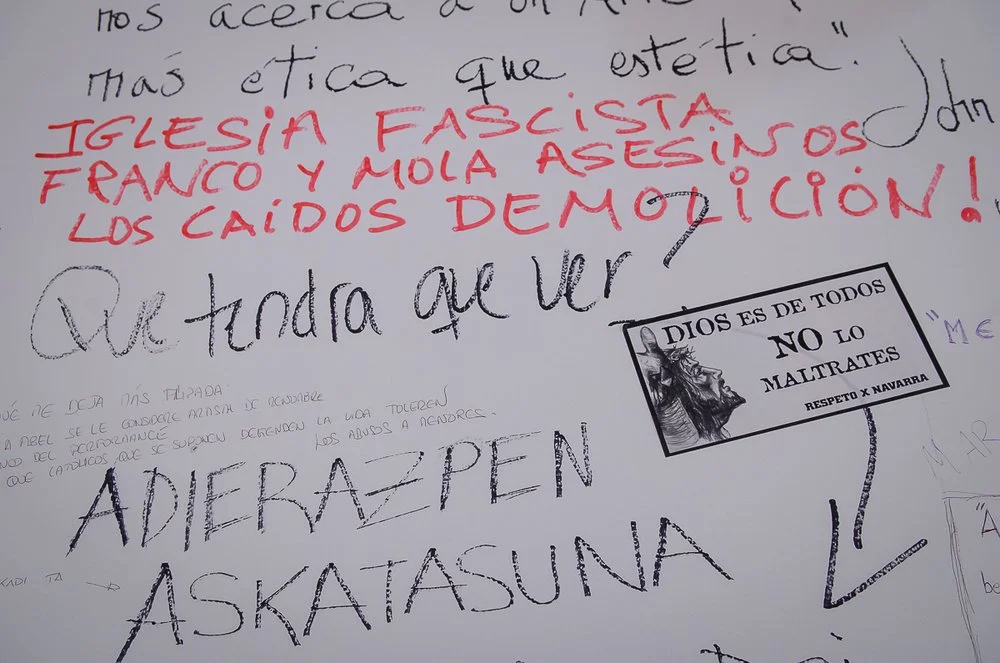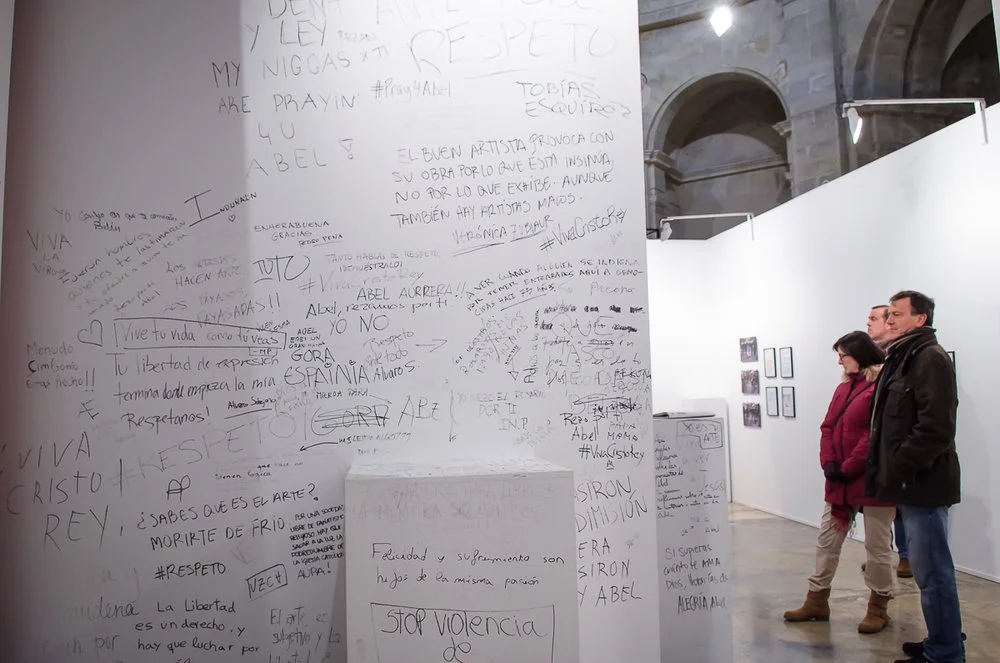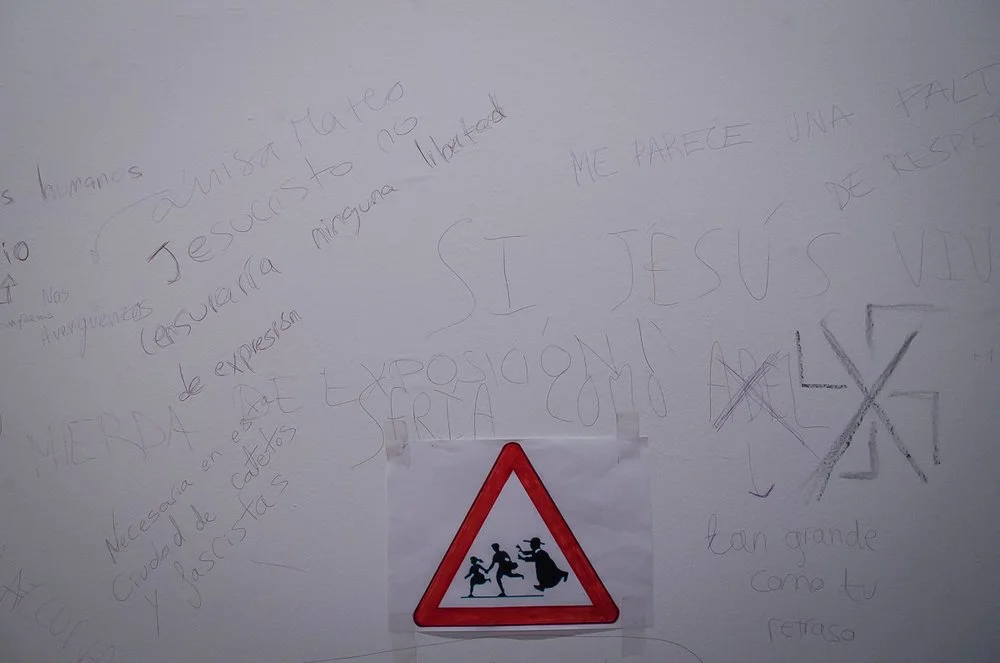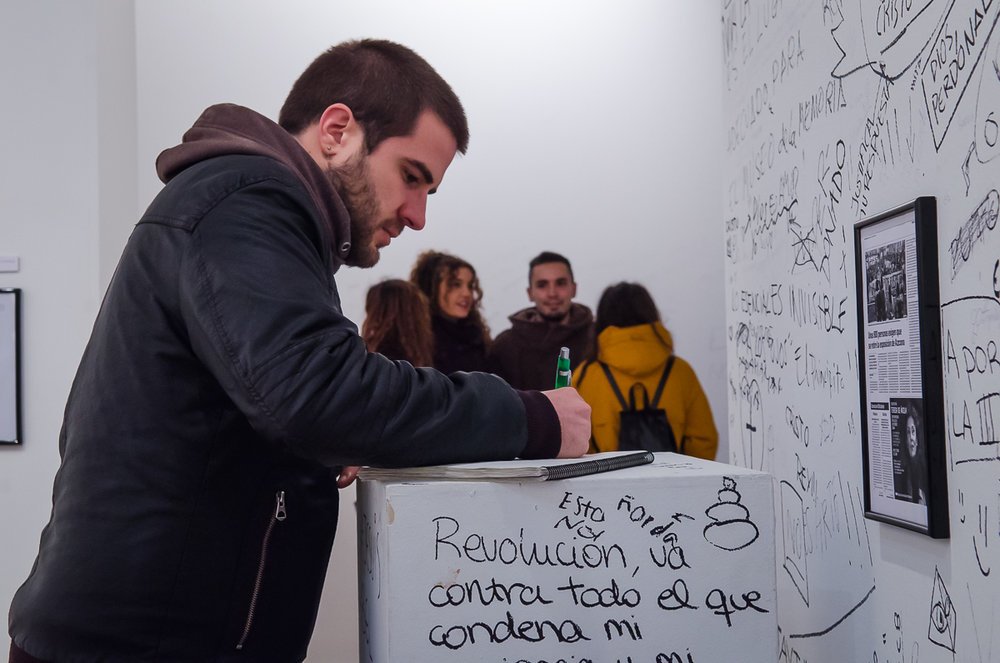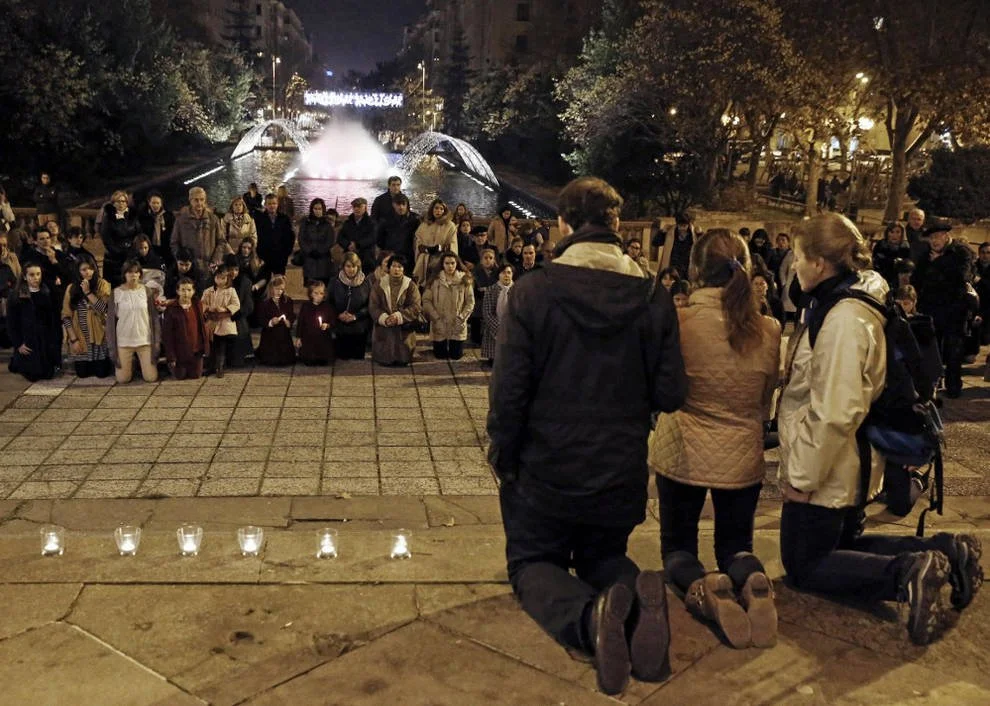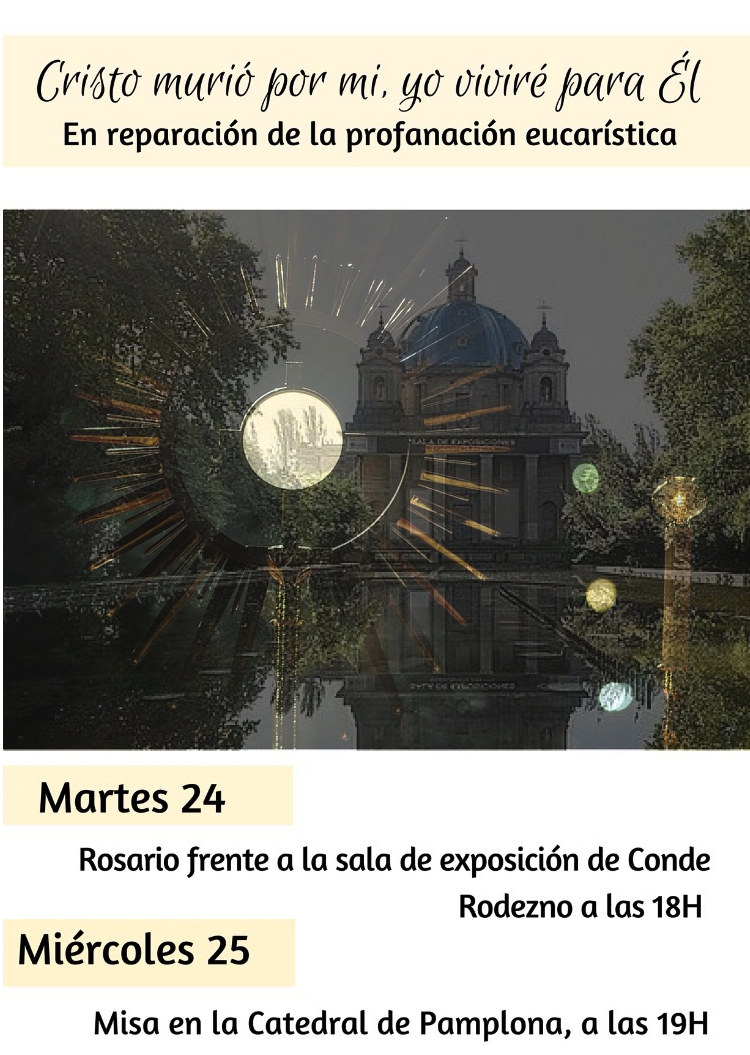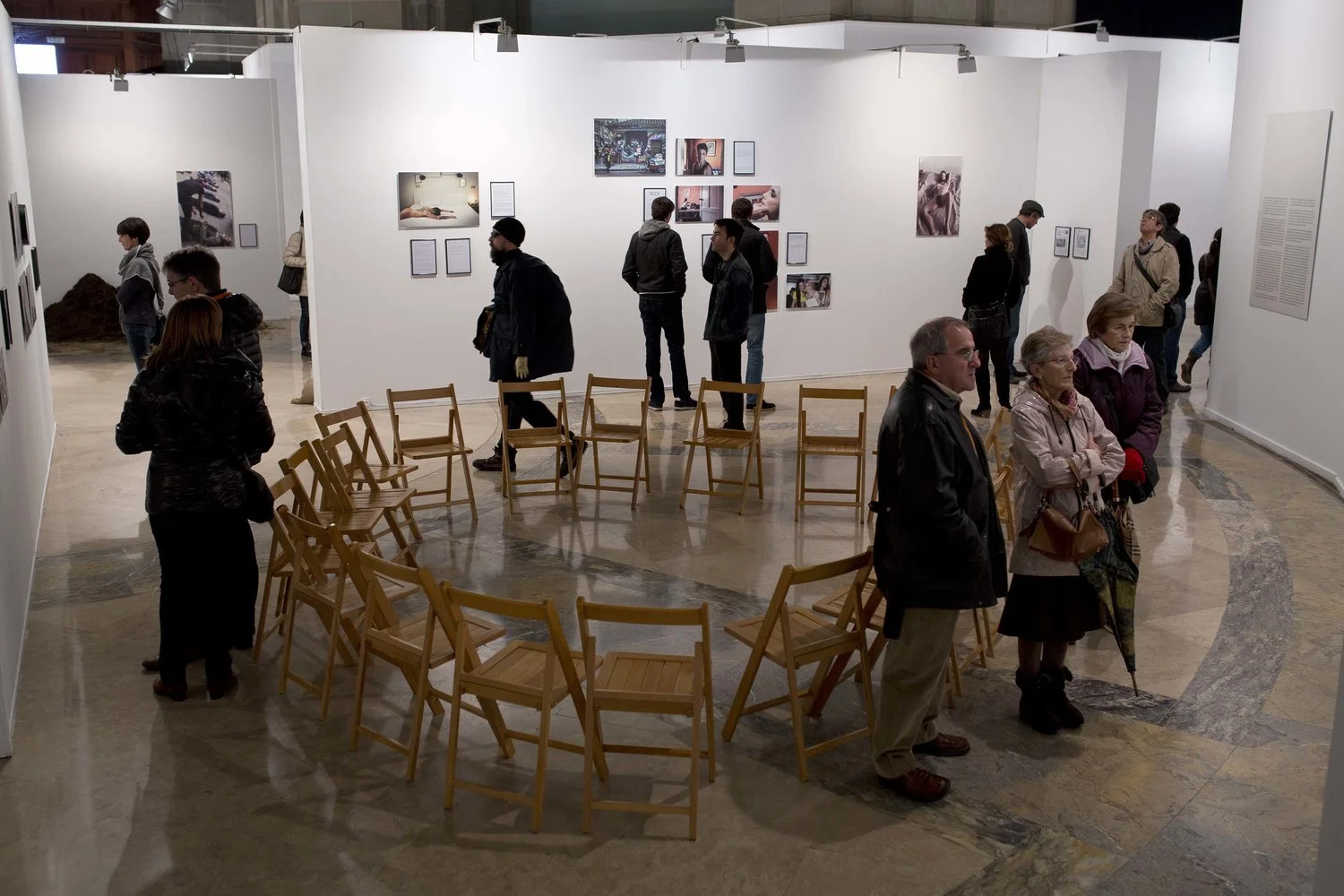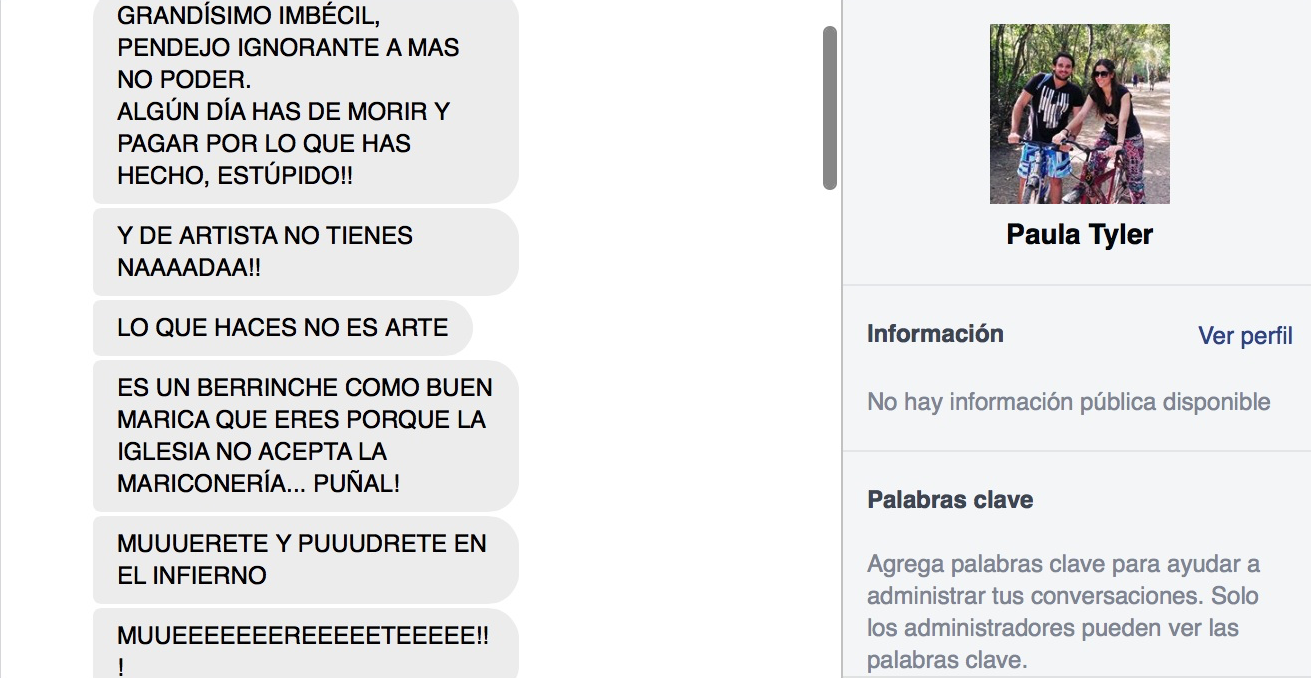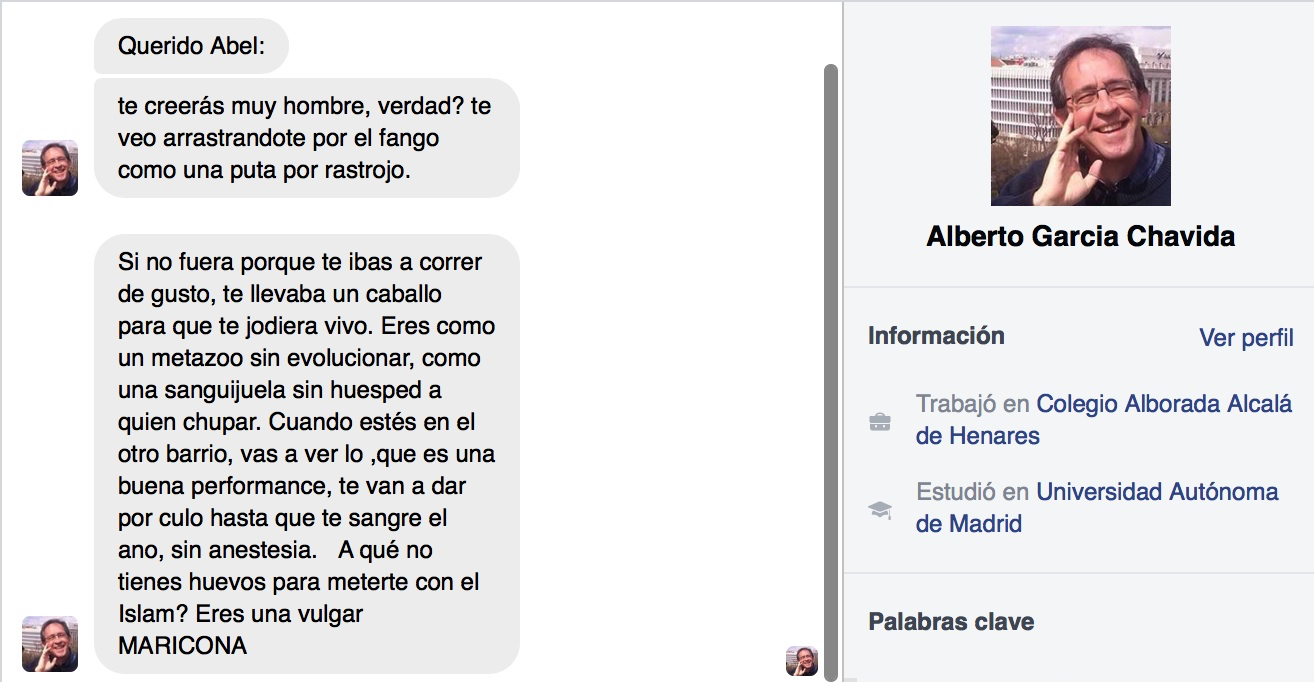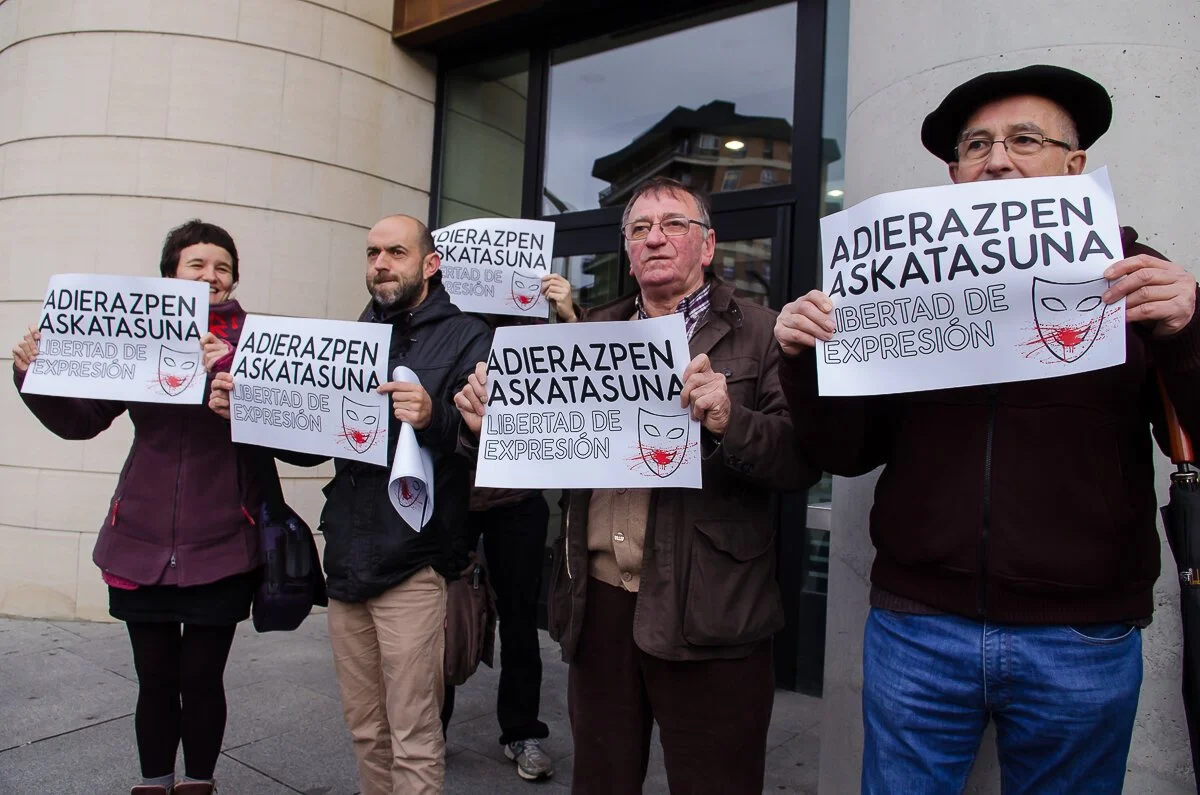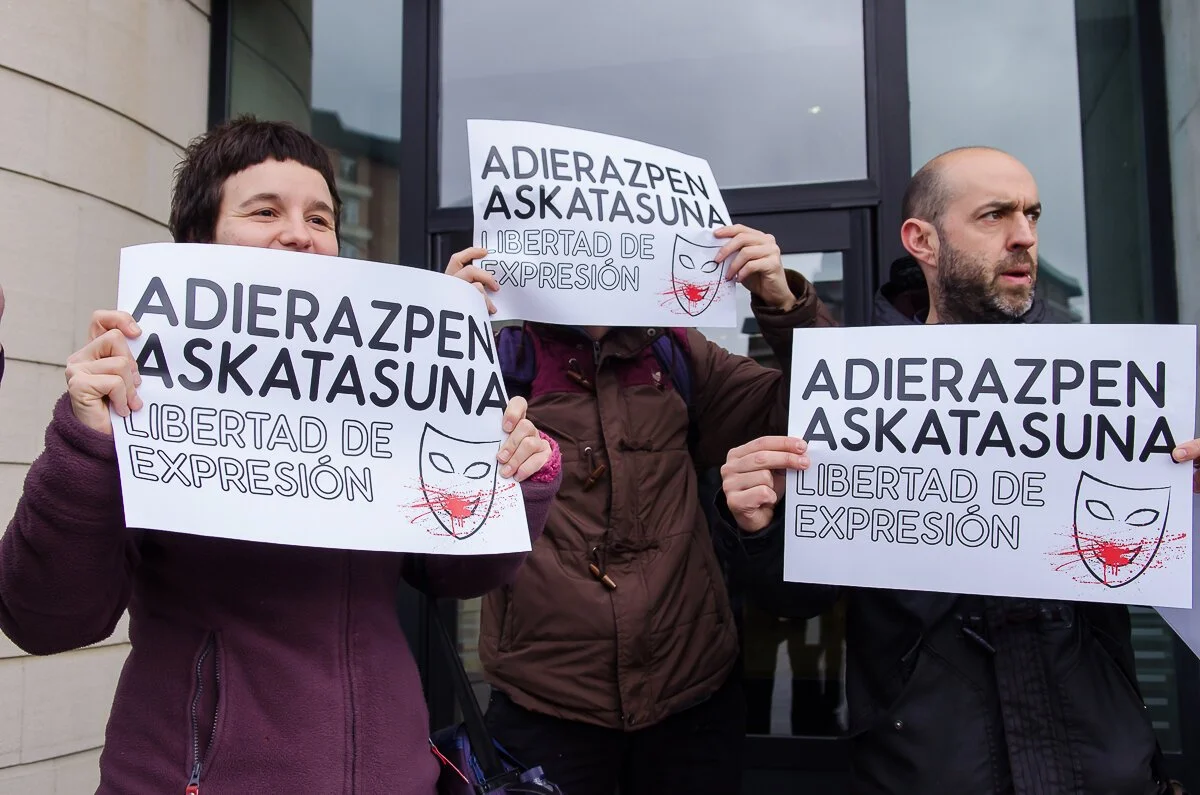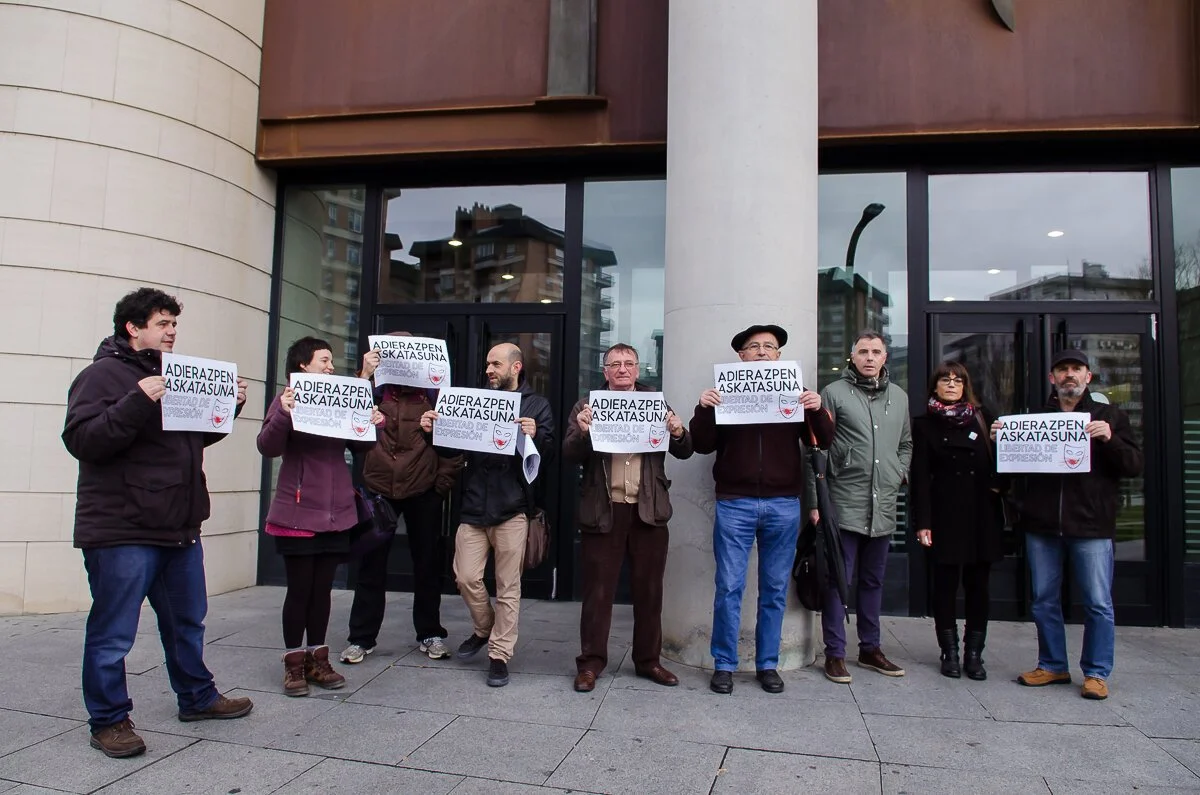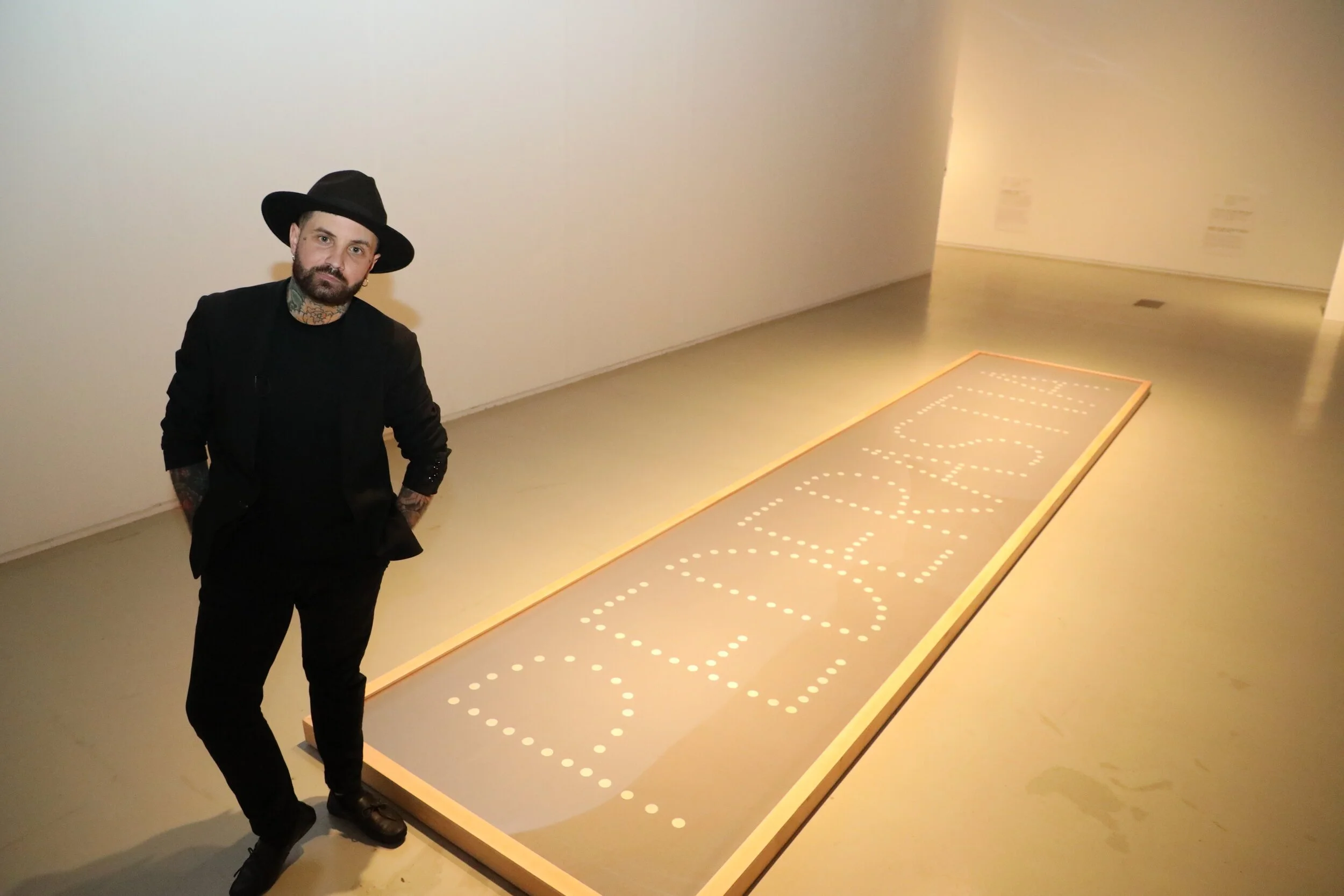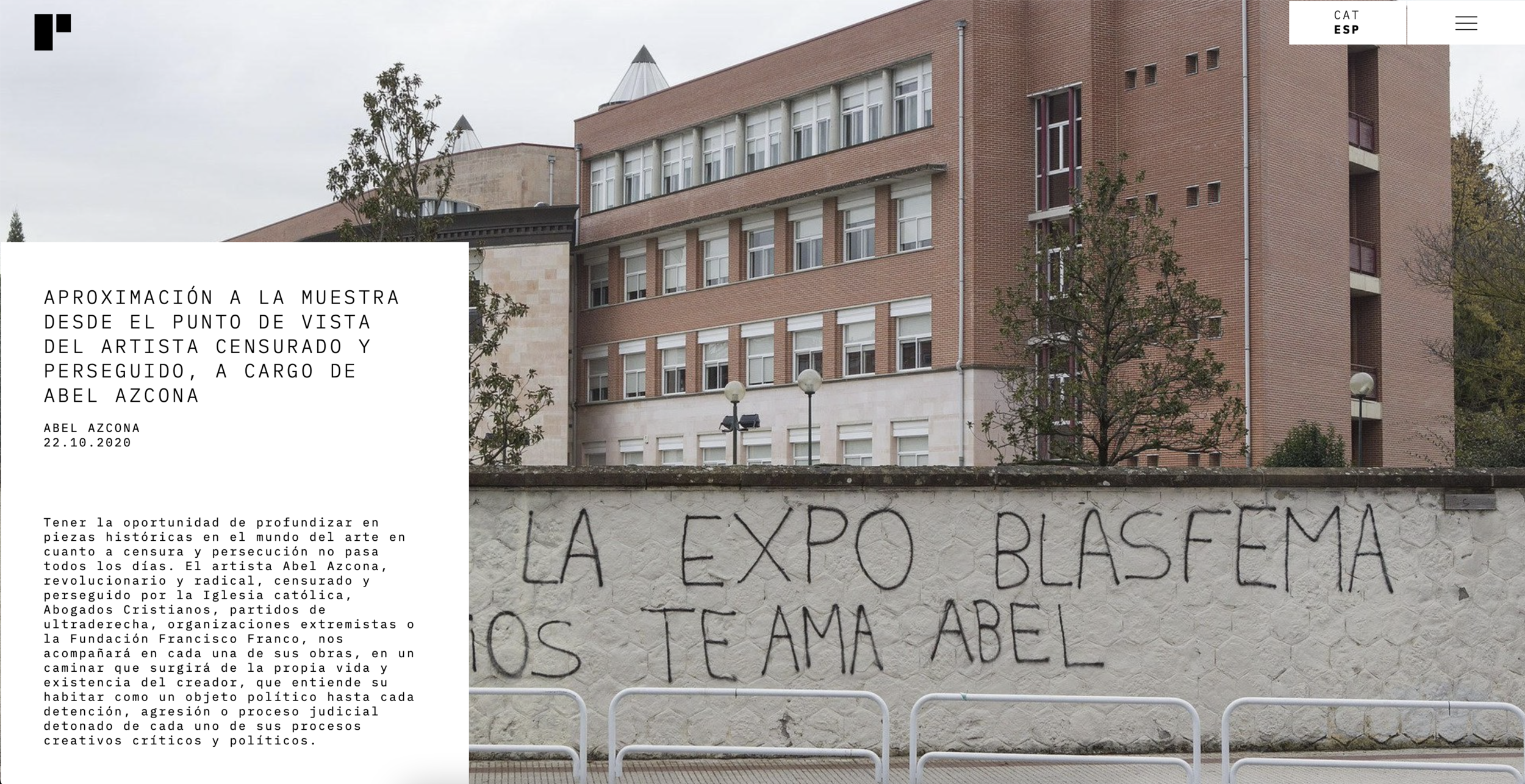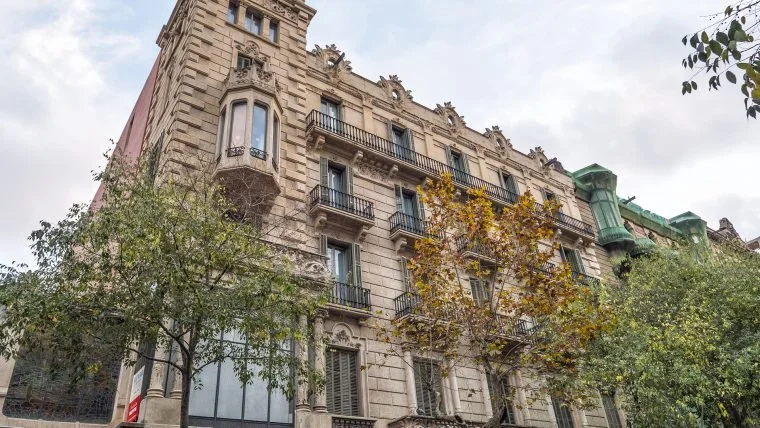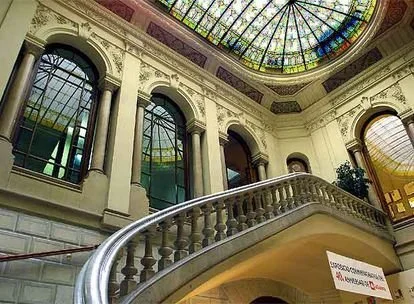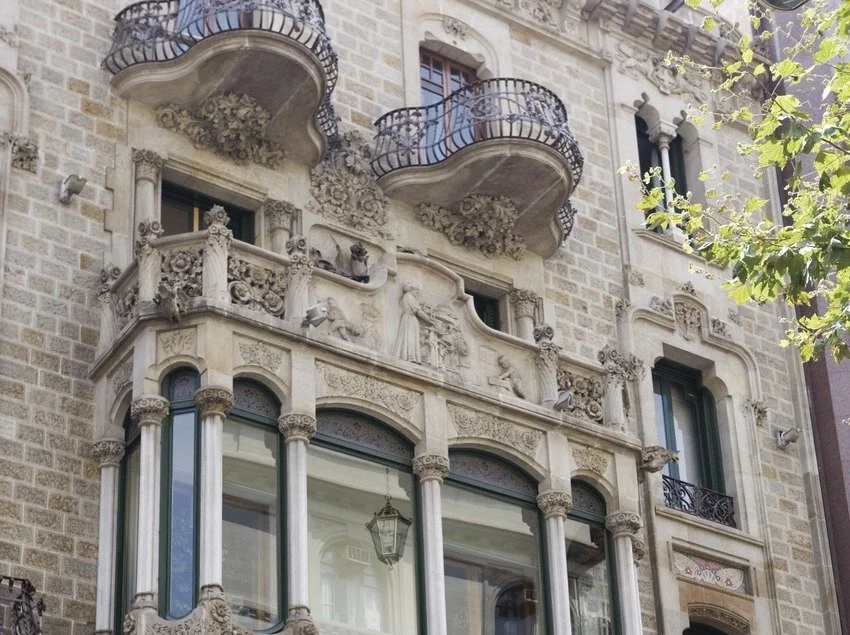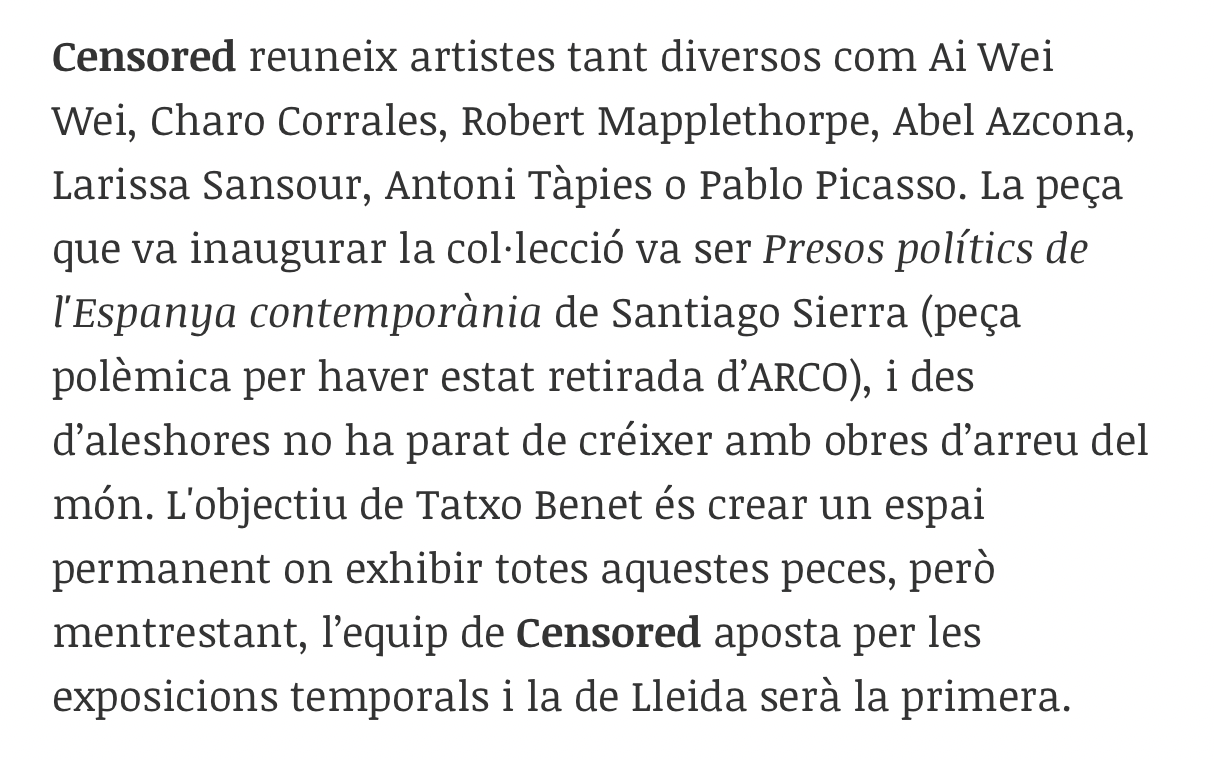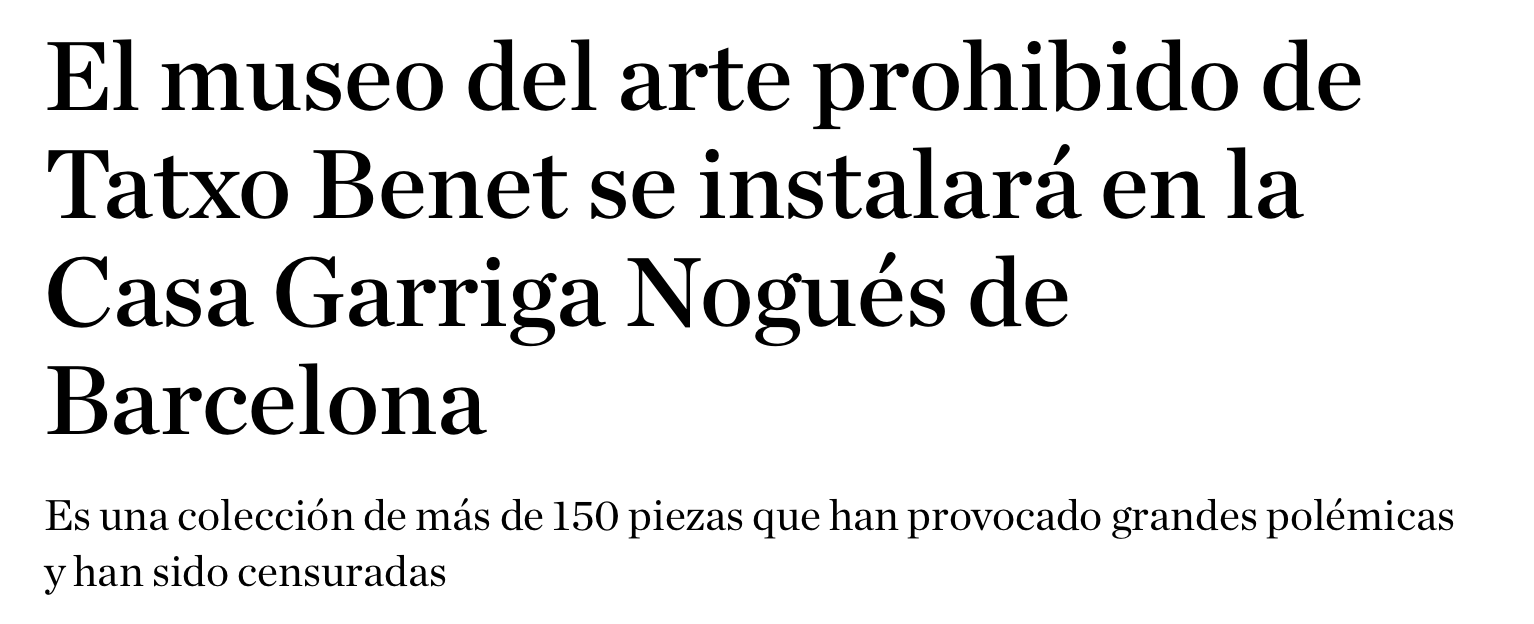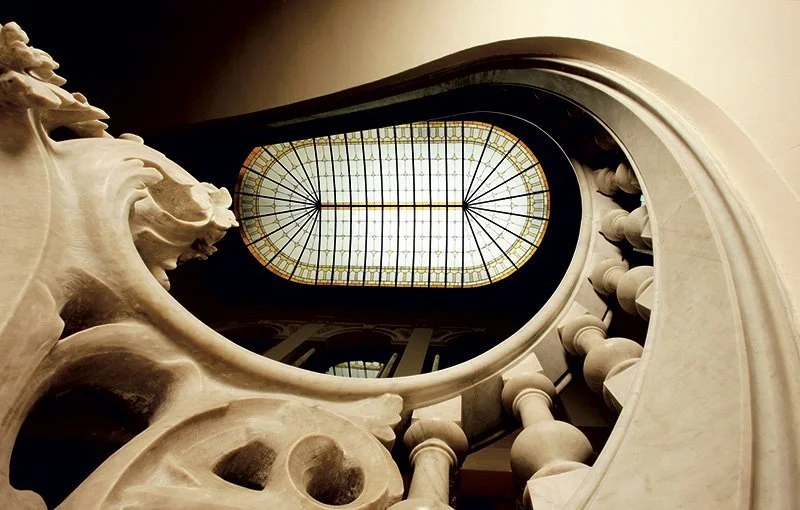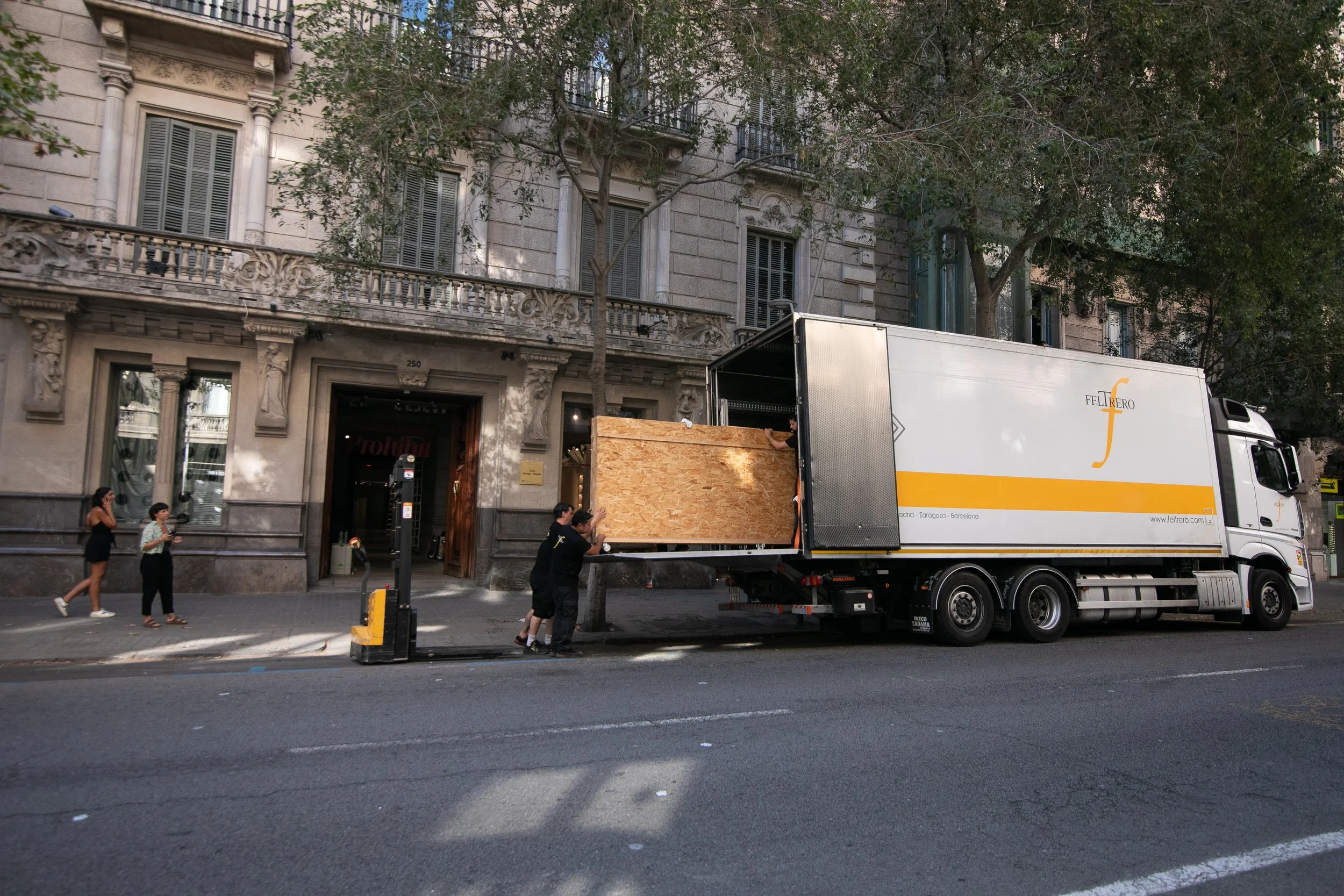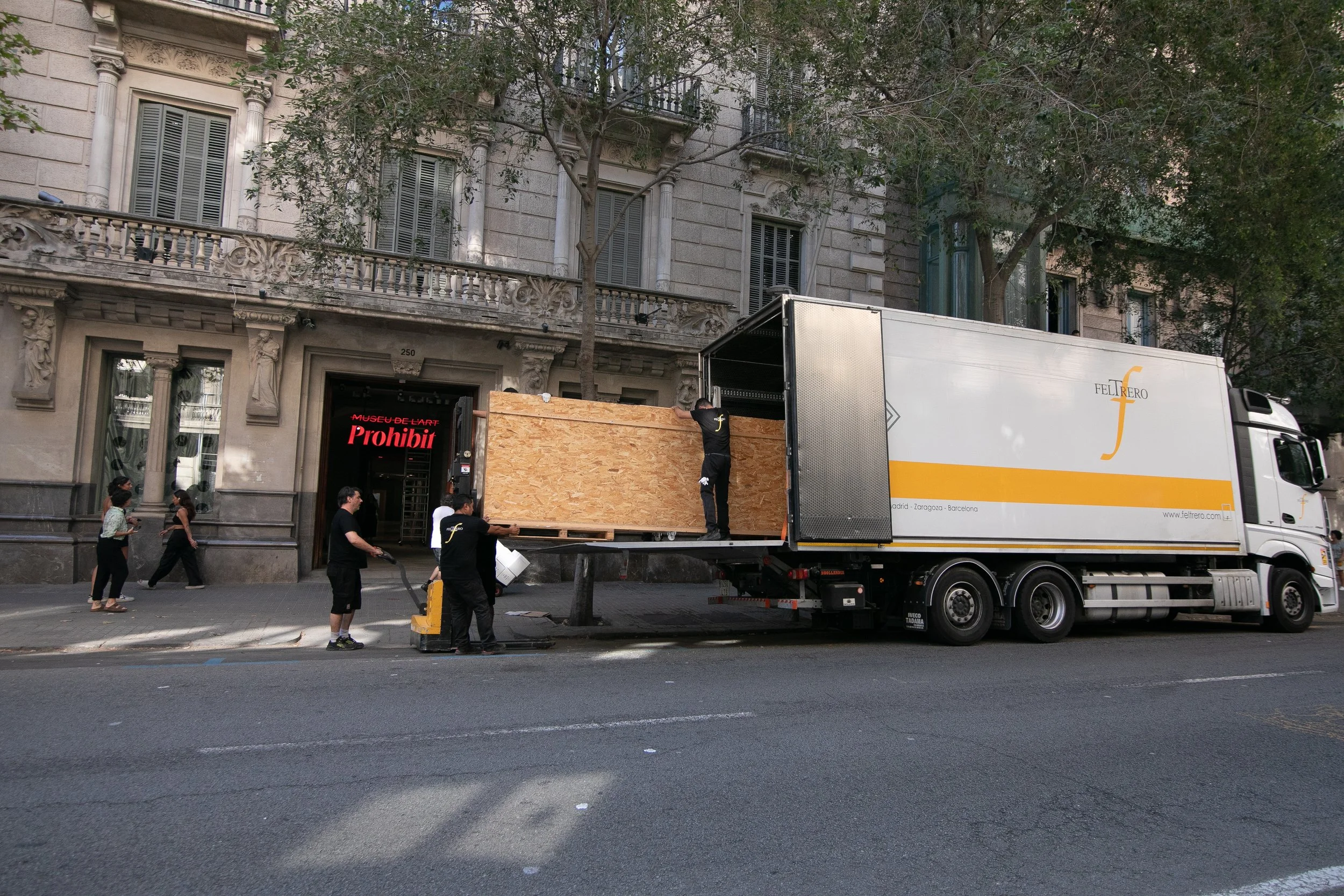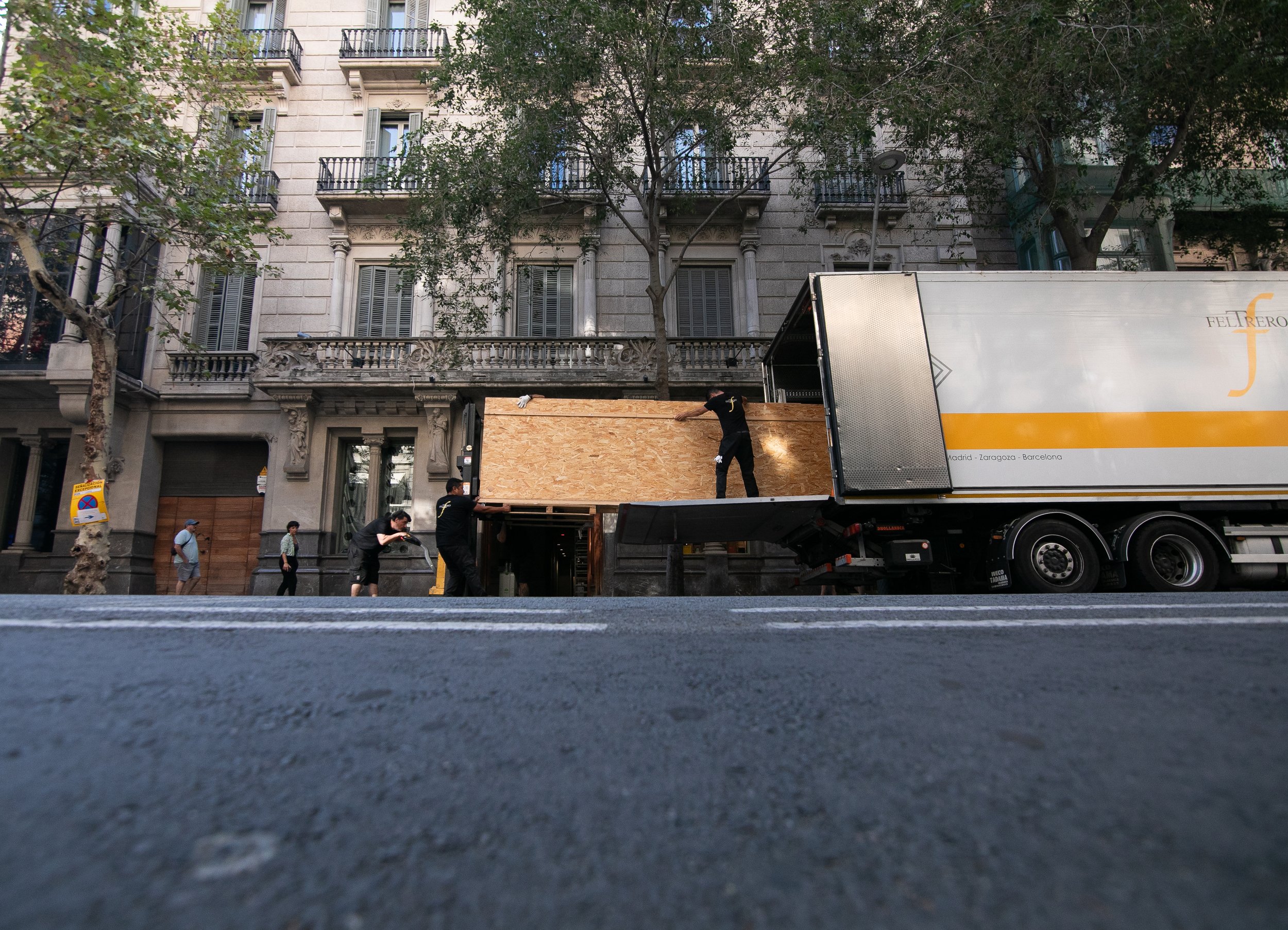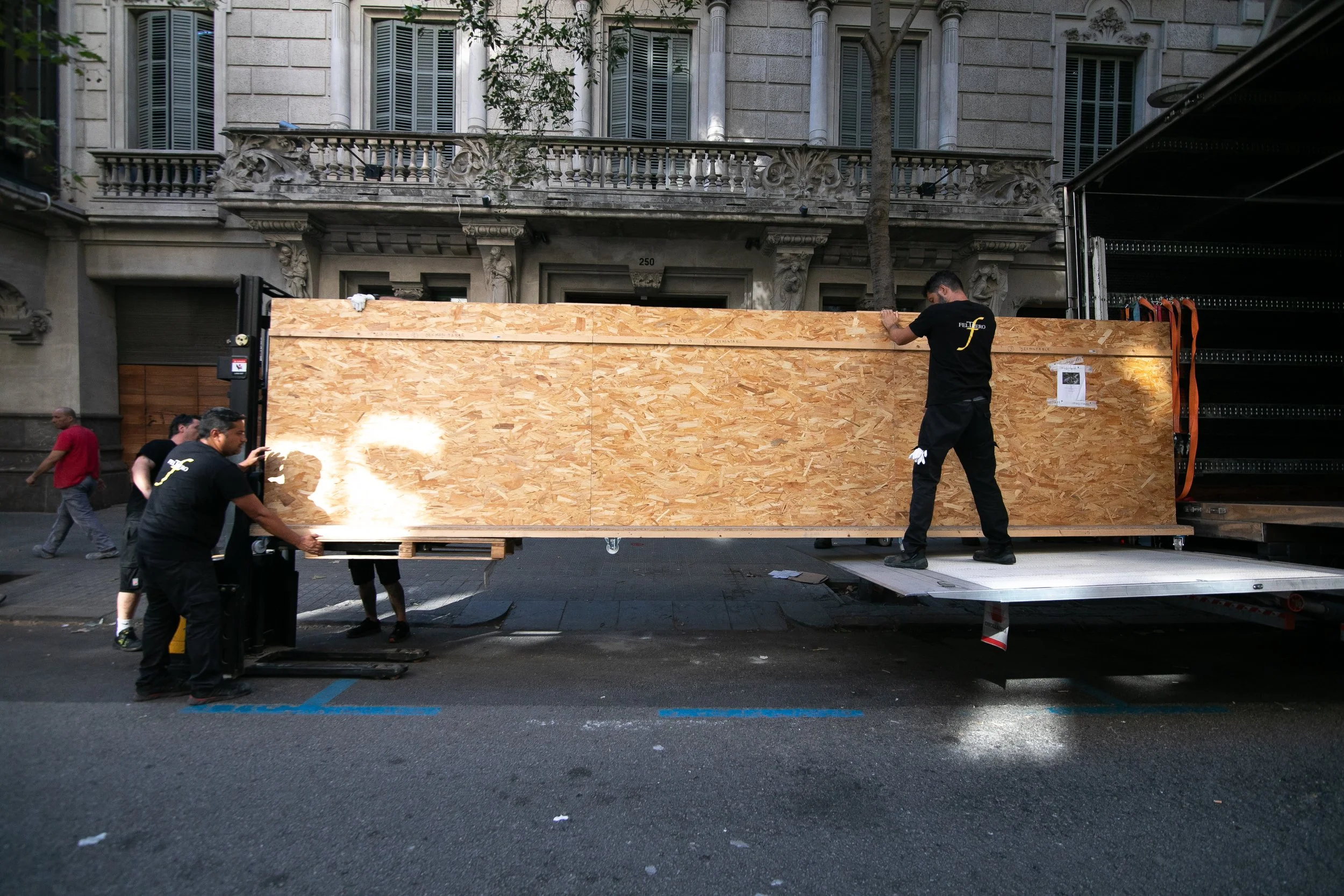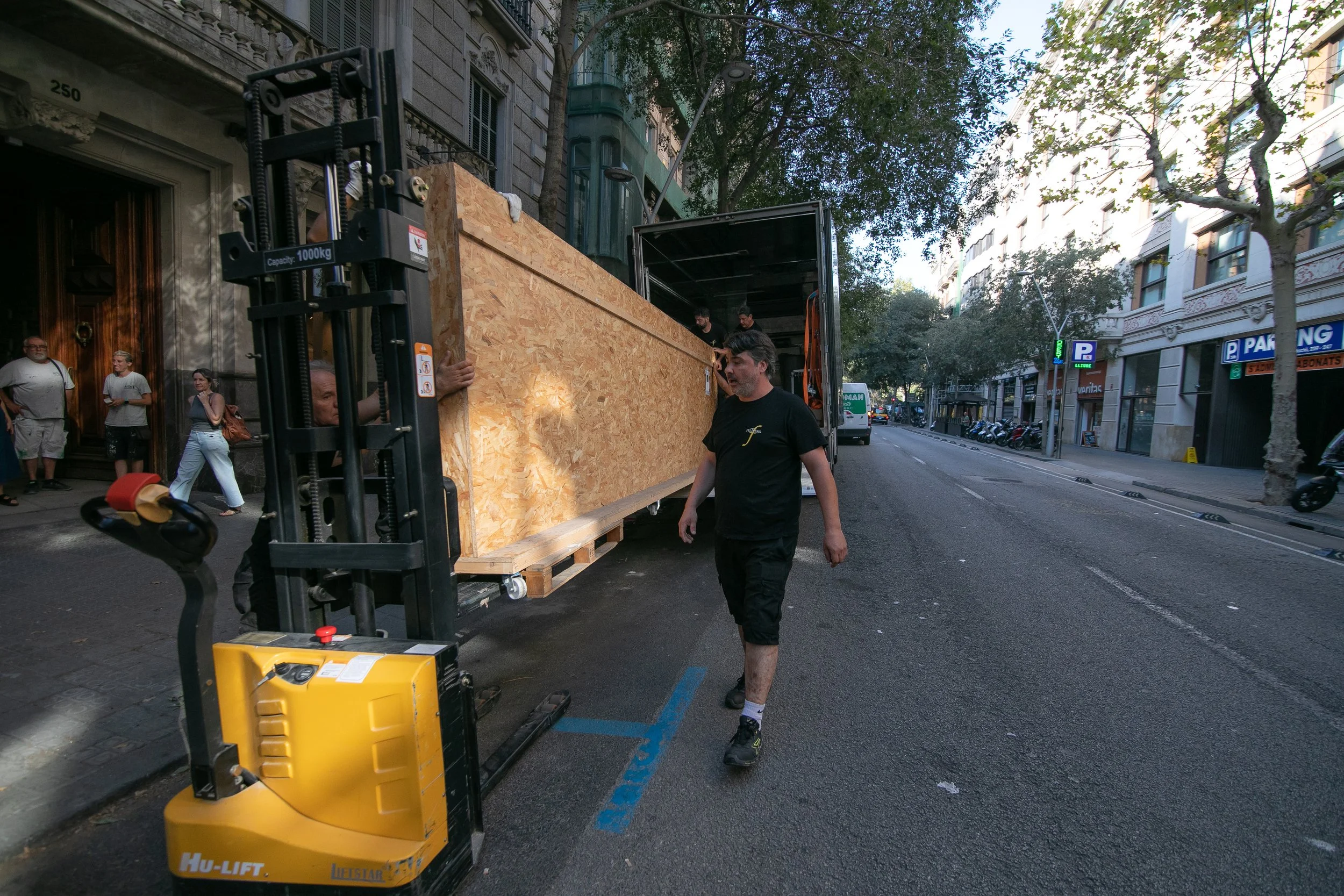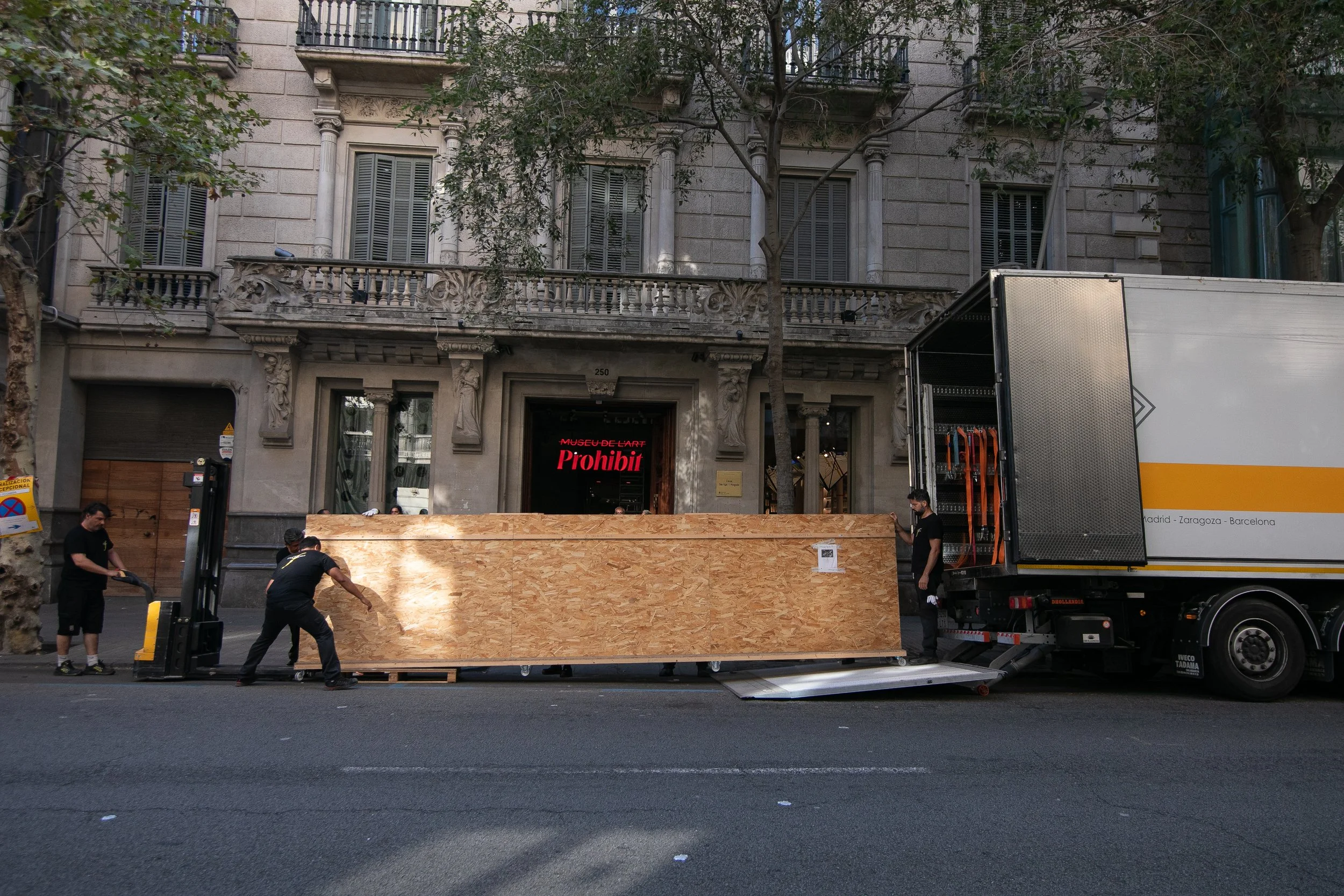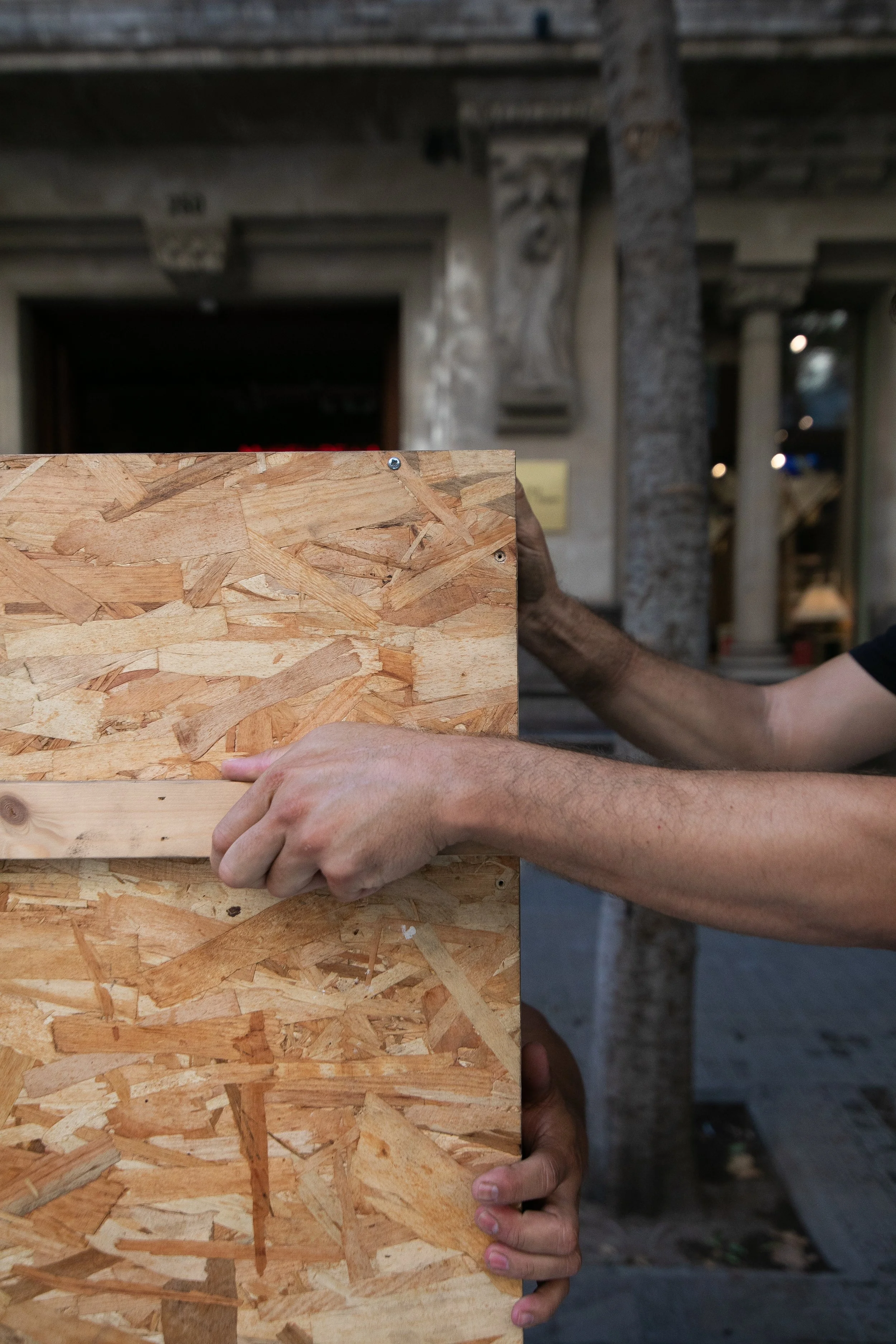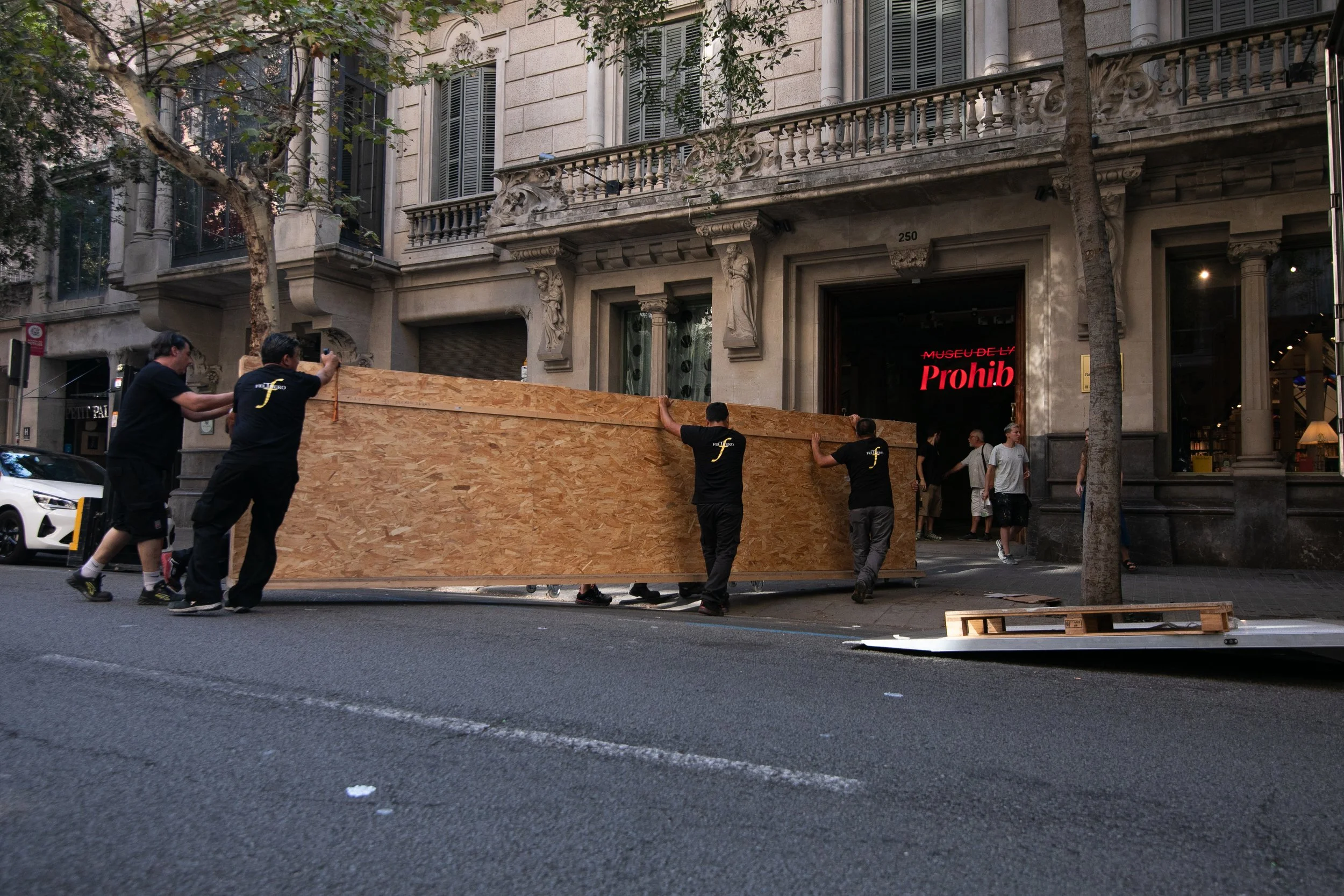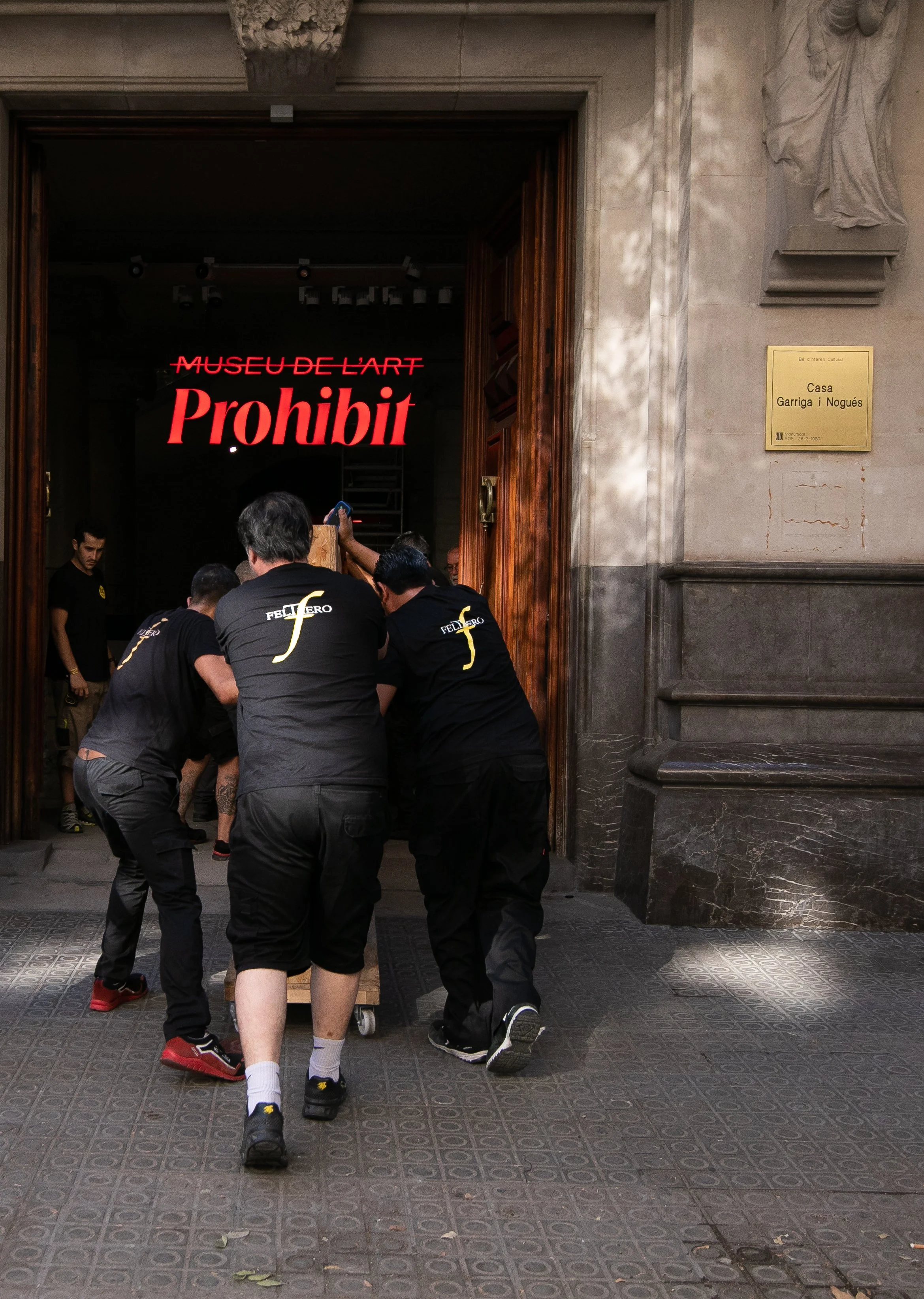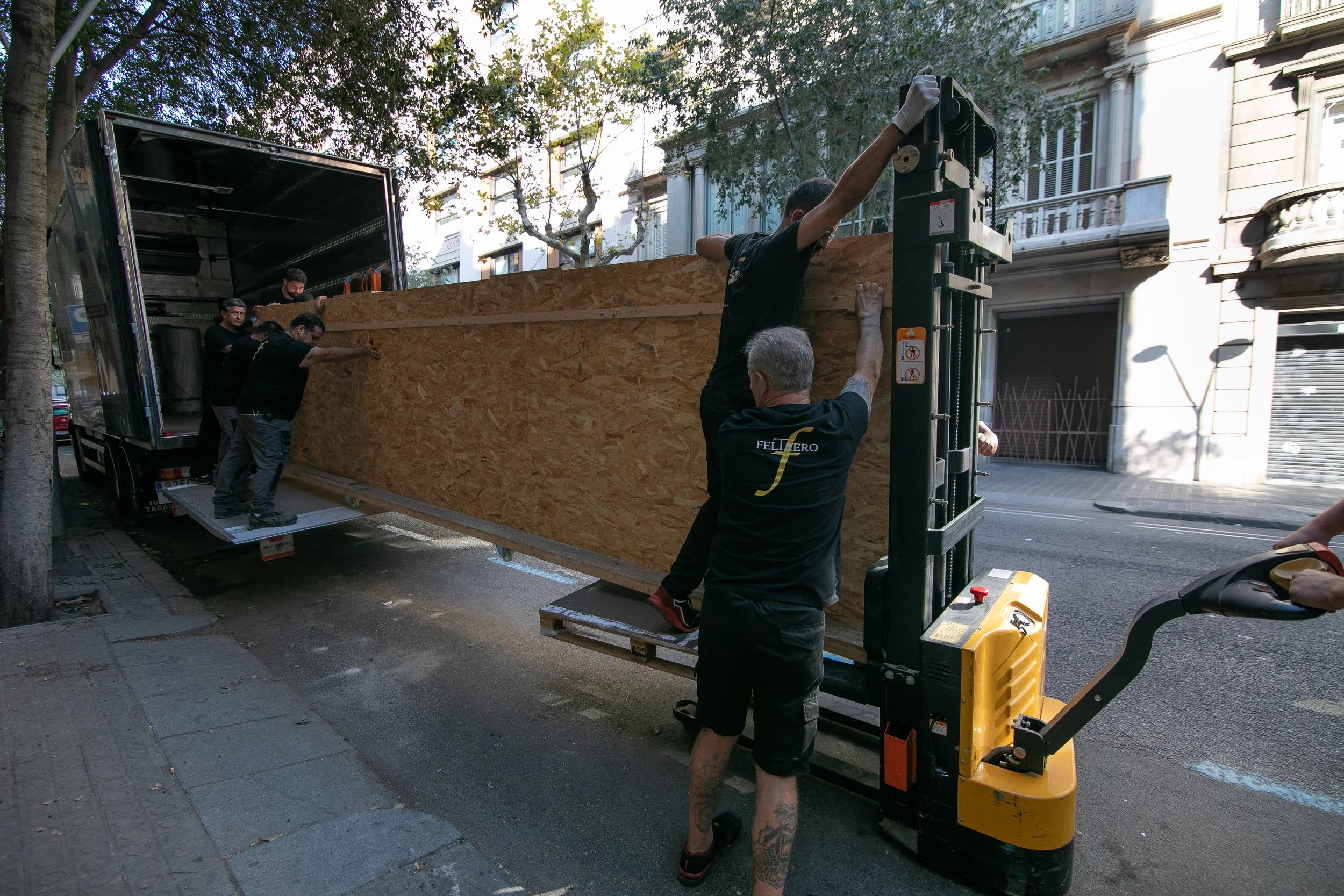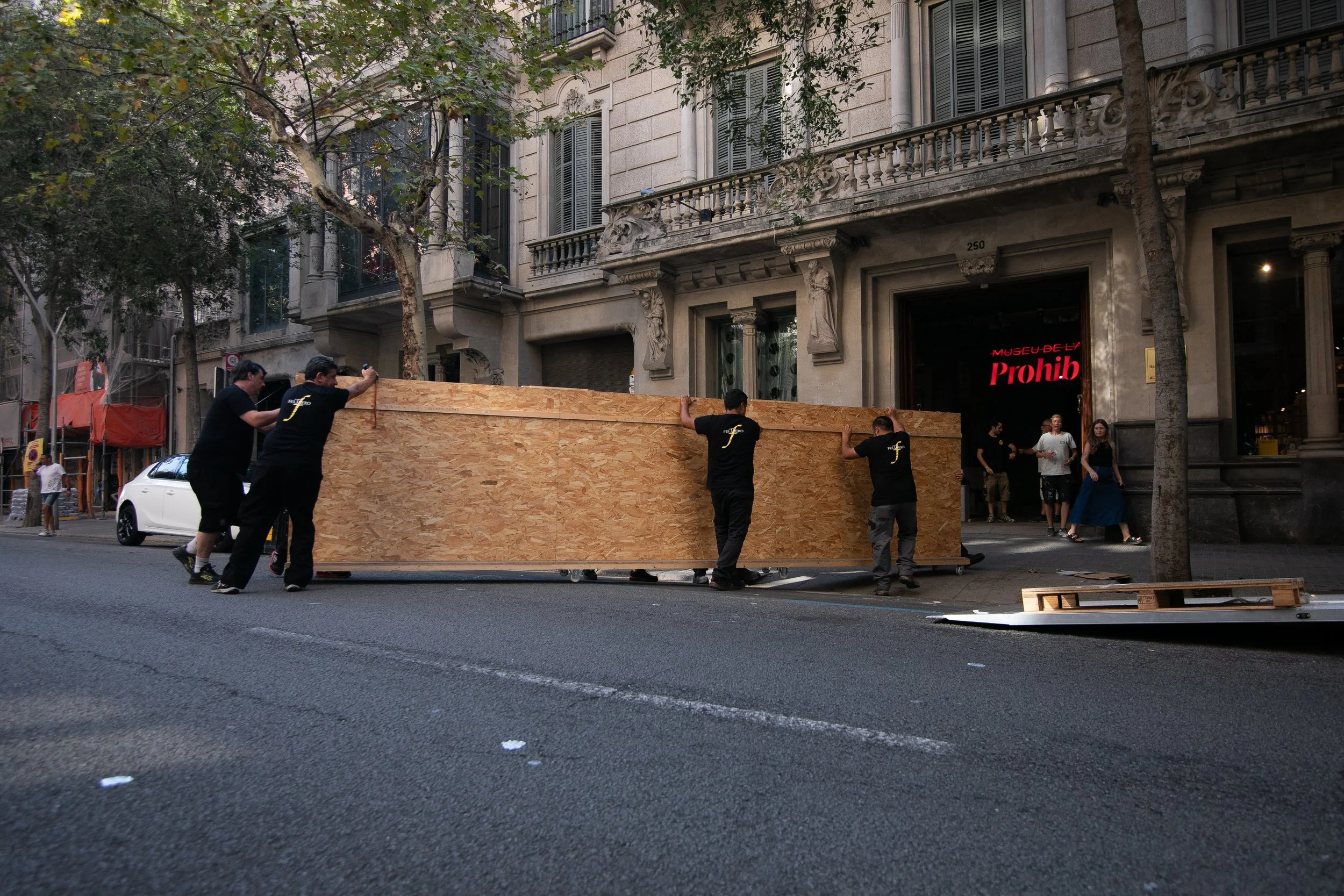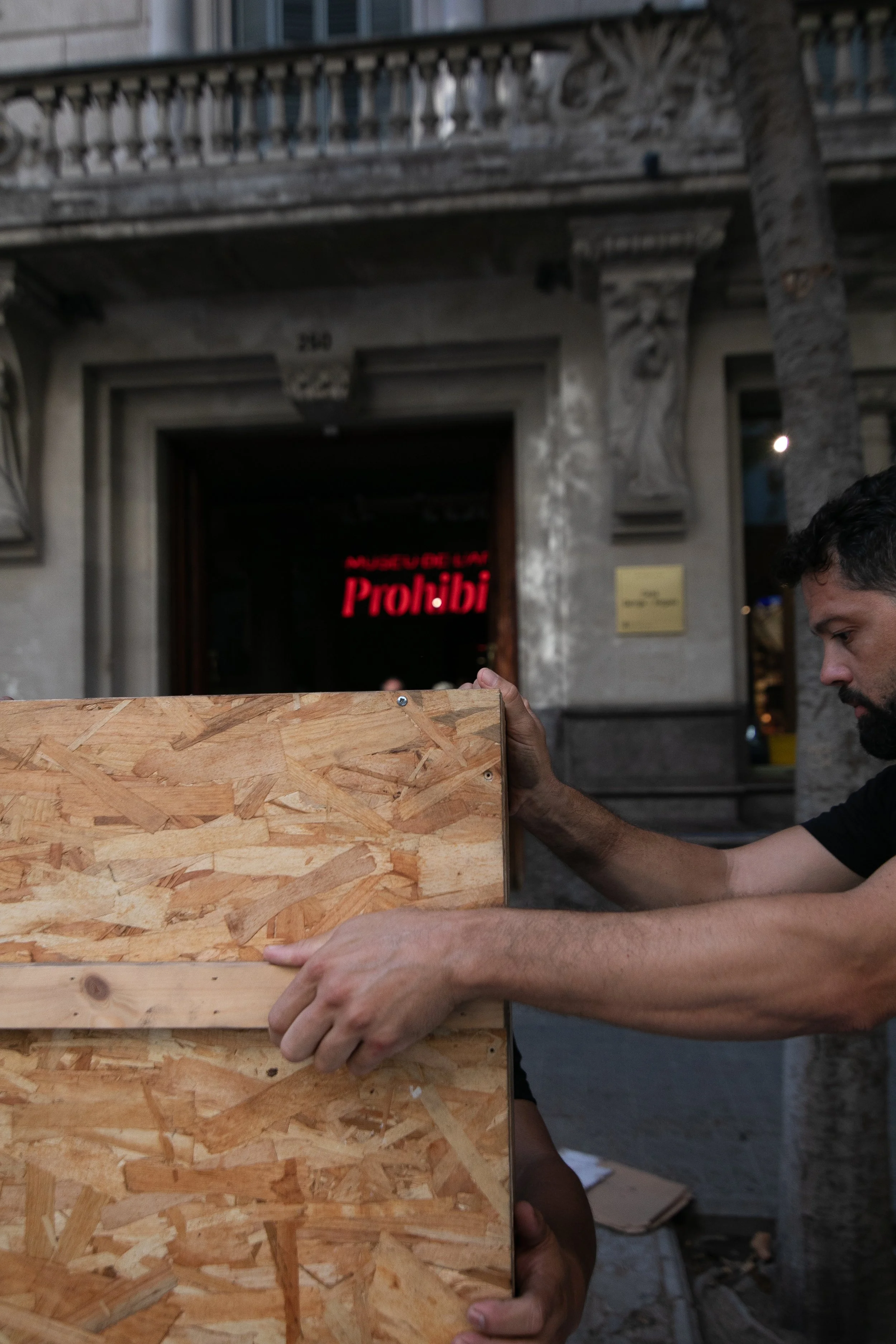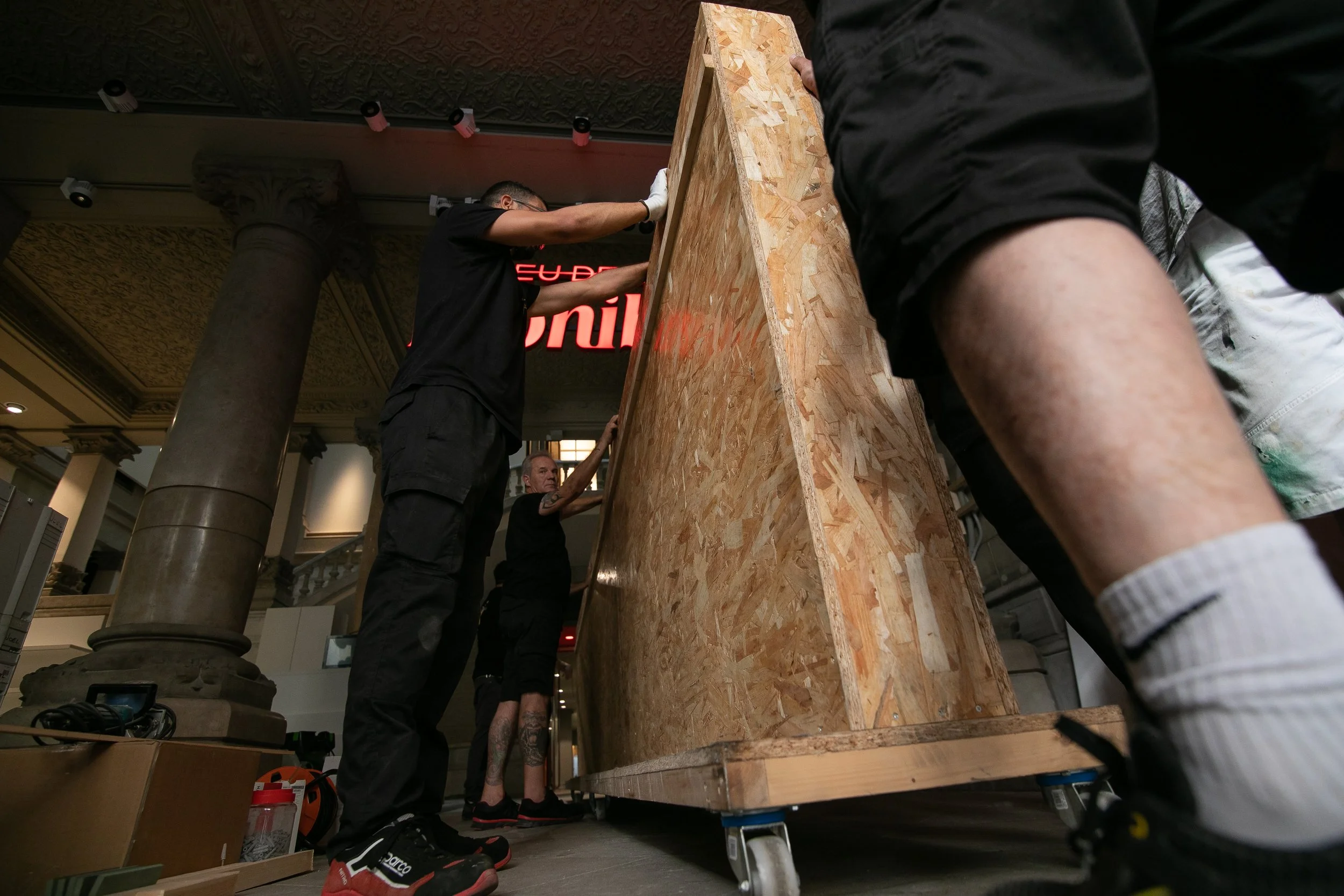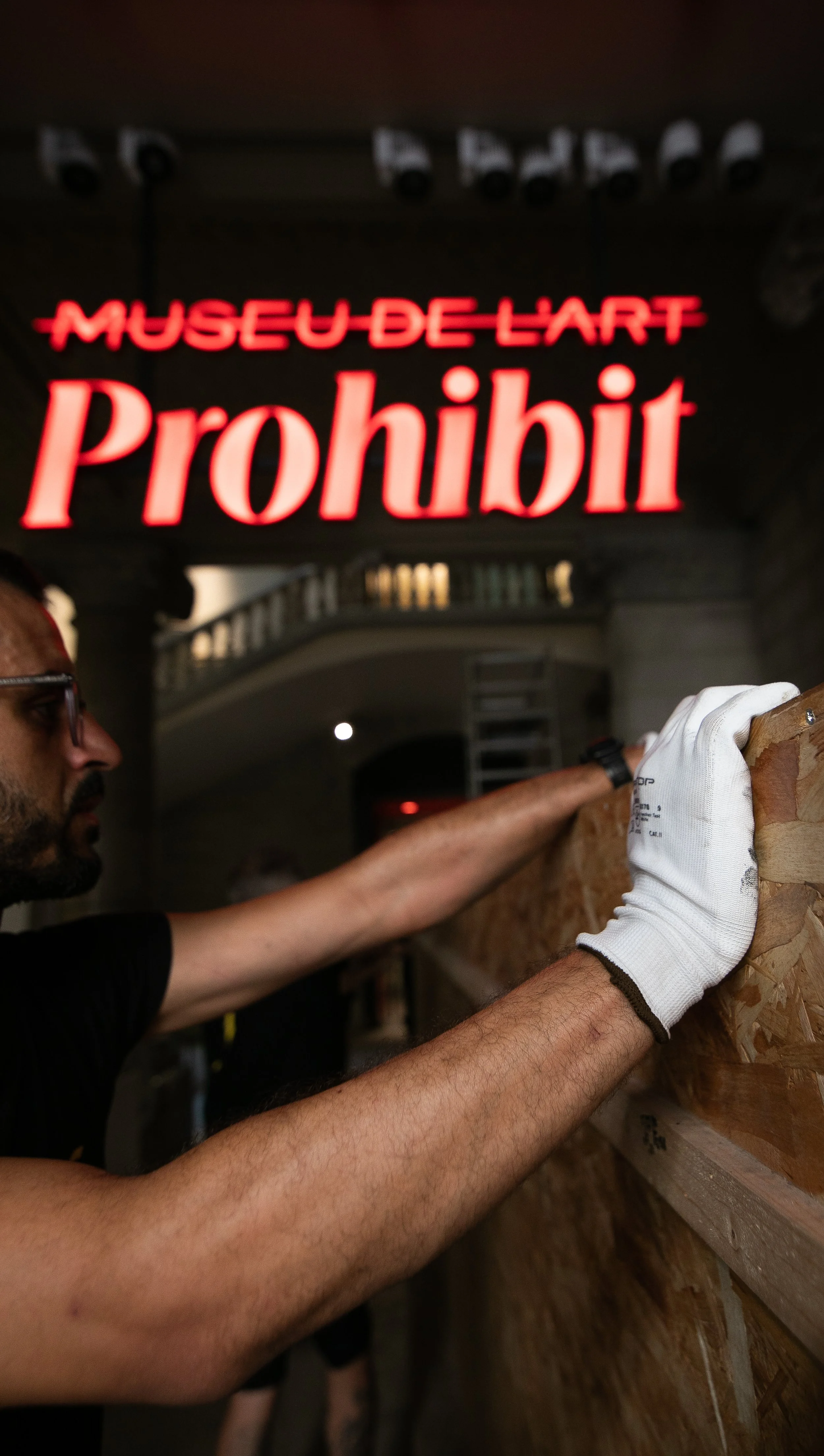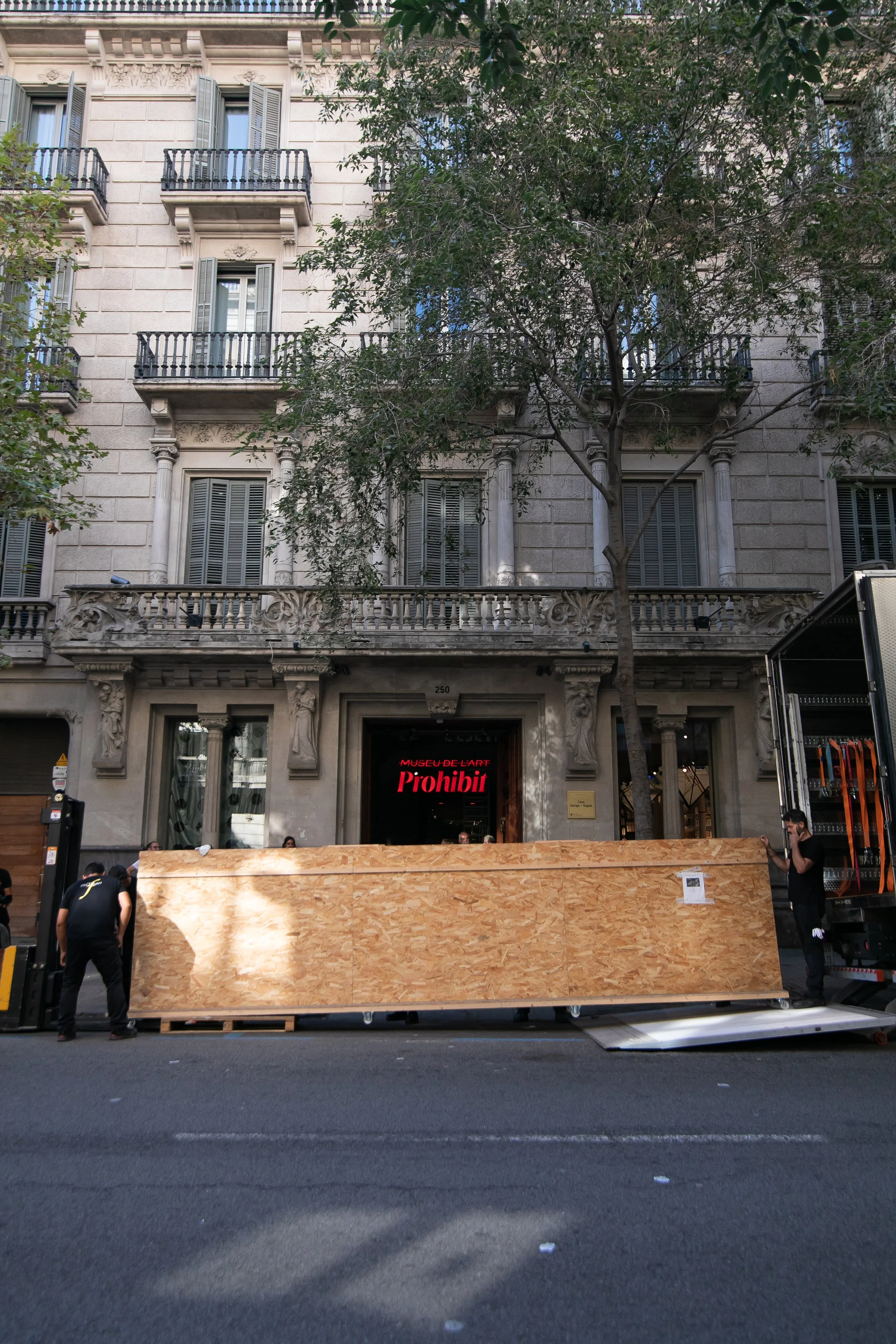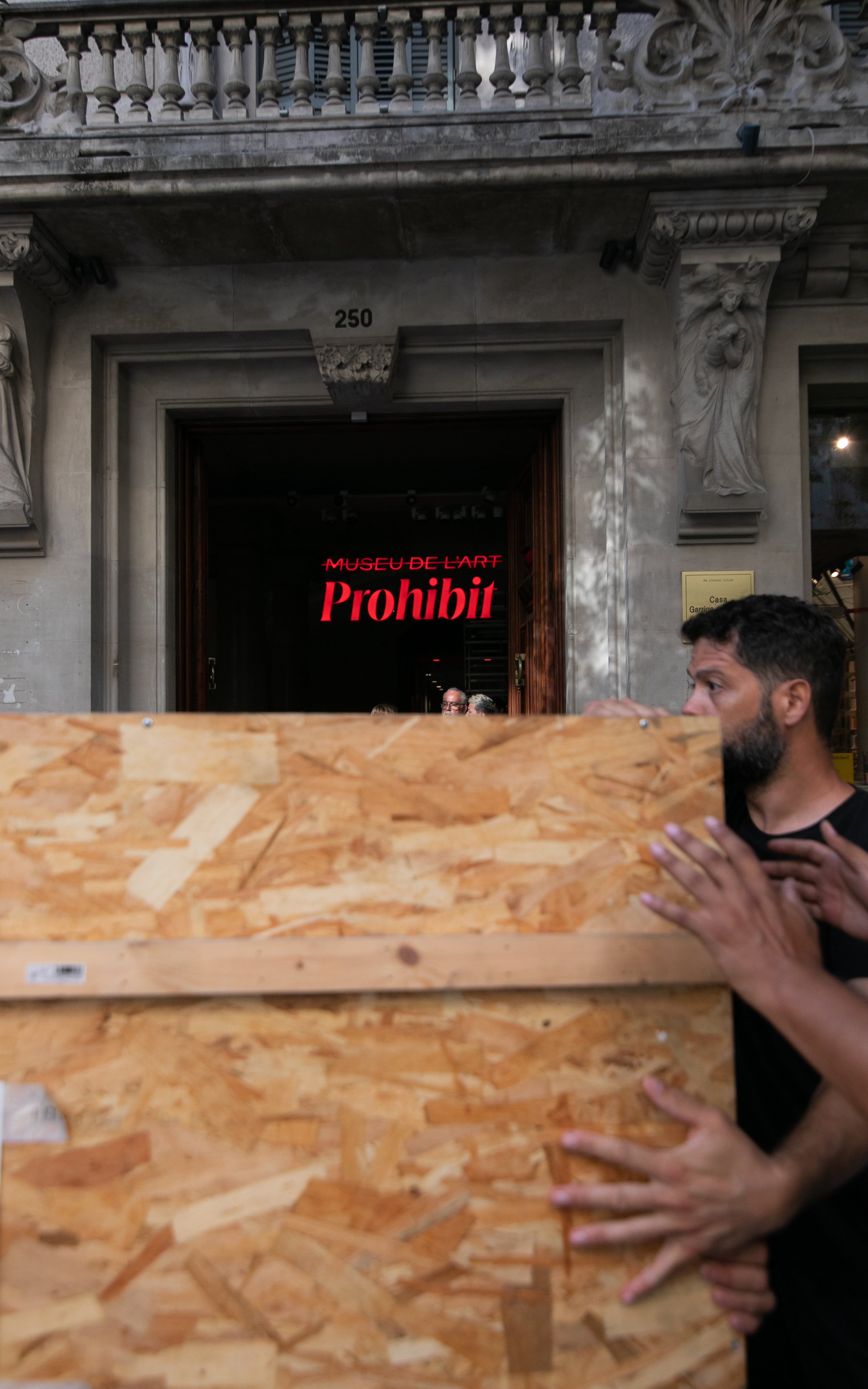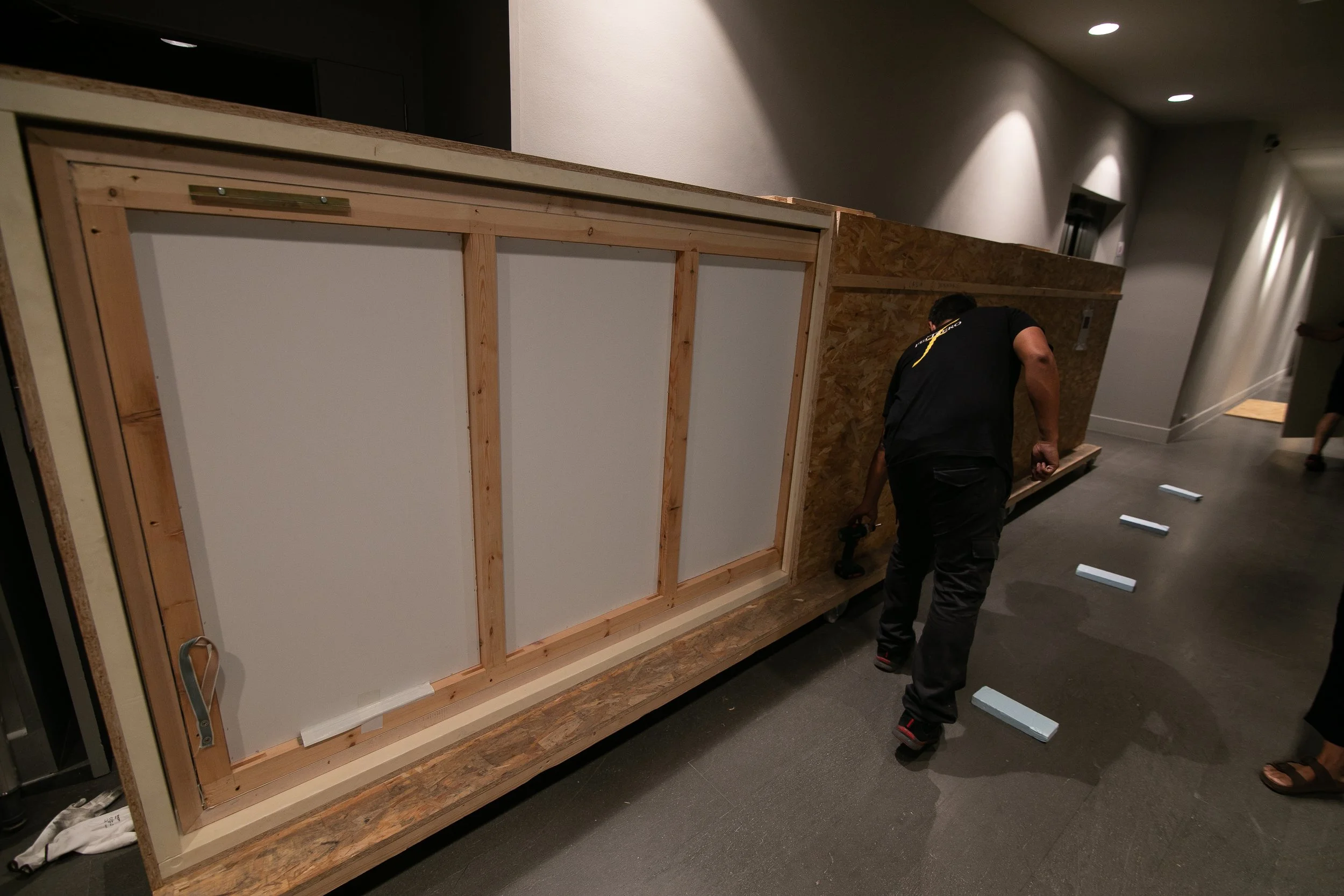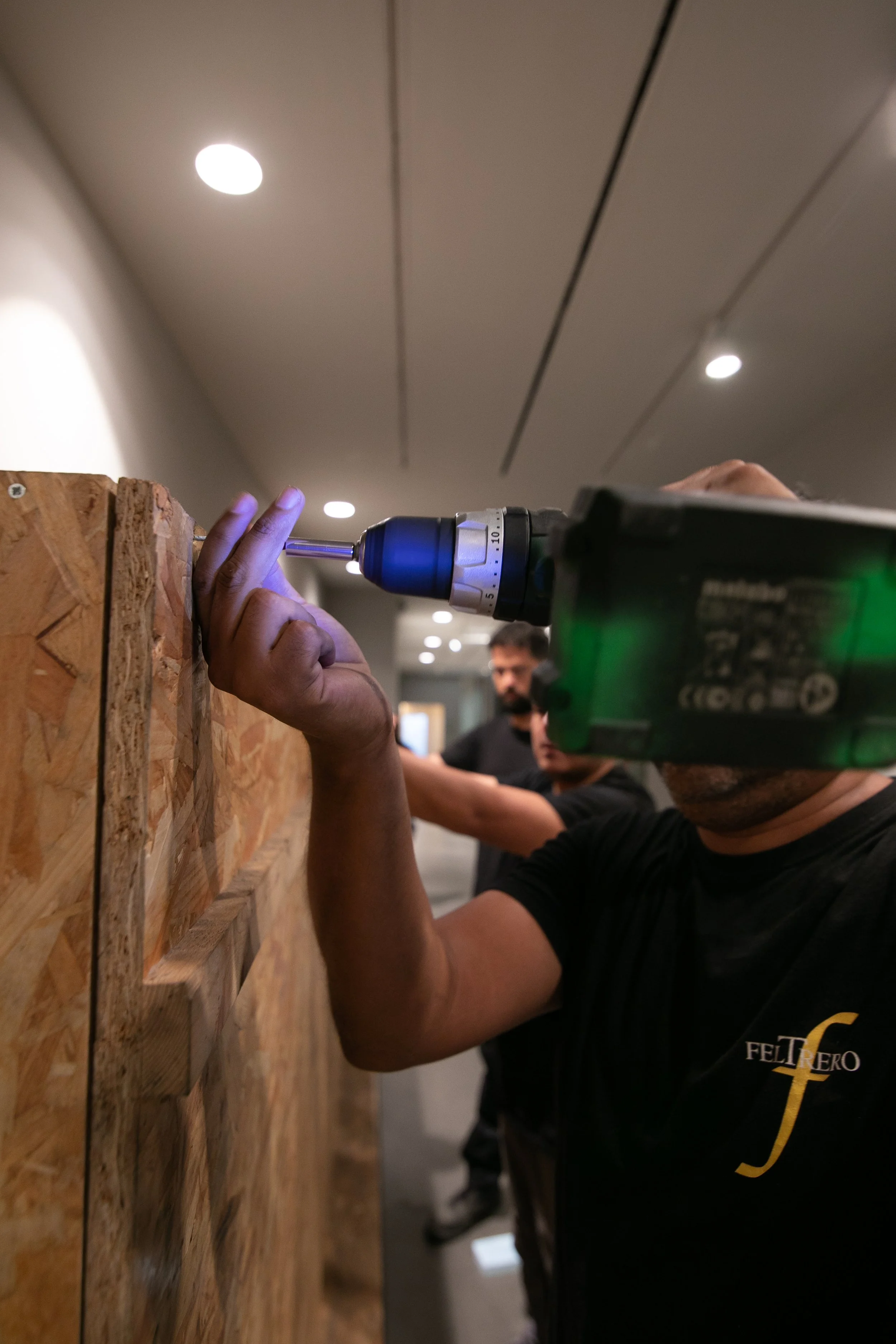“In November 2015, Abel Azcona’s existence became visible and became perpetual. He attended 242 Eucharistic celebrations and made the word “pedophilia” with the hosts. Part of Pamplona mobilized themselves against the artist for the exhibition of his action and the Spanish Association of Christian Lawyers filed a complaint against him for “profanation.” He is an artist without measure, nor half measures. He uses performance fused with installation, video art or sculpture to inquire in topics such as inequality, politics, terrorism, religion and has specialized in public stoning. He does not deny it, but includes it in his actions. Reaction is an essential part.”
Amen, popularly known as The Pederasty, is a procedural and long-durational work of art, framed in different clearly distinguishable periods. The multi-year contemporary piece was developed between the cities of Pamplona and Madrid. Both cities are linked to the childhood of the artist Abel Azcona. Like other previous pieces by the artist, the work Amen functions as a triggering work initiated by two performances and evolves as a piece of procedural base. The work was conceived in May 2015, with a duration of seven years until mid-2022, including in it all the processes triggered since the initial performance by Azcona, understanding the first action as the one where Azcona attends dozens of Eucharists in the cities of Pamplona and Madrid and the second action where Azcona activates the organic installation, through performance, in a central gallery in the city of Madrid as the trigger.
“En noviembre de 2015 la existencia de Abel Azcona se hizo visible y se tornó perpetua. Asistió a 242 eucaristías y con las hostias hizo la palabra “pederastia”. Una parte de Pamplona se movilizó contra el artista por la exposición de su acción y la Asociación Española de Abogados Cristianos presentó una querella contra él por “profanación”. Es un artista sin medida, ni medias tintas. Utiliza la performance fusionada con el videoarte, la instalación o la escultura para indagar en derechos humanos, injusticias sociales, abuso, maltrato, desigualdad, política, terrorismo, religión y se ha especializado en la lapidación pública. No reniega de ella, sino que la incluye en sus acciones. La reacción es parte esencial.”
Amén, conocida popularmente como La Pederastia, es una obra de arte procesual y duracional, enmarcada en distintos periodos claramente diferenciables. La pieza contemporánea de varios años de duración fue desarrollada entre las ciudades de Pamplona y Madrid. Ambas ciudades vinculadas a la infancia del artista Abel Azcona. Al igual que otras piezas previas del artista, la obra Amén funciona como una obra detonante iniciada mediante dos performances y evoluciona como una pieza de base procesual. La obra nace el mes de mayo de 2015, con una duración de siete años hasta mediados del año 2022, incluyendo en la misma todos los procesos detonados desde la performance inicial de Azcona, entendiendo como detonante la acción primera donde Azcona asiste a decenas de eucaristías en las ciudades de Pamplona y Madrid y la segunda acción donde Azcona activa la instalación orgánica, mediante performance en una galería céntrica de la ciudad de Madrid.
Initial performance where the artist carried out the installation in the Alicia Hevia Gallery in Madrid.
Performance inicial donde el artista Abel Azcona realiza la instalación en Galería Alicia Hevia de Madrid.
The more than two hundred venues chosen for the initial performance in Pamplona and Madrid were, among others, the San Saturnino church in Pamplona, the Asunción parish in Pamplona, the San Ignacio church in Pamplona, the de Nuestra Señora del Huerto parish in Pamplona, Corpus Christi parish in Pamplona, Cristo Rey parish in Pamplona, Santa Mónica parish in Madrid, Nuestra Señora Del Pilar parish in Madrid, San Jorge parish in Pamplona, Santa Vicenta María parish in Pamplona, San Francisco de Javier parish in Pamplona. (All included in the images above).
Las más de doscientas sedes elegidas para la performance inicial en Pamplona y Madrid fueron, entre otras, la iglesia San Saturnino de Pamplona, la parroquia de la Asunción, la iglesia de San Ignacio, Parroquia de Nuestra Señora del Huerto en Pamplona, Parroquia de Corpus Christi en Pamplona, Parroquia de Cristo Rey, Parroquia de Santa Mónica en Madrid, La Parroquia de Nuestra Señora Del Pilar en Madrid, Parroquia de San Jorge en Pamplona, Parroquia de Santa Vicenta María, Parroquia de San Francisco de Javier en Pamplona. (Todas incluidas en las imágenes anteriores).
Azcona documented with a hidden camera in parishes and churches such as the San Lorenzo church, Cristo Rey church and the San Nicolás church of Pamplona. / Azcona documentado con cámara oculta en parroquias e iglesias como la Iglesia San Lorenzo, Iglesia Cristo Rey e Iglesia de San Nicolás de Pamplona.
At the beginning of the piece, artist Abel Azcona, during the months of May, June, July and August 2015, carried out an individual performative project, solely as personal documentation, attending almost three hundred Eucharists in Pamplona and Madrid. The work began as a daily ritual in which Azcona attended the celebration of the Eucharist in churches and parishes linked to his childhood and life experience. The initial interest was closer to the active listening of the Eucharist and the transcriptions of some of the sermons. However, the piece resulted in the act of receiving communion where Azcona encounters a performative ritual act of repetition, which he begins to activate by inertia in each of the Eucharists he attends. By not communing with the Christian faith, despite having been educated in it in his adoptive family, he decides not to ingest the wafer in communion and return with it to his home, at that time in front of the Church of Cristo Rey in the city of Pamplona. All the wafers were accommodated in a wooden box that Azcona had bought in an antique dealer.
En los inicios de la pieza, el artista Abel Azcona, durante los meses de mayo, junio, julio y agosto de 2015, realiza un proyecto performativo individual, únicamente como documentación personal, asistiendo a casi trescientas eucaristías de Pamplona y Madrid. La obra comienza como un ritual diario en el que Azcona asiste a la celebración de la eucaristía en iglesias y parroquias vinculadas a su infancia y experiencia vital. El interés inicial se acercaba más a la escucha activa de las eucaristías y a la transcripciones de algunos de los sermones. Sin embargo, la pieza derivó en el acto de comulgar donde Azcona encuentra un acto ritual performativo de repetición, que comienza a activar por inercia en cada una de las eucaristías a las que asiste. Al no comulgar con la fe cristiana, a pesar de haber sido educado en la misma en su familia adoptiva, decide no ingerir la oblea en la comunión y retornar con ella su domicilio, por entonces frente a la Iglesia de Cristo Rey en la ciudad de Pamplona. Todas las obleas iban acomodándose en una caja de madera que Azcona había comprado en un anticuario.
The second week of September 2015, within the context of an exhibition with a wide selection of works and performances by the artist in a Madrid gallery, Azcona carried out a series of newly created performances and installations. Among them and open to the public, Azcona activated and intervened the more than 250 wafers collected during that same summer in churches and parishes in the cities of Pamplona and Madrid. In the exercise of performative improvisation, Azcona created an organic installation where the word "pederasty" could be read.
This installation remained for two days to be visited in the art gallery of the Barrio de las Letras in Madrid. Several visitors interacted with the piece and the work was valued by critics as necessary, resilient and coherent. The performance was documented by photography and video, with no idea of being reactivated.
In the video and photographic images, Azcona can be seen, for two hours, fully dressed in black, writing the word “pedophilia” (“pederastia” in spanish) with 242 wafers. Some of the wafers collected during the first action were not used, when Azcona decided, during the process and formation of the word, to use only 242 of them, a figure that refers to the exact number of complainants and survivors who were part of the work “The Shadow ”by Azcona, where dozens of survivors of child abuse narrated and made their story visible.
La segunda semana de septiembre de 2015, en el marco de una exposición con una amplia selección de obras y performance del artista en una galería madrileña, Azcona realiza una serie de performance e instalaciones de nueva creación. Entre ellas y con apertura al público, Azcona activa e interviene las más de 250 obleas recolectadas durante ese mismo verano en iglesias y parroquias de las ciudades de Pamplona y Madrid.
En el ejercicio de improvisación performativo, Azcona crea una instalación orgánica donde puede leerse la palabra “pederastia”. Dicha instalación permaneció durante dos días para poder ser visitada en la galería de arte del Barrio de las Letras madrileño. Varios visitantes interaccionaron con la pieza y la obra fue valorada por la crítica como necesaria, resiliente y coherente. La performance fue documentada mediante fotografía y vídeo, sin idea de ser reactivada.
En las imágenes de vídeo y fotografía puede verse a Azcona, durante dos horas, totalmente vestido de negro, escribiendo la palabra “pederastia” con 242 obleas. Algunas de las obleas recolectadas durante la primera acción no fueron utilizadas, al decidir Azcona, durante el proceso y formación de la palabra, emplear únicamente 242 de ellas, cifra que refiere al número exacto de denunciantes y supervivientes que formaron parte de la obra “La Sombra” de Azcona, donde decenas de supervivientes de abuso infantil narraron y visibilizaron su historia.
May, June, July and August 2015. Azcona attended more than two hundred churches and parishes in Madrid and Navarre and collected more than two hundred and fifty wafers during the sacrament of the Eucharist.
September 2015. Azcona inaugurated a series of performances and installations in an art gallery in the center of Madrid for two days, including the organic installation made up of the wafers collected during the intimate process that same summer. The installation was well received and got good reviews and no controversy.
October 2015. The Pamplona City Council invited Azcona to exhibit in a public building, and among the institution, Azcona himself and the curators selected the Monument to the Fallen located in the Plaza de la Libertad in Pamplona as an exhibition building.
November 2015. The work “Buried” (“Enterrados”) by Azcona was chosen as the main piece in the exhibition “Unearthed (“Desenterrados”): A retrospective vision on the artist's political and subversive work.” The term “Des-” (“Un-”) was included in the title due to the concept of waste from other performances. Among the forty-two selected works, four photographs and a recipient with the wafers of the work "Amen or the Pederasty" were installed.
November 20, 2015. Inauguration of the exhibition Unearthed: A retrospective vision on the political and subversive work by artist Abel Azcona with a large influx of public and good critics.
November 21, 2015. Different Catholic and conservative media described the exhibition and specifically the work “Amen or the Pederasty” as “controversial work”.
November 22, 2015. Respect for Navarra, the Carlist Traditionalist Union, Hazte Oír and Más Libres called the first concentration against the exhibition and against Azcona in the Town Hall Square of Pamplona. About nine hundred people shouted "Azcona, God forgives you" or "We are going to close that exhibition."
November 23, 2015. First attacks on the exhibition, part of the piece is stolen, works are broken, posters and canvases are torn off the entrance. The stolen work was a recipient with some of the consecrated wafers that a man introduced inside his jacket and violently left the building.
November 24, 2015. The Archbishop of Pamplona and Tudela announced that he had the stolen wafers that a brave Christian soldier had recued and that he would perform a private ceremony to repair the damage. At the end of the ceremony the Archbishop himself ingested all the wafers consecutively so that they would return to their sacred origin. He warned that the great sin could be reversed, but that they were only a few wafers of the total and that they had to be rescued in their entirety by all Christ soldiers.
November 24, 2015. The exhibition was closed due to the danger the work and the artist himself were in.
November 25, 2015. The exhibition reopened with hundreds of people at the entrance praying rosaries through a loudspeaker and dozens of them entered the interior of the exhibition hall and occupied the space on their knees shouting "Viva Cristo Rey". Since then, every opening day they occuped the room on their knees in the exhibition hall and in front of the work, praying the rosary or with ultra-catholic proclamations.
November 26, 2015. New concentration against the exhibition and against Azcona Town Hall Square of Pamplona.
November 27, 2015. The exhibition was attacked, several works were destroyed, along with the canvas at the entrance and the occupation of the building by ultra-Catholic movements.
November 28, 2015. Azcona had to leave the exhibition building and was advised not to approach without escort because a man showed up with a firearm, shouting proclamations and threatening the artist with death.
December 2, 2015. Demonstration of hundreds of people for freedom of speech in support of artist Abel Azcona from the Pamplona Bus Station to the Town Hall Square of Pamplona.
December 2015. The work was divided into an installation part, a photographic part and a documentary part. The photographic part was bought by a private collector in Lyon, France.
November 2018. The work's three parts - installation, photographic and documentary - were once again unified to be sold in its entirety to Tatxo Benet's Censored Art Collection together with censored and persecuted historical works by Ai Weiwei, Francisco De Goya, Santiago Sierra , Robert Mapplethorpe or Andres Serrano. The organic installation measures 7.50m x 1.20 m and the six documentary frames 1.50m x 1.00m.
October 9, 2019. The Strasbourg Court admited the claim against artist Abel Azcona. The Spanish Association of Christian Lawyers denounced Spain for the work 'Amen' by artist Abel Azcona, that they consider "the greatest desecration in history."
September 26, 2020. The work was fully inaugurated at the La Panera Center for Contemporary Art in Lleida along with other censored historical works such as Piss Christ by Andrés Serrano, X Portfolio by Robert Mapplethorpe, various pieces by Ai Weiwei and The Western and Christian Civilization by Leo Ferrari, all of them part of Tatxo Benet's Censored Contemporary Art Collection.
Mayo, junio, julio y agosto de 2015. Azcona asiste a más doscientas iglesias y parroquias madrileñas y navarras y recopila más de doscientas cincuenta obleas durante el sacramento de la eucaristía.
Septiembre de 2015. Azcona inaugura una serie de performances e instalaciones en una galería de arte del centro de Madrid, entre ellas durante dos días puede visitarse la instalación orgánica compuesta por las obleas recogidas durante el proceso intimista ese mismo verano. La instalación es bien recibida y obtiene buenas críticas y ninguna situación polémica.
Octubre de 2015. El Ayuntamiento de Pamplona invita a Azcona a exponer e un edificio público, y entre la institución, el propio Azcona y curaduría seleccionan el Monumento a los Caídos situado en la Plaza de la Libertad de Pamplona como edificio expositivo.
Noviembre de 2015. La obra Enterrados de Azcona es elegida como la pieza principal de la muestra Desenterrados: Una visión retrospectiva en torno a la obra política y subversiva del artista. Y se incluye el término “Des” al título por el concepto de desechos de otras performances. Entre las cuarenta y dos obras seleccionadas, se instalaron cuatro fotografías y un recipiente con las obleas de la obra “Amén o La Pederastia”.
20 de noviembre de 2015. Inauguración de la exposición Desenterrados: Una visión retrospectiva en torno a la obra política y subversiva del artista Abel Azcona con gran afluencia de público y buenas críticas.
21 de noviembre de 2015. Diferentes medios católicos y conservadores describen la exposición y en concreto la obra Amén o La Pederastia como “obra polémica”.
22 de noviembre de 2015. Respeto por Navarra, Unión Tradicionalista Carlista, Hazte Oír y Más Libres convocan la primera concentración contra la muestra y contra Azcona en la Plaza del Ayuntamiento de Pamplona. Unas novecientas personas gritan “Azcona, Dios te perdona” o “Vamos a cerrar esa exposición”.
23 de noviembre de 2015. Primeros ataques a la muestra, parte de la pieza es sustraída, obras rotas, ruptura de carteles y lonas de la entrada. La obra sustraída es un recipiente con algunas de las obleas consagradas, un hombre se las introduce en el interior de la chaqueta y abandona el edificio con violencia.
24 de noviembre de 2015. El Arzobispo de Pamplona y Tudela anuncia que está en posesión de las obleas sustraídas, que un valiente soldado cristiano ha rescatado y que realizará una ceremonia privada para reparar el daño. Al finalizar la ceremonia el propio Arzobispo ingiere todas las obleas de forma consecutiva para que vuelvan a su origen sagrado. Advierte que el gran pecado puede ser revertido, pero que únicamente son unas pocas obleas del total y deben ser buscadas y rescatadas en su totalidad por todos los soldados Cristo.
24 de noviembre de 2015. Se plantea el cierre de la muestra por peligrosidad de la obra y del propio artista.
25 de noviembre de 2015. La muestra vuelve a reabrirse con cientos de personas en la entrada rezando rosarios con megafonía y decenas de ellos entran en el interior de la sala de exposiciones y ocupan el espacio de rodillas al grito de “Viva Cristo Rey”. Desde entonces, todos los días de apertura ocupan la sala de rodillas en la sala de exposiciones y frente a la obra, rezando el rosario o con proclamas ultracatólicas.
26 de noviembre de 2015. Nueva concentración contra la exposición y contra Azcona en la Plaza del Ayuntamiento de Pamplona.
27 de noviembre de 2015. La exposición es atacada, varias obras son destrozadas, junto a la lona de la entrada y la ocupación del edificio por movimientos ultracatólicos.
28 de noviembre de 2015. Azcona debe abandonar el edificio expositivo y se le recomienda no acercarse sin escolta por un hombre con un arma de fuego gritando proclamas y amenazando de muerte al artista.
2 de diciembre de 2015. Manifestación de cientos de personas por la libertad de expresión en apoyo del artista Abel Azcona desde la Estación de Autobuses de Pamplona a la Plaza del Ayuntamiento de Pamplona.
Diciembre de 2015. La obra es dividida en parte instalativa, parte fotográfica y parte documental. La parte fotográfica es comprada por un coleccionista privado en Lyon, Francia.
Noviembre de 2018. La obra vuelve a ser unificada con sus tres partes, instalativa, fotográfica y documental para ser vendida completa a la Colección de Arte Censored de Tatxo Benet junto a obras censuradas y perseguidas históricas de Ai Weiwei, Francisco De Goya, Santiago Sierra, Robert Mapplethorpe o Andres Serrano. La instalación orgánica mide 7,50 m x 1,20 m y los seis cuadros documentales 1,50m x 1,00m.
9 de octubre de 2019. El Tribunal de Estrasburgo admite la demanda contra el artista Abel Azcona. La Asociación Española de Abogados Cristianos denunció a España por la obra 'Amén' del artista Abel Azcona, que considera "la mayor profanación de la historia".
26 de septiembre de 2020. La obra es inaugurada de forma completa en el Centro de Arte Contemporáneo La Panera de Lleida junto a otras obras históricas censuradas como Piss Christ de Andrés Serrano, X Portfolio de Robert Mapplethorpe, varias piezas de Ai Weiwei y La civilización occidental y cristiana de Leo Ferrari, todas ellas parte de la Colección de Arte Contemporáneo Censored de Tatxo Benet.
13 de abril de 2021. Archivo total de la causa, búsqueda y captura y denuncia de obstrucción a la justicia.
In November 2015, the work is curatorially included in the retrospective exhibition dedicated to Abel Azcona in his adoptive city of Pamplona. From November 2015 to January 2016, the Pamplona City Council organized an exhibition with more than two hundred works by Azcona created between 2005 and 2015. Despite having been exhibited in Madrid in an installation-based manner without controversy, the work transcended and gained great relevance by be exhibited in the exhibition dedicated to the artist inside the Monument to the Fallen in Pamplona.
En noviembre de 2015 la obra es curatorialmente incluida en la muestra retrospectiva dedicada a Abel Azcona en su ciudad adoptiva Pamplona. El Ayuntamiento de Pamplona organizó de noviembre de 2015 a enero de 2016 una exposición con más de doscientas obras de Azcona creadas entre los años 2005 y 2015. La obra pese haber sido expuesta en Madrid de manera instalativa sin polémica, transcendió y obtuvo gran relevancia al ser expuesta en la muestra dedicada al artista en el interior del Monumento a los Caídos de Pamplona.
Diario de Navarra, 21 de Noviembre de 2017. Fragmento noticia en papel. PDF Completo. Noticia digital.
Diario de Navarra, 21 de Noviembre de 2017. Fragmento noticia en papel. PDF Completo. Noticia digital.
Diario de Noticias, 21 de Noviembre de 2017. Fragmento noticia en papel. PDF Completo. Noticia Digital.
Diario de Noticias, 21 de Noviembre de 2017. Fragmento noticia en papel. PDF Completo. Noticia Digital.
Diario de Navarra, 21 de Noviembre de 2017. Fragmento noticia en papel. PDF Completo. Noticia digital.
Primera concentración contra la muestra de Abel Azcona. Cedida al proyecto Amén por Diario de Noticias de Navarra © Iban Aguinaga.
Izda 24 de noviembre Diario de Navarra. Arriba 27 de noviembre Diario de Noticias.
Primera concentración contra la muestra del artista Abel Azcona en el Ayuntamiento de Pamplona. Diario de Navarra © Javier Sesma.
Primera concentración contra la exposición el segundo día de apertura de la muestra en Pamplona. / Ignacio Arsuaga, Presidente de Hazte Oir. Diario de Noticias de Navarra © Mikel Saiz
Martes, 24 de Noviembre de 2017. Diario de Navarra.
Martes, 24 de Noviembre de 2016. Diario de Noticias de Navarra.
Martes, 24 de Noviembre de 2017. Diario de Navarra.
Uno de los manifestantes contra la exposición del artista Abel Azcona formando parte de Amén. © Javier Bergasa
Fotografía cedida al proyecto Amén por Diario de Noticias de Navarra. © Javier Bergasa
Video de reapertura después del fin de semana de la polémica y difusión del proyecto Amén en la exposición Desenterrados.
Miércoles, 25 de Noviembre de 2017. Diario de Navarra.
Uno de los manifestantes contra la exposición del artista Abel Azcona formando parte de Amén. © Javier Bergasa
Fotografía cedida al proyecto Amén por Diario de Noticias de Navarra. © Javier Bergasa
Cientos de personas en la entrada de la exposición de Abel Azcona. Diario de Noticias de Navarra © Javier Bergasa
Manifestantes en el interior de la exposición del artista Abel Azcona formando parte de Amén. © Javier Bergasa
Miércoles, 25 de Noviembre de 2015. Diario de Noticias de Guipúzcoa.
Manifestantes en contra la exposición del artista Abel Azcona formando parte de Amén. © Javier Bergasa
Fotografía cedida al proyecto Amén por Diario de Noticias de Navarra. © Javier Bergasa
Primeras hojas de la denuncia del Arzobispado de Pamplona y Tudela contra el artista Abel Azcona. Denuncia presentada por el Arzobispado de Pamplona y Tudela, en representación De la Iglesia Navarra, en representación De la Iglesia Católica, ambas instituciones firmantes de la denuncia contra el artista Abel Azcona.
Primeras hojas de la querella criminal de Abogados Cristianos contra el artista Abel Azcona. Querella presentada por la Asociación de Abogados Cristianos contra Azcona y contra la obra Amén o La Pederastia.
La denuncia fue interpuesta en el Juzgado de Guardia de Pamplona el 23 de Noviembre de 2017. Tres días después de la inauguración de la exposición retrospectiva dedicada al artista en Pamplona. PDF de la denuncia completa.
La querella fue interpuesta en el Juzgado de Guardia de Pamplona el 23 de Noviembre de 2017. Tres días después de la inauguración de la exposición retrospectiva dedicada al artista en Pamplona. PDF de la denuncia completa.
Jueves, 26 de Noviembre de 2015. Diario de Noticias de Navarra.
Jueves, 26 de Noviembre de 2015. Diario de Navarra.
Jueves, 26 de Noviembre de 2015. Diario de Navarra.
Homily of the Archbishop of Pamplona and Tudela, Bishop Francisco Pérez González, at the Holy Mass of reparation for the desecration, which took place in the Cathedral of Pamplona on November 25, 2015.
Dear brothers:
1. The human being is a being in need of many things, but what distinguishes him from other living beings, the deepest genetic difference within him, is that he is in need of love: to love and to be loved. What unites us is to pray and repair, before the Lord, what hurts us the most: to be offended. He teaches us to look with his own eyes at Truth, Justice, Love and Mercy.
I deeply appreciate the testimony you are giving here and in so many places in Navarra and I also thank the almost one hundred thousand testimonies from all five continents who adhere to this celebration and pray that what is most sacred to Christian-Catholics be respected. which is the Eucharist.
Saint John Paul II expresses it very well when he says: «Men cannot live without love. He cannot understand himself, his life is meaningless if love is not revealed to him, if he does not encounter love, if he does not experience it and make it his own, if he does not participate in it vividly».
So much so that being loved, feeling loved, is what gives meaning to your existence, what makes you live the experience of feeling redeemed, of feeling saved.
As Archbishop of the episcopal headquarters of Pamplona, as successor of the Apostles in this Diocese, gathering the sentiment of the Christian people not only from here but from all over the world, I am obliged to say that true freedom of expression does not include a supposed right to offense or a contempt for the most sacred. Love not only redeems the person, but remakes social life. Discovering himself loved by God, the human being understands his own transcendent dignity, he learns to go out to meet the other, creating a fraternal and solidary network of human relationships.
That love that redeems the person and society has its maximum expression in the Eucharist, the great sacrament of love. As Benedict XVI says in the Apostolic Exhortation 'Sacramentum caritatis': "Each Eucharistic celebration sacramentally updates the gift of life that Jesus has voluntarily given on the Cross, for us and for the whole world."
As Archbishop of the episcopal headquarters of Pamplona, as successor of the Apostles in this Diocese, gathering the sentiment of the Christian people not only from here but from all over the world, I am obliged to say that true freedom of expression does not include a supposed right to offense or contempt for the most sacred. Culture is beauty and harmony. It is a heritage of faith and life that our land in Navarra has enjoyed for centuries. The Eucharist is the sacramental sign of the highest beauty that exists in all of human history.
2.- The Eucharist is the sacrament of self-giving, the most sublime gesture of love that Jesus left us on earth. It is a transforming encounter with the Lord in his word and in his sacrifice of love, which leads us to offer hope, forgiveness, healing and love to everyone who needs it, particularly the poor, the disinherited and oppressed, sharing their lives and longings and walking with them in search of an authentic human life in Christ Jesus.
As Pope Francis reminds us: “Today there is a great lack of hope in the world, that is why humanity needs to hear the message of our hope in Jesus Christ. The Church carries this message to all and, especially, to those who, even though they have been baptized, have distanced themselves from the Church and live without reference to the Christian life.” In reality, those who celebrate the Eucharist do not do so because they consider themselves or want to appear better than others, but precisely because they recognize that they are always in need of being welcomed and regenerated by the mercy of God.
The Eucharist is the most tangible sign of God's love for men, since it permanently renews his sacrifice for love; it is the mystery of our deep union with Christ. Through ir, Christ wants to enter our existence and permeate it with his grace. Love to give and to donate! And in the Eucharist, God gives himself and donates himself completely to us. Nurturing ourselves with the "Bread of Life" means entering into harmony with the heart of Christ, it means entering into a dynamism of love and becoming people of peace, people of forgiveness, of reconciliation, of sharing in solidarity.
The Eucharist constitutes the pinnacle of God's saving action: the Lord Jesus, making himself bread for us, pours all his mercy and love on us, in such a way that he renews our hearts, our existence and our way to relate to Him and to the brothers. I appeal to the human and Christian conscience of all to be sensitive to the problems that are present in our society.
Please defend the right to life, to marriage and to the family, the education of children and young people, service to the common good, the weakest and neediest, the true culture of work, peace among nations ... The Church He wants to be a messenger for the civilization of truth and justice, peace and love, that civilization that only God can offer us.
Today Jesus also gives himself to us in the Eucharist, he shares our same path, he becomes food, the true food that sustains our life, even in the difficult moments that we have to live. Every time we celebrate the Eucharist, we defeat the great sin of individualism, of rancor and the best of ourselves becomes an offering to the Father. Our dark areas are illuminated. The Eucharist returns to us every day the joy of belonging to "those who seek the Lord with a sincere heart", makes us a parable of the world that God wants, showing that, in the midst of our weaknesses, it is possible to live as brothers and love each other as Christ loves us.
But the sacrament of the Eucharist cannot be separated from the sacrament of charity. You cannot receive the body of Christ and feel away from those who are hungry and thirsty, from the sick, from those who suffer the drama of unemployment, from those who are excluded from the table of well-being, from those who live an empty life meaningless ... Jesus instituted the Eucharist during the Last Supper. Then he gave us the Commandment of Love: "Love one another as I have loved you." Therein lies the close relationship between the Eucharist and the commitment of charity. The Eucharist must be a source of charity towards our brothers, and it is for us the great sacrament of God's love, the great sacrament of Charity and the source of that love of God that we want to incarnate and signify in favor of the poor and excluded.
The meaning of the Eucharist is the understanding of love. This is how Blessed Mother Teresa explained it when she said that “Christ understood that we had an immense hunger for God. He understood that we had been created to be loved, and thus He became the Bread of Life. He also wants to give us the opportunity to transform our love for Him into living action.
He becomes hungry, not only for bread but for love. He becomes naked, not only because of a cloak that protects him, but because of that love, because of that human dignity. He becomes the homeless person, not only because of that place in a small room, but because of that sincere and deep love for one's neighbor, which is the Eucharist. This is Jesus, the Living Bread. The one who has come to share his divinity with us ”.
3.- When you contemplate the crucifix, you understand how much Jesus loved us. When you contemplate the Holy Eucharist, you understand how much Jesus loves us now. Let us pray that participation in the Eucharist commits us to following the Lord every day, to be instruments of communion, to share with Him and with our neighbor what we are. Then our existence will be truly productive.
This afternoon, once again, the Lord makes himself a gift and distributes for us the bread that is his Body. And also there, we experience the solidarity of God with men, a solidarity that never ends, a solidarity that never ceases to amaze us: God becomes close to us in the sacrifice of the Cross, he lowers himself by entering the darkness of death to give us his life that overcomes evil, selfishness, death. Let us always approach the Eucharist with a clean heart, full of grace and full of mercy and charity.
To finish I want to address the youngest: There are many of you who have been moved these days by the need to repair this offense and who have wondered about the meaning of these events.
Perhaps you have also wondered about the meaning of your own life: What has Christ done and does He do for me? What should I do for Christ and for my brothers who need it so much? These are not times to lie on the sofa and see life long. Christ calls you, Christ needs you to transform the world.
I ask Maria del Sagrario (La Real) to help us be living witnesses of the Eucharistic Christ and never hate anyone, speak with rancor of anyone, insult anyone and respect from prayer and from merciful love to all. This was done by the Virgin at the foot of the Cross. We are going to dream together of a Pamplona and a Navarre that allow themselves to be flooded by the spring of grace and salvation that springs from the open side of Jesus Christ present in the Eucharist.
Homilía del Arzobispo de Pamplona y Tudela, Mons. Francisco Pérez González, en la Santa Misa de reparación por la profanación, que tuvo lugar en la Catedral de Pamplona el 25 de noviembre de 2015.
Queridos hermanos:
1. El ser humano es un ser necesitado de muchas cosas, pero lo que le distingue de otros seres vivos, la diferencia genética más honda que lleva dentro, es que es necesitado de amor: de amar y de ser amado. Lo que nos une es rezar y reparar, ante el Señor, lo que más nos duele: que se le ofenda. Él nos enseña a mirar con sus mismos ojos de la Verdad, de la Justicia, del Amor y de la Misericordia.
Agradezco de corazón el testimonio que estáis dando aquí y en tantos lugares de Navarra y agradezco también los casi cien mil testimonios de todos los cinco Continentes que se adhieren a esta celebración y ruegan que se respete aquello que es lo más sagrado para los cristianos-católicos que es la Eucaristía.
Lo expresa muy bien San Juan Pablo II cuando dice: «El hombre no puede vivir sin amor. No puede comprenderse a sí mismo, su vida está privada de sentido si no se le revela el amor, si no se encuentra con el amor, si no lo experimenta y lo hace propio, si no participa en él vivamente». Hasta tal punto es así que el ser amado, el sentirse amado, es lo que da sentido a su existencia, lo que le hace vivir la experiencia de sentirse redimido, de sentirse salvado.
Como Arzobispo de la sede episcopal de Pamplona, como sucesor de los Apóstoles en esta Diócesis, recogiendo el sentir del pueblo cristiano no sólo de aquí sino de todo el mundo, me veo en la obligación de decir que la verdadera libertad de expresión no comprende un supuesto derecho a la ofensa o un desprecio a lo más sagrado.El amor no sólo redime a la persona, sino que rehace la vida social. Descubriéndose amado por Dios, el ser humano comprende su propia dignidad trascendente, aprende a salir al encuentro del otro creando una red fraterna y solidaria de relaciones humanas.
Ese amor que redime a la persona y a la sociedad tiene su máxima expresión en la Eucaristía, el gran sacramento del amor. Como dice Benedicto XVI en la Exhortación Apostólica ‘Sacramentum caritatis’: “Cada celebración eucarística actualiza sacramentalmente el don de la propia vida que Jesús ha dado voluntariamente en la Cruz, por nosotros y por el mundo entero”. Como Arzobispo de la sede episcopal de Pamplona, como sucesor de los Apóstoles en esta Diócesis, recogiendo el sentir del pueblo cristiano no sólo de aquí sino de todo el mundo, me veo en la obligación de decir que la verdadera libertad de expresión no comprende un supuesto derecho a la ofensa o un desprecio a lo más sagrado. La cultura es belleza y armonía. Es patrimonio de fe y vida que nuestra tierra de Navarra goza desde siglos. La Eucaristía es el signo sacramental de la más excelsa hermosura que existe en toda la historia de la humanidad.
2.- La Eucaristía es el sacramento de la entrega, el gesto de amor más sublime que nos dejó Jesús en la tierra. Es un encuentro transformador con el Señor en su palabra y en su sacrificio de amor, que nos lleva a brindar esperanza, perdón, sanación y amor a cuantos lo necesitan, en particular a los pobres, a los desheredados y oprimidos, compartiendo sus vidas y anhelos y caminando con ellos en busca de una vida humana auténtica en Cristo Jesús.
Como nos recuerda el Papa Francisco: “Hoy hay una gran falta de esperanza en el mundo, por ello la humanidad necesita escuchar el mensaje de nuestra esperanza en Jesucristo. La Iglesia lleva este mensaje a todos y, en especial, a los que, aun habiendo sido bautizados, se han alejado de la Iglesia y viven sin referencia a la vida cristiana”. En realidad, quien celebra la Eucaristía no lo hace porque se considera o quiere parecer mejor que los demás, sino precisamente porque se reconoce siempre necesitado de ser acogido y regenerado por la misericordia de Dios. La Eucaristía es el signo más tangible del amor de Dios por el hombre, ya que renueva permanentemente su sacrificio por amor a nosotros; es el misterio de nuestra unión profunda con Cristo. A través de Ella, Cristo quiere entrar en nuestra existencia y permearla de su gracia. ¡El amor es entrega y donación! Y en la Eucaristía, Dios se entrega y se dona completamente a nosotros. Nutrirnos del ‘Pan de vida’ significa entrar en sintonía con el corazón de Cristo, significa entrar en un dinamismo de amor y convertirnos en personas de paz, personas de perdón, de reconciliación, de compartir solidario.
La Eucaristía constituye la cumbre de la acción de salvación de Dios: el Señor Jesús, haciéndose pan partido por nosotros, vuelca, en efecto, sobre nosotros toda su misericordia y su amor, de tal modo que renueva nuestro corazón, nuestra existencia y nuestro modo de relacionarnos con Él y con los hermanos. Hago un llamamiento a la conciencia humana y cristiana de todos para que seamos sensibles ante los problemas que están presentes en nuestra sociedad. Por favor defendamos el derecho a la vida, al matrimonio y a la familia, la educación de los niños y jóvenes, el servicio al bien común, a los más débiles y necesitados, la verdadera cultura del trabajo, la paz entre las naciones… La Iglesia quiere ser mensajera de la civilización de la verdad y la justicia, la paz y el amor, esa civilización que sólo Dios nos puede ofrecer.
Hoy Jesús también se dona a nosotros en la Eucaristía, comparte nuestro mismo camino, se hace alimento, el verdadero alimento que sustenta nuestra vida, incluso en los momentos difíciles que nos tocan vivir. Cada vez que celebramos la Eucaristía, derrotamos el gran pecado del individualismo, del rencor y lo mejor de nosotros mismos se convierte en ofrenda al Padre. Nuestras zonas oscuras son iluminadas. La Eucaristía nos devuelve cada día el gozo de pertenecer a “aquellos que buscan al Señor con corazón sincero”, nos convierte en parábola del mundo que Dios quiere, mostrando que, en medio de nuestras debilidades, es posible vivir como hermanos y amarnos como Cristo nos ama. Pero el sacramento de la Eucaristía no se puede separar del sacramento de la caridad. No se puede recibir el cuerpo de Cristo y sentirse alejado de los que tienen hambre y sed, de los enfermos, de los que sufren el drama del paro, de los que están excluidos de la mesa del bienestar, de los que viven una vida vacía, sin sentido… Jesús instituyó la Eucaristía durante la Última Cena. Entonces nos entregó el Mandamiento del Amor: “Amaos los unos a los otros como Yo os he amado”. Ahí radica la estrecha relación entre la Eucaristía y el compromiso de la caridad.
La Eucaristía debe ser fuente de caridad para con nuestros hermanos, y es para nosotros el gran sacramento del amor de Dios, el gran sacramento de la Caridad y la fuente de ese amor de Dios que nosotros queremos encarnar y significar en favor de los últimos, de los pobres y excluidos.
El significado de la Eucaristía es la comprensión del amor. Así lo explicaba la Beata Madre Teresa cuando decía que “Cristo comprendió que teníamos un hambre inmensa de Dios. Comprendió que habíamos sido creados para ser amados, y así Él se convirtió en el Pan de Vida. Él también quiere darnos la oportunidad de trasformar nuestro amor por Él en acción viva. Él se convierte en el hambriento, no sólo de pan sino de amor. Él se convierte en el desnudo, no sólo por un manto que lo abrigue, sino por ese amor, por esa dignidad humana. Él se convierte en el que no tiene hogar, no sólo por ese lugar en un pequeño cuarto, sino por ese sincero y profundo amor hacia el prójimo, que es la Eucaristía. Este es Jesús, el Pan Vivo. El que ha venido a compartir su divinidad con nosotros”.
3.- Cuando uno contempla el crucifijo, entiende lo mucho que Jesús nos amó. Cuando uno contempla la Sagrada Eucaristía, entiende lo mucho que Jesús nos ama ahora. Oremos para que la participación en la Eucaristía nos comprometa a seguir al Señor cada día, a ser instrumentos de comunión, a compartir con Él y con nuestro prójimo aquello que somos. Entonces nuestra existencia será verdaderamente fecunda.
Esta tarde, una vez más, el Señor se hace don y distribuye para nosotros el pan que es su Cuerpo. Y también ahí, nosotros experimentamos la solidaridad de Dios con el hombre, una solidaridad que no se acaba jamás, una solidaridad que nunca termina de sorprendernos: Dios se hace cercano a nosotros en el sacrificio de la Cruz, se abaja entrando en la oscuridad de la muerte para darnos su vida que vence el mal, el egoísmo, la muerte. Acerquémonos siempre a la Eucaristía con un corazón limpio, lleno de gracia y lleno de misericordia y caridad.
Para acabar quiero dirigirme a los más jóvenes: Sois muchos los que en estos días os habéis sentido conmovidos por la necesidad de reparar esta ofensa y que os habéis preguntado por el sentido de estos acontecimientos. Quizá también os hayáis interrogado por el sentido de vuestra propia vida: ¿Qué ha hecho y hace Cristo por mí? ¿qué debo hacer yo por Cristo y por mis hermanos que tanto lo necesitan? No son tiempos para echarse en el sofá y ver la vida de largo. Cristo os llama, Cristo os necesita para transformar el mundo.
Ruego a María del Sagrario (La Real) que nos ayude a ser testigos vivos de Cristo Eucaristía y nunca odiemos a nadie, hablemos con rencor de nadie, insultemos a ninguno y respetemos desde la oración y desde el amor misericordioso a todos. Así lo hizo la Virgen al pié de la Cruz. Vamos a soñar juntos en una Pamplona y una Navarra que se dejen inundar por el manantial de gracia y salvación que brota del costado abierto de Jesucristo presente en la Eucaristía.
Video de misa de reparación y protestas. Imágenes cedidas del documental "Abel Azcona: Born in Darkness" de Karlos Alastruey.
Miércoles, 25 de Noviembre de 2015. Diario de Navarra.
Domingo, 29 de Noviembre de 2015. Diario de Noticias de Navarra.
Elementos de la instalación artística desarrollada por el artista Abel Azcona en Pamplona y Madrid.
Miércoles, 25 de Noviembre de 2015. Diario de Noticias de Navarra.
Portada del Diario de Noticias de Navarra. Miércoles, 25 de Noviembre de 2017.
Miércoles, 25 de Noviembre de 2015. Diario de Noticias de Navarra.
Video de la exposición y testimonios. Imágenes cedidas del documental "Abel Azcona: Born in Darkness" de Karlos Alastruey.
Video de intervenciones urbanas y testimonios en contra. Documental "Abel Azcona: Born in Darkness" de Karlos Alastruey.
Cientos de personas rezando el Rosario en la puerta de la exposición. Fotografía © Sesma / Buxens.
El Diario de Navarra, periódico conservador y católico, realizó una galería completa de las concentraciones y manifestaciones durante la exposición del artista Abel Azcona.
Martes, 1 de Diciembre dice 2015. Diario de Noticias de Navarra.
Video de manifestación en contra del fundamentalismo. Imágenes del documental "Abel Azcona: Born in Darkness" de Karlos Alastruey.
Nuevas alegaciones del 29 de Febrero de 2017 del Arzobispado de Pamplona y Tudela posteriores a la comparecencia del artista Abel Azcona en el Palacio de Justicia. PDF completo.
El artista Abel Azcona saliendo de los Juzgados de Pamplona. © Pablo Lasaosa.
Report written by Francisco Javier Zubiaur Carreño, Doctor in Art History and Professor at the Opus Dei University of Navarra, as evidence in the accusation of the Archdiocese of Pamplona and Tudela against the artist Abel Azcona, accused of blasphemy and acquitted by the Court of Justice of Pamplona.
For the common understanding, art has been equated to the beauty achieved by the intervention of the human being who, using his technical skill on words, matter, image or sound, has managed to express the ineffable. Beauty, according to a millenary tradition, would thus make it possible to distinguish what is art from what is not.
However, if we review one of the manifestations of the History of Art, such as the plastic arts, we will find that over time there have been two conceptions of beauty: an objective one, according to which beauty has an entity by itself; it is the manifestation of the absolutely perfect, a quality or a set of properties that intrinsically belong to certain objects, which are beautiful; and a subjective one, which assimilates beauty to a pleasure derived from the satisfaction of taste and the sensitivity of each individual, and which does not necessarily have to do with the canons of that objective conception.
The objective concept of beauty was systematized by various philosophers since ancient times, associated with the supreme perfection. It is a reflection of another world, an imitation of nature or divinity, a search for order, perfection, measure, and symmetry. Beauty rests on the discovery of rules, of canons whose application should allow access to the creation of harmonious and balanced works, perfect and unanimously recognized as such. In this conception, beauty is subject to the rules of reason, in such a way that in this case we can speak of a normative aesthetic.
This concept is affirmed in the Greek art of Antiquity, later revised during the Renaissance and Neoclassicism: it is based on the rational use of proportions and perspective, balanced composition and light, the use of noble (such as white marble) or rich materials (chryselephantine), seeking an ideal beauty, the archetypal canon of sculpture (as projected by Polykleitos in his Doriphorus: the head as the seventh part of the body).
The best illustration of this approach is the golden number (the Greek letter fi: Φ), also called divine proportion, fixed in 1618 but used since Antiquity, which corresponds to the principle of universal harmony, which gives the key to a conception of absolute beauty, and has been considered by generations of artists as the guarantor of a balanced composition.
The masterpiece would be one that shows technical perfection, and art criticism was limited to confronting the results with the normative system that presided over it. On the contrary, the subjective conception no longer depends on rules but on the particular perception of each one. It rests on an impression and privileges personal appreciation, it is defined above all by the specificity of the judgment that the work itself provokes and condemns any attempt to objectify it.
Everything that pleases our taste, our sensitivity is beautiful, the sources of beauty are in our own feeling, there would be no universal criterion to appreciate it. Even if we approach the avant-garde of the twentieth century, not even the work of art seeks to produce an artistic pleasure in those who contemplate it, but rather a mental speculation through "formless" forms as Kandinsky proposed with his abstract art. This point of view was emphasized by art theorists such as Bell, Fry, and Malraux. For them, the originality of the work is something totally independent of the technical qualities that have been traditionally attributed to it and is enforced by the sensory experience it provokes in the author and the viewer.
If we go back to history again, we will see that "the work of art" has been used to show an aesthetic of the ugly. Juan Valdés Leal did it in Los Heroglíficos de Nuestro Postrimerías, at the Hospital de la Caridad in Seville; Francisco de Goya when representing the hanged and tortured in his engravings of the Disasters of War; José Gutiérrez Solana delighted in the macabre by making cemetery ossuaries the object of representation; and Francis Bacon, among others, showed characters in tormented forms, such as mourners. All of them sought to lead the viewer to reflect on the expiration of life, on the crude truth of things or on the irrational violence of men.
But so-called "art" has also been used to displease the viewer, attacking his concept of "art as beauty" considered in the new perspective as bourgeois and outdated: Marcel Duchamp manipulated something as prosaic as a urinal that he called Fountain, and Piero Manzoni collected his own excrement in a tin, yes, at the price of its weight in gold, under the unpretentious title of Merda d'artista. Art, used in this way, was renamed “anti-art”, a concept that also encompasses “performative actions” or “happenings”, manifestations oriented in certain cases to attack morality and that reach their maximum expression when their author manages to ensure participation , conscious or induced, of the viewer.
Are such conceptions of art inseparable, the one that is justified by the expression of beauty and the one that makes the exteriorization of the artist's subjectivity its foundation? I think so, that the true meaning of the ineffable is to move its recipient, cause him emotions, refine his sensitivity, and this is not achieved without interpellation, which goes beyond the gratification of the senses. This is how the avant-gardes of the twentieth century understood it, whose revisionist will of inherited art, which reaches the present, was not without provocation to stir tastes and consciences. But his desire, even destructive, to eliminate secularly accepted aesthetic patterns, can also hide his deception - the lack of skills and knowledge, the form by form without any other testimonial intention, the artist's eagerness to obtain benefits, the desire for prominence- and under the pretext of free artistic expression, seek notoriety by offending the faith of believers. *
Informe redactado por Francisco Javier Zubiaur Carreño, Doctor en Historia del Arte y Profesor de la Universidad del Opus Dei de Navarra, como prueba en la acusación del Arzobispado de Pamplona y Tudela contra el artista Abel Azcona, acusado de blasfemia y absuelto por el Tribunal de Justicia de Pamplona.
Para el entendimiento común, el arte ha sido equiparado a la belleza alcanzada por la intervención del ser humano que valiéndose de su habilidad técnica sobre la palabra, la materia, la imagen o el sonido, ha logrado expresar lo inefable. La belleza, según una tradición milenaria, permitiría distinguir así lo que es arte de lo que no lo es.
Sin embargo, si repasamos una de las manifestaciones de la Historia del Arte, como son las artes plásticas, hallaremos que a lo largo del tiempo se han sucedido dos concepciones de la belleza: una objetiva, según la cual la belleza tiene entidad por si misma, es la manifestación de lo absolutamente perfecto, una cualidad o un conjunto de propiedades que pertenecen intrínsecamente a ciertos objetos, que son bellos; y una subjetiva, que asimila la belleza a un placer derivado de la satisfacción del gusto y de la sensibilidad propia de cada individuo, y que no tiene que ver necesariamente con los cánones de aquella concepción objetiva.
El concepto objetivo de belleza fue sistemizado por diversos filósofos desde la Antigüedad, asociado a la perfección suprema. Es reflejo de otro mundo, imitación de la naturaleza o de la divinidad, búsqueda del orden, de la perfección, de la medida, de la simetría. La belleza reposa sobre el descubrimiento de unas reglas, de cánones cuya aplicación debe permitir acceder a la creación de obras armoniosas y equilibradas, perfectas y unánimemente reconocidas como tales. En esta concepción, la belleza está sometida a las reglas de la razón, de tal manera que se puede hablar en este caso de una estética normativa.
Este concepto se afirma en el arte griego de la Antigüedad, después revisado durante el Renacimiento y el Neoclasicismo: se basa en el uso racional de las proporciones y de la perspectiva, de la composición y luz equilibradas, del uso de materiales nobles (como el mármol blanco) o bien ricos (criselefantina), buscando una belleza ideal, el canon arquetípico de la escultura (tal como lo proyectó Policleto en su Doríforo: la cabeza como séptima parte del cuerpo).
La mejor ilustración de este planteamiento es el número áureo (la letra griega fi: Φ), también llamada divina proporción, fijado en 1618 pero utilizado desde la Antigüedad, que se corresponde con el principio de armonía universal, que da la clave de una concepción absoluta de la belleza, y ha sido considerado por generaciones de artistas como garante de una composición equilibrada. La obra maestra seria aquella que podía mostrar una perfección técnica, y la critica de arte se limitaba a confrontar los resultados con el sistema normativo que la presidía.
Por el contrario, la concepción subjetiva ya no depende de unas reglas sino de la percepción particular de cada uno. Reposa sobre una impresión y privilegia la apreciación personal, se define sobre todo por la especificidad del juicio que la obra misma suscita y condena toda tentativa de objetivación de la misma. Es bello todo aquello que place a nuestro gusto, a nuestra sensibilidad, las fuentes de la belleza están en nuestro propio sentimiento, no habría un criterio universal para apreciarla. Incluso, si nos acercamos a las vanguardias del siglo XX, ni siquiera la obra de arte busca producir un placer artístico en quien la contempla, sino puede que una especulación mental a través de formas “informes” como propuso Kandinsky con su arte abstracto. Este punto de vista lo destacaron teóricos del arte como Bell, Fry y Malraux. Para ellos la originalidad de la obra es algo totalmente independiente de las cualidades técnicas que se le han atribuido tradicionalmente y se hace valer por la experiencia sensorial que provoca en el autor y el espectador.
Si volvemos de nuevo a la Historia, veremos que “la obra de arte” se ha usado para mostrar una estética de lo feo. Lo hizo Juan Valdés Leal en Los Jeroglíficos de Nuestras Postrimerías, del Hospital de la Caridad de Sevilla; Francisco de Goya al representar los ahorcados y torturados en sus grabados de los Desastres de la Guerra; José Gutiérrez Solana se complació en lo macabro haciendo objeto de representación osarios de cementerio; y Francis Bacon, entre otros, mostró personajes de formas atormentadas, como dolientes. Todos ellos buscaron llevar al espectador a reflexionar sobra la caducidad de la vida, sobre la cruda verdad de las cosas o sobre la violencia irracional del hombre.
Pero también se ha utilizado el llamado “arte” para desagradar al espectador, arremetiendo contra su concepto de “arte como belleza” considerado en la nueva óptica como burgués y trasnochado: Marcel Duchamp manipuló algo tan prosaico como un urinario al que llamó Fuente, y Piero Manzoni recogió en un bote sus propios excrementos, eso sí, a precio de su peso en oro, bajo el título nada pretencioso de Merda d´artista. El arte, así utilizado, pasó a llamarse “anti-arte” concepto que engloba también las “acciones performativas” o “happenings”, manifestaciones orientadas en ciertos casos a atacar la moralidad y que alcanzan su máxima expresión cuando su autor logra asegurarse la participación, consciente o inducida, del espectador.
¿Son inseparables tales concepciones del arte, la que se justifica por la plasmación de la belleza y la que hace de la exteriorización de la subjetividad del artista su fundamento? Pienso que sí, que el verdadero sentido de lo inefable es conmover a su destinario, causarle emociones, afinar su sensibilidad, y esto no se logra sin interpelación, que va más allá de la complacencia de los sentidos. Así lo entendieron las vanguardias del siglo XX, cuya voluntad revisionista del arte heredado, que llega hasta el presente, no estuvo exenta de provocación para remover gustos y conciencias. Pero su afán, incluso destructivo, de eliminar patrones estéticos secularmente aceptados, también puede ocultar su engaño -la carencia de destrezas y conocimientos, la forma por la forma sin otra intención testimonial, la avidez del artista para obtener beneficios, el ansia de protagonismo- y so pretexto de la libre expresión artística buscar la notoriedad recurriendo a la ofensa a la fe de los creyentes.*
El artista Abel Azcona durante la construcción de la instalación en Konvent Contemporary Art Center. Fotografía Jordi Plana.
Fragmento del libro y web de la colección que adquirió la obra Amén o La pederastia.


